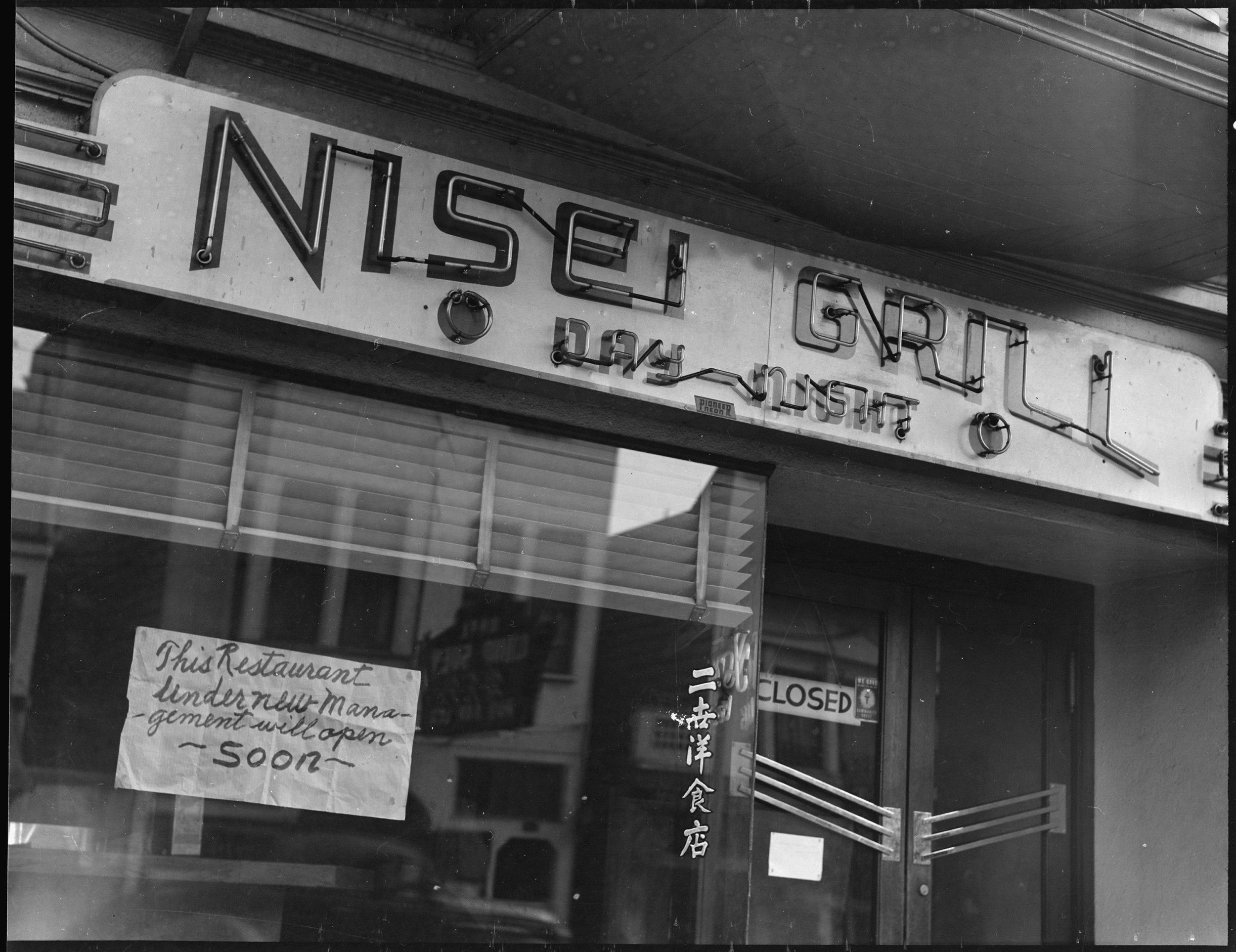Japanese Internment Camps during World War II
Weighing the Evidence
All documents and text associated with this activity are printed below, followed by a worksheet for student responses.Introduction
Study the documents and pictures associated with Japanese internment camps in the United States during World War II. Does it show a positive or negative effect of these camps? (There are more documents than room on the scale...this means you must pick the ones that you feel best represents the positive or negative effects.)Name:
Class:
Class:
Worksheet
Japanese Internment Camps during World War II
Weighing the Evidence
Examine the documents and text included in this activity. Consider how each document does or does not support two opposing interpretations or conclusions. Fill in the topic or interpretations if they are not provided. To show how the documents support the different interpretations, enter the corresponding document number into the boxes near the interpretation. Write your conclusion response in the space provided. Interpretation 1
Japanese internment camps had a positive effect on the United States during World War II.
Japanese internment camps had a positive effect on the United States during World War II.
What effect, if any, did Japanese internment camps have on the United States during World War II?
Interpretation 2
Japanese internment camps had a negative effect on the United States during World War II.
Japanese internment camps had a negative effect on the United States during World War II.
1
Activity Element
Japanese near trains during Relocation
Page 1
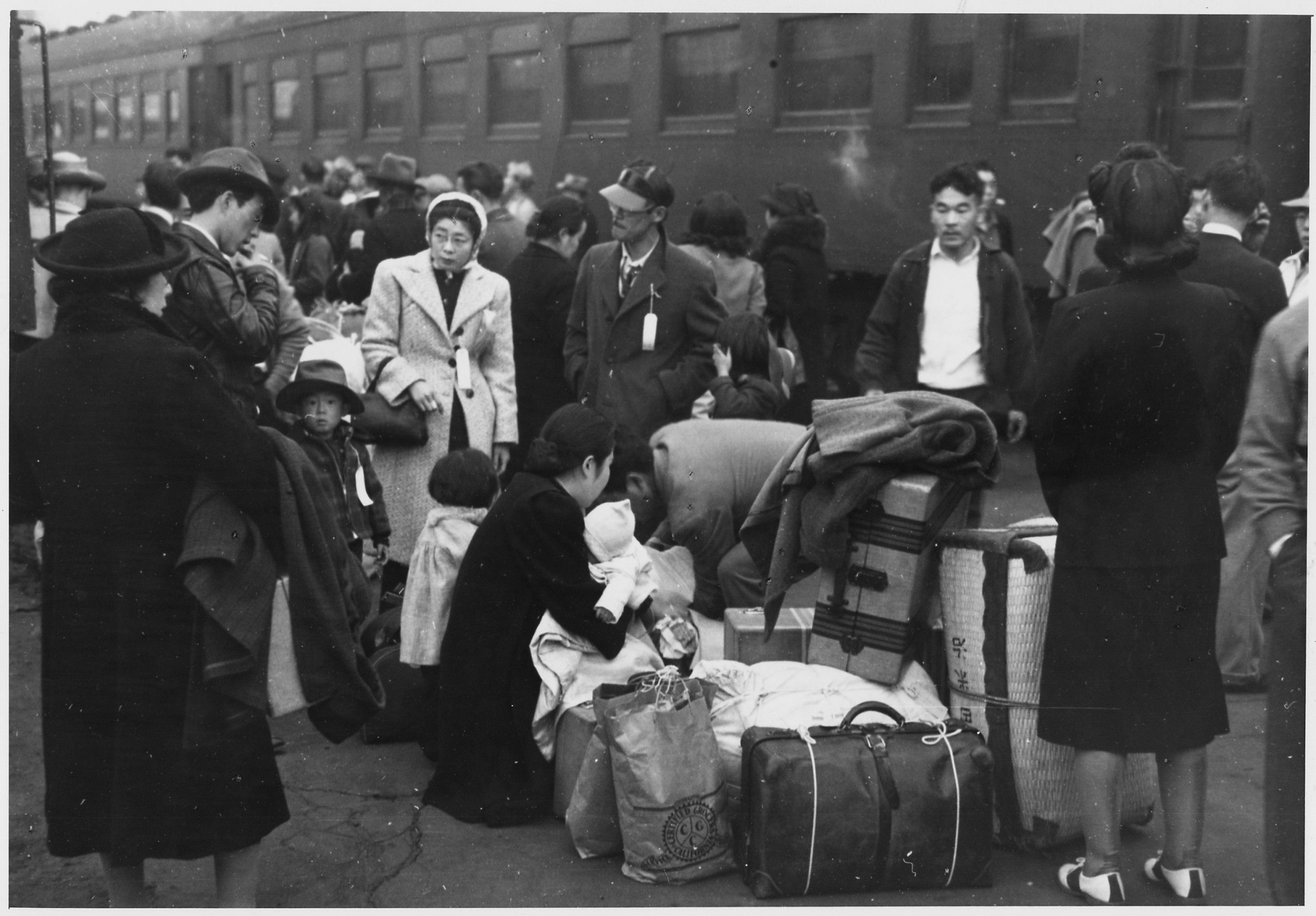
2
Activity Element
News release, Transfer of 26 Japanese aliens...
Page 1

3
Activity Element
"America, Commercial Fish Boat" (Minezo Araki)
Page 1
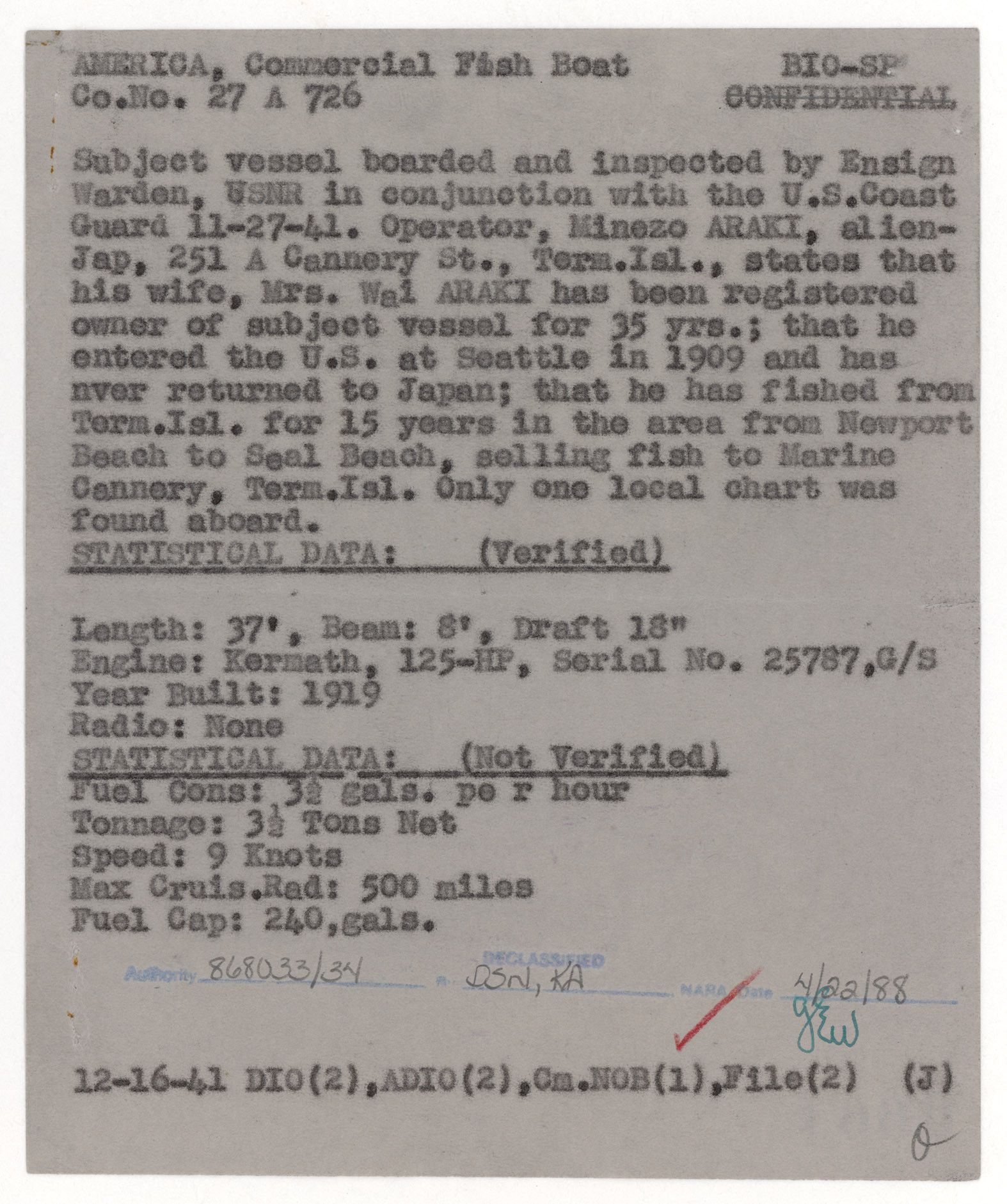
4
Activity Element
"America, Commercial Fish Boat" (Minezo Araki)
Page 2

5
Activity Element
"America, Commercial Fish Boat" (Minezo Araki)
Page 3

6
Activity Element
"America, Commercial Fish Boat" (Minezo Araki)
Page 4

7
Activity Element
"America, Commercial Fish Boat" (Minezo Araki)
Page 5
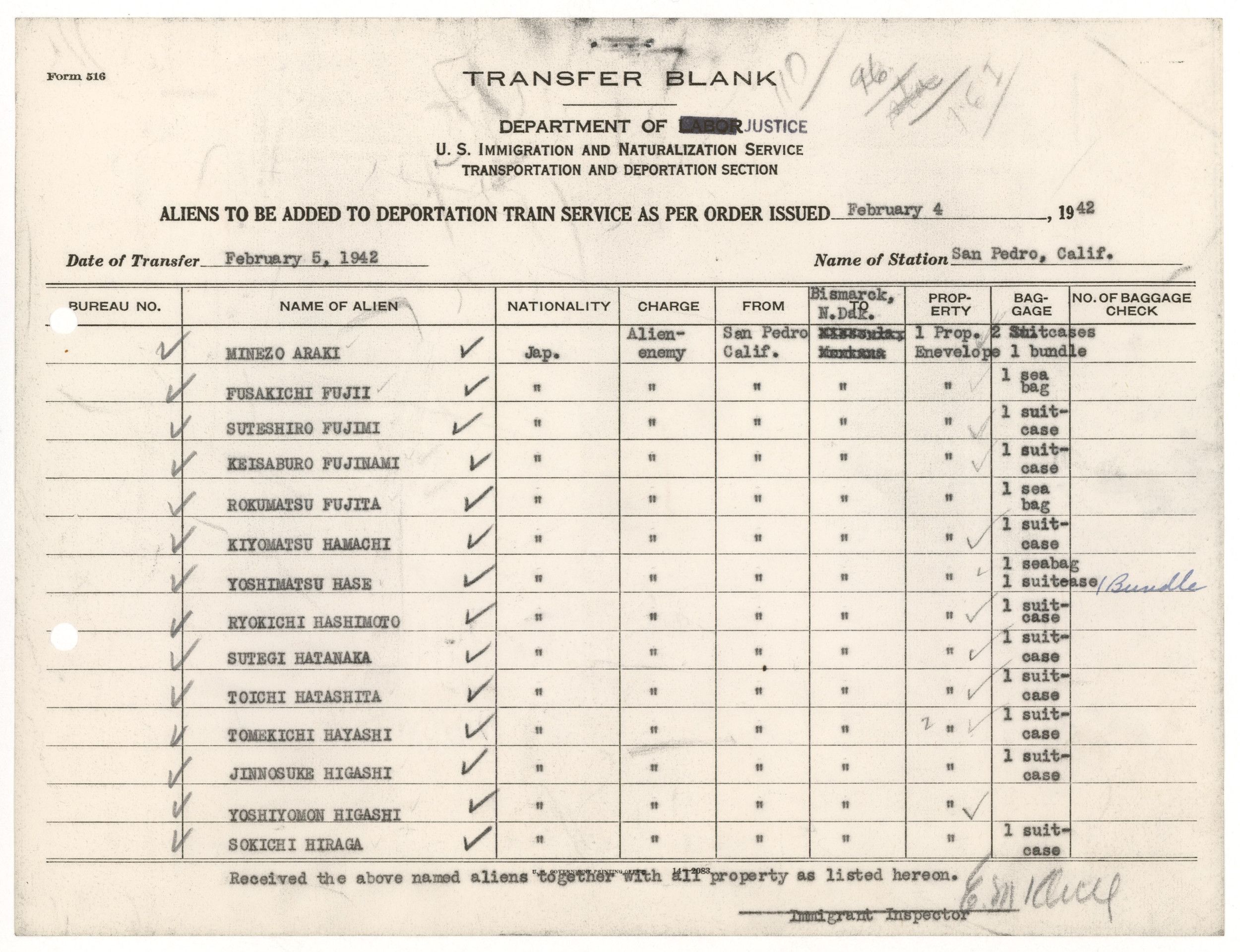
8
Activity Element
Authorization for Return of Filipino to Manila, Philippine Islands
Page 1

9
Activity Element
Authorization for Return of Filipino to Manila, Philippine Islands
Page 2
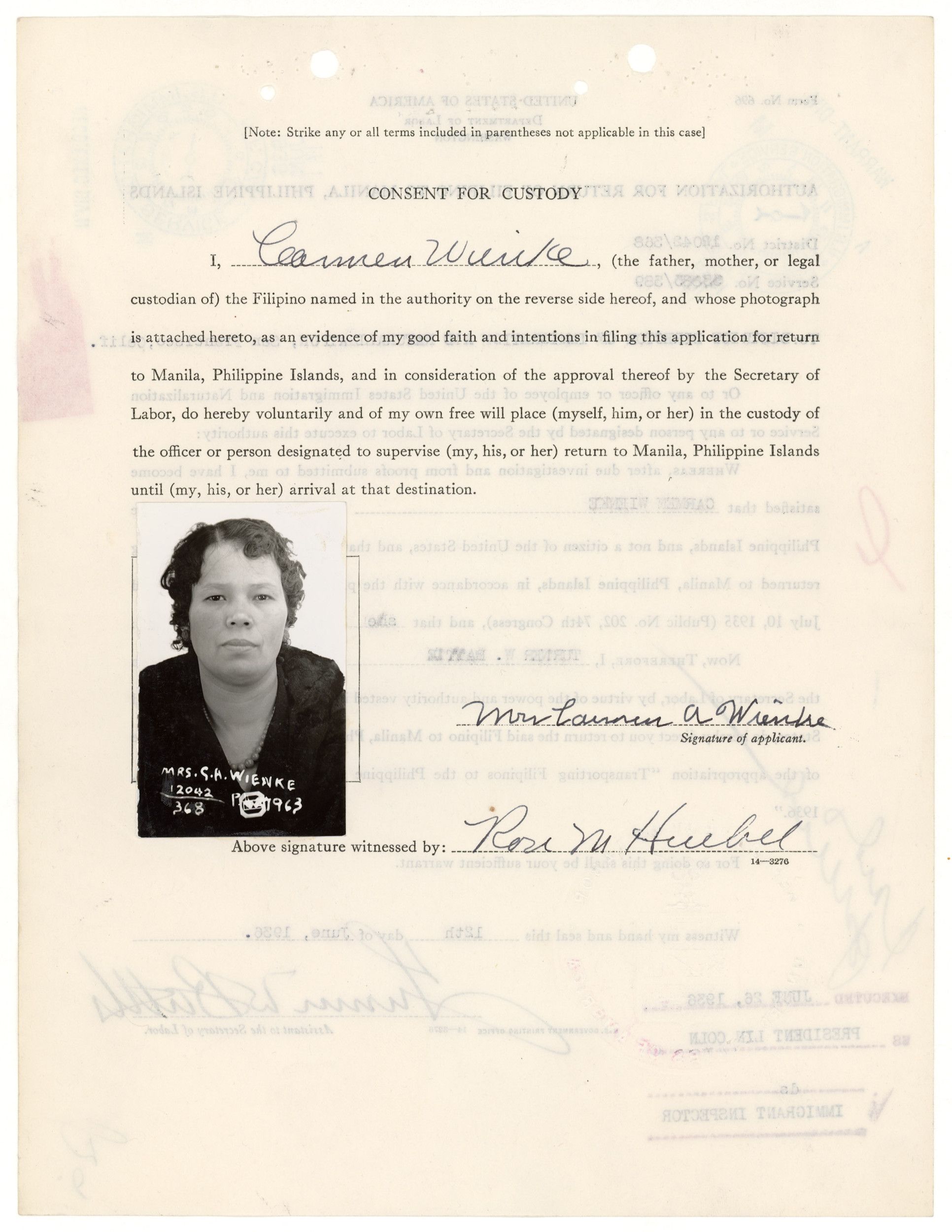
10
Activity Element
Barriers and Passes
Page 1

11
Activity Element
"Congress Should Compensate Those Wronged" - Commentary by Kiyoshi Okamoto to fellow Heart Mountain internees regarding federal court decision on Korematsu vs. U.S
Page 1

12
Activity Element
Demurrer to Information, filed June 20, 1942 (Docket filing 9)
Page 1

13
Activity Element
Demurrer to Information, filed June 20, 1942 (Docket filing 9)
Page 2
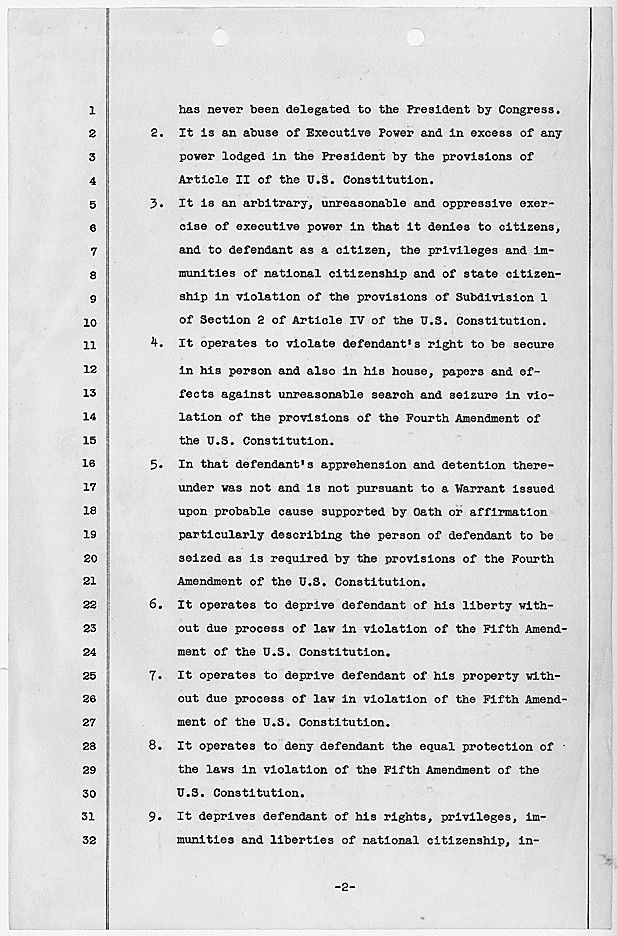
14
Activity Element
Demurrer to Information, filed June 20, 1942 (Docket filing 9)
Page 3
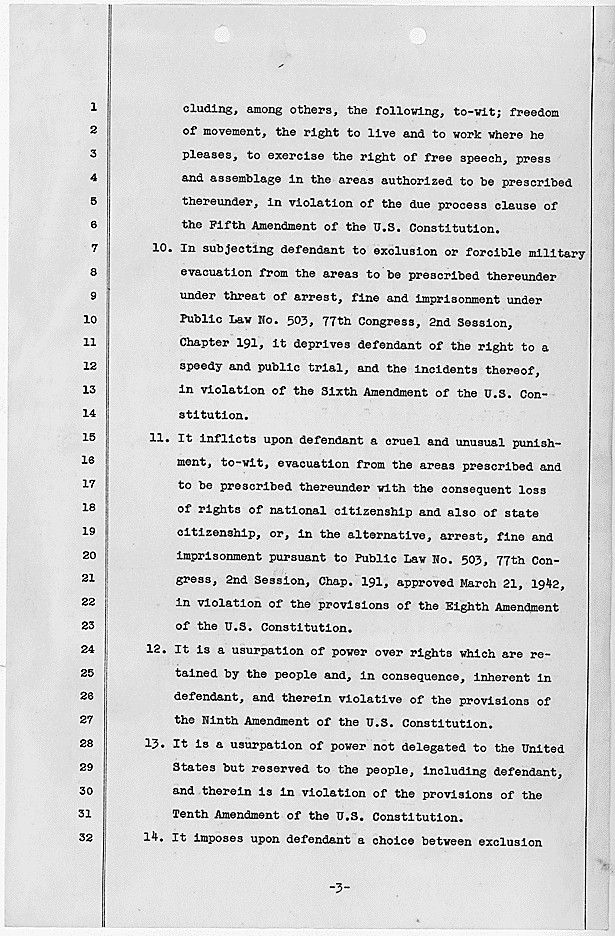
15
Activity Element
An Act of March 21, 1942, Public Law 77-503, 56 STAT 173, to Provide a Penalty for Violation of Restrictions or Orders with Respect to Persons Entering, Remaining in, Leaving, or Committing Any Act in Military Areas or Zones
Page 1
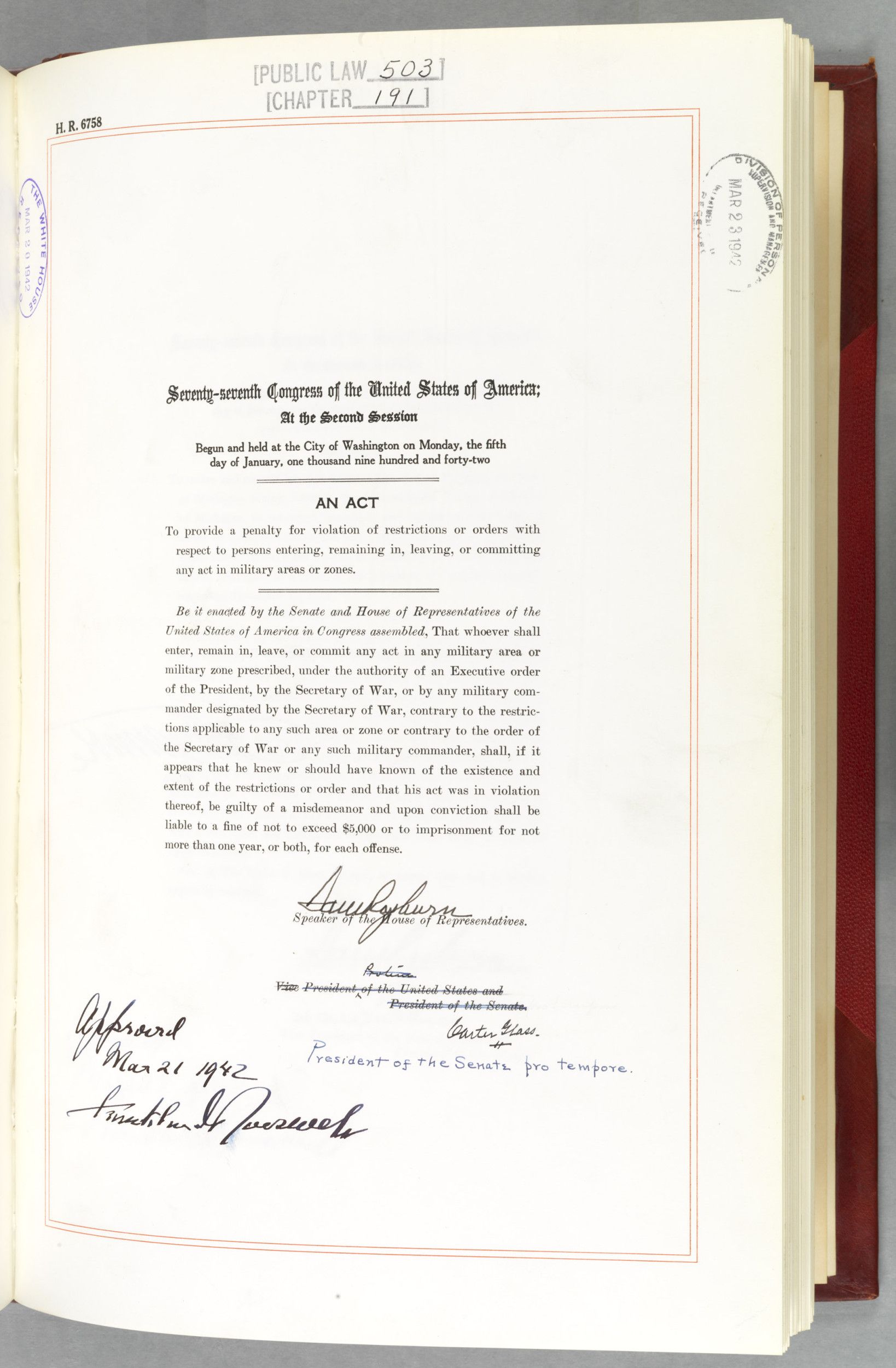
16
Activity Element
Executive Order 9066 dated February 19, 1942, in which President Franklin D. Roosevelt Authorizes the Secretary of War to Prescribe Military Areas
Page 1
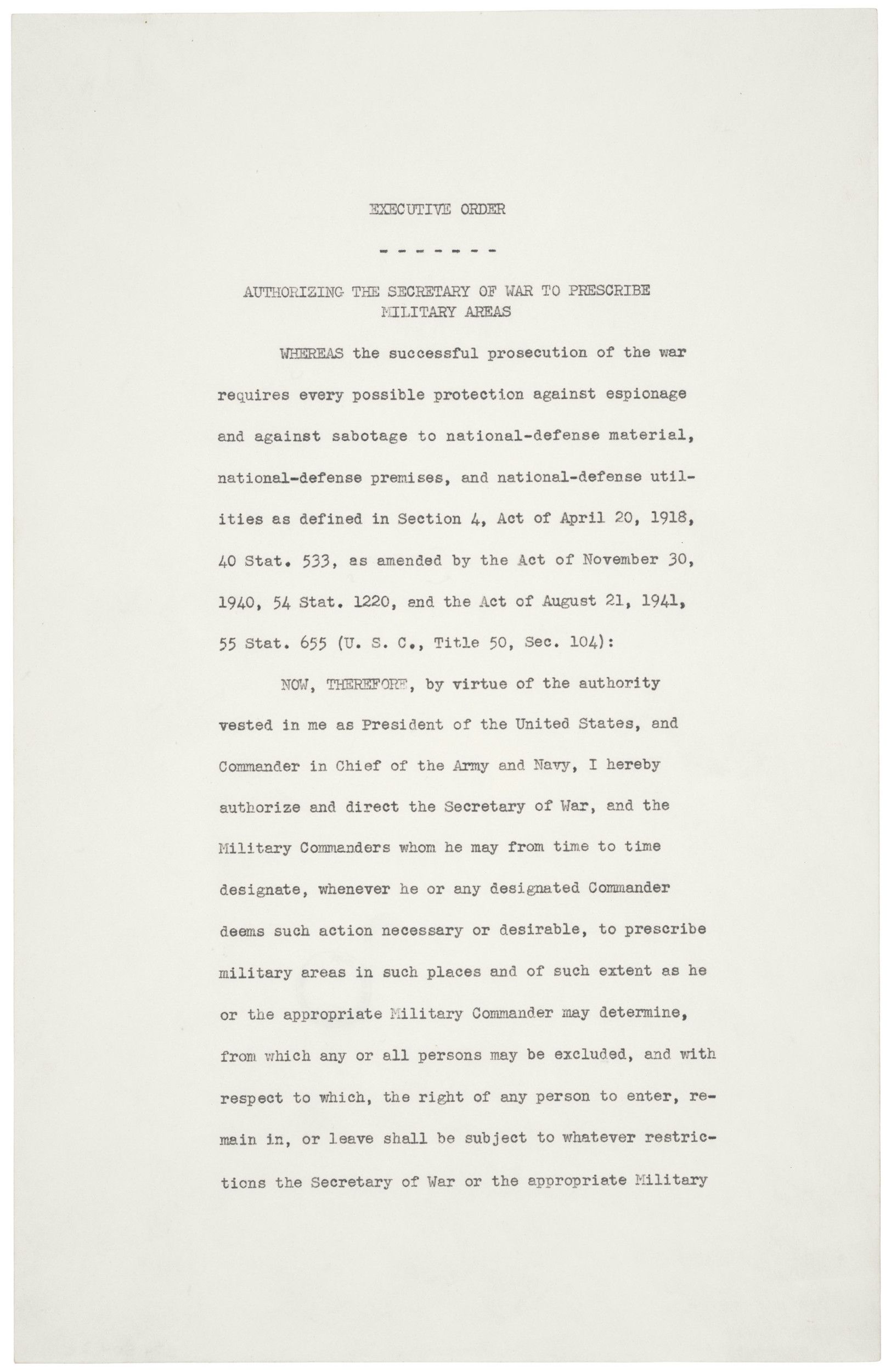
17
Activity Element
Executive Order 9066 dated February 19, 1942, in which President Franklin D. Roosevelt Authorizes the Secretary of War to Prescribe Military Areas
Page 2

18
Activity Element
Executive Order 9066 dated February 19, 1942, in which President Franklin D. Roosevelt Authorizes the Secretary of War to Prescribe Military Areas
Page 3

19
Activity Element
Final Accountability Roster of Residents at Manzanar Relocation Camp
Page 1

20
Activity Element
Florin, California. Two of the nine American soldiers of Japanese ancestry who have returned to the...
Page 1
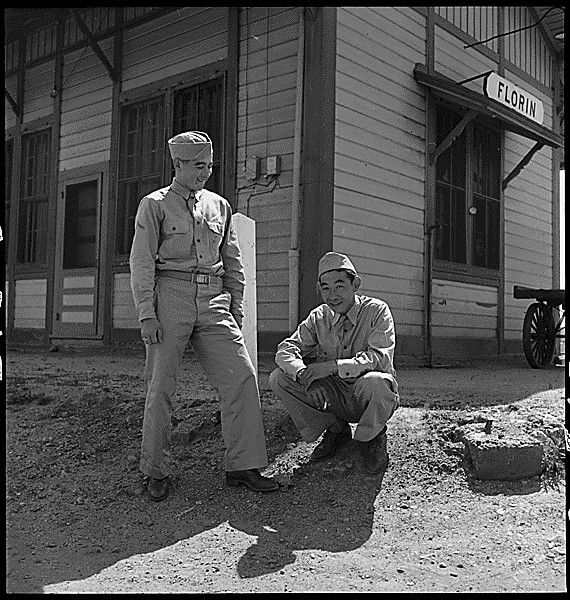
21
Activity Element
Hayward, California. Two children of the Mochida family who, with their parents, are awaiting evacuation . . .
Page 1
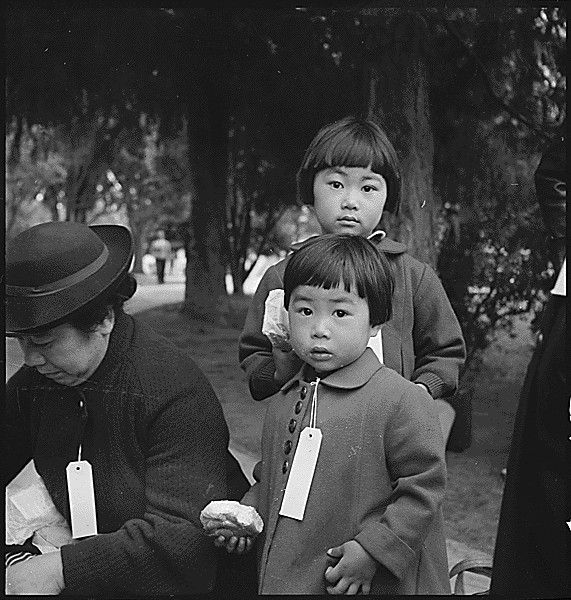
22
Activity Element
Letter from George Katsumi Kodama to Seattle Draft Board
Page 1

23
Activity Element
Letter from Rocky Shimpo editor James Omura to former Heart Mountain internee Kiyoshi Okamoto, who had recently been moved to the internment camp at Tule Lake, California
Page 1

24
Activity Element
Letter from Rocky Shimpo editor James Omura to former Heart Mountain internee Kiyoshi Okamoto, who had recently been moved to the internment camp at Tule Lake, California
Page 2
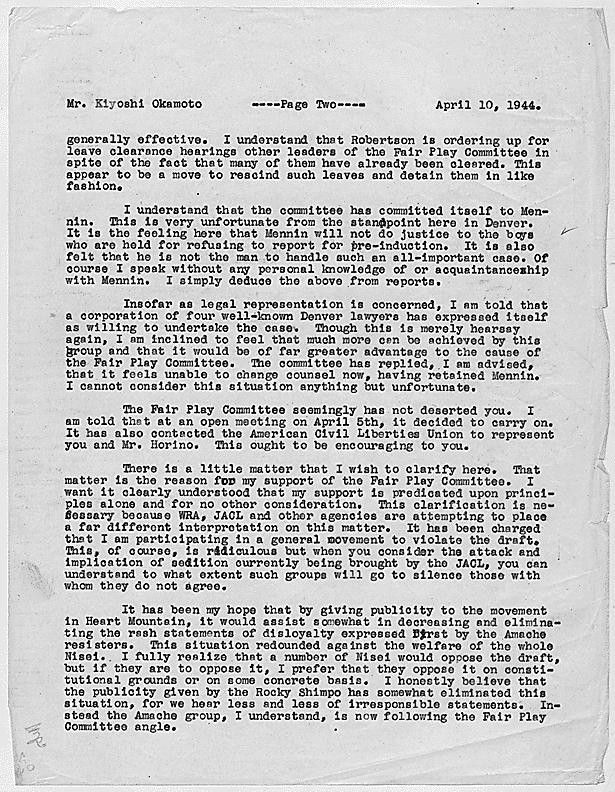
25
Activity Element
Letter from Rocky Shimpo editor James Omura to former Heart Mountain internee Kiyoshi Okamoto, who had recently been moved to the internment camp at Tule Lake, California
Page 3

26
Activity Element
Los Angeles, California. Mr. and Mrs. K. Tseri have closed their drugstore in preparation for the. . .
Page 1
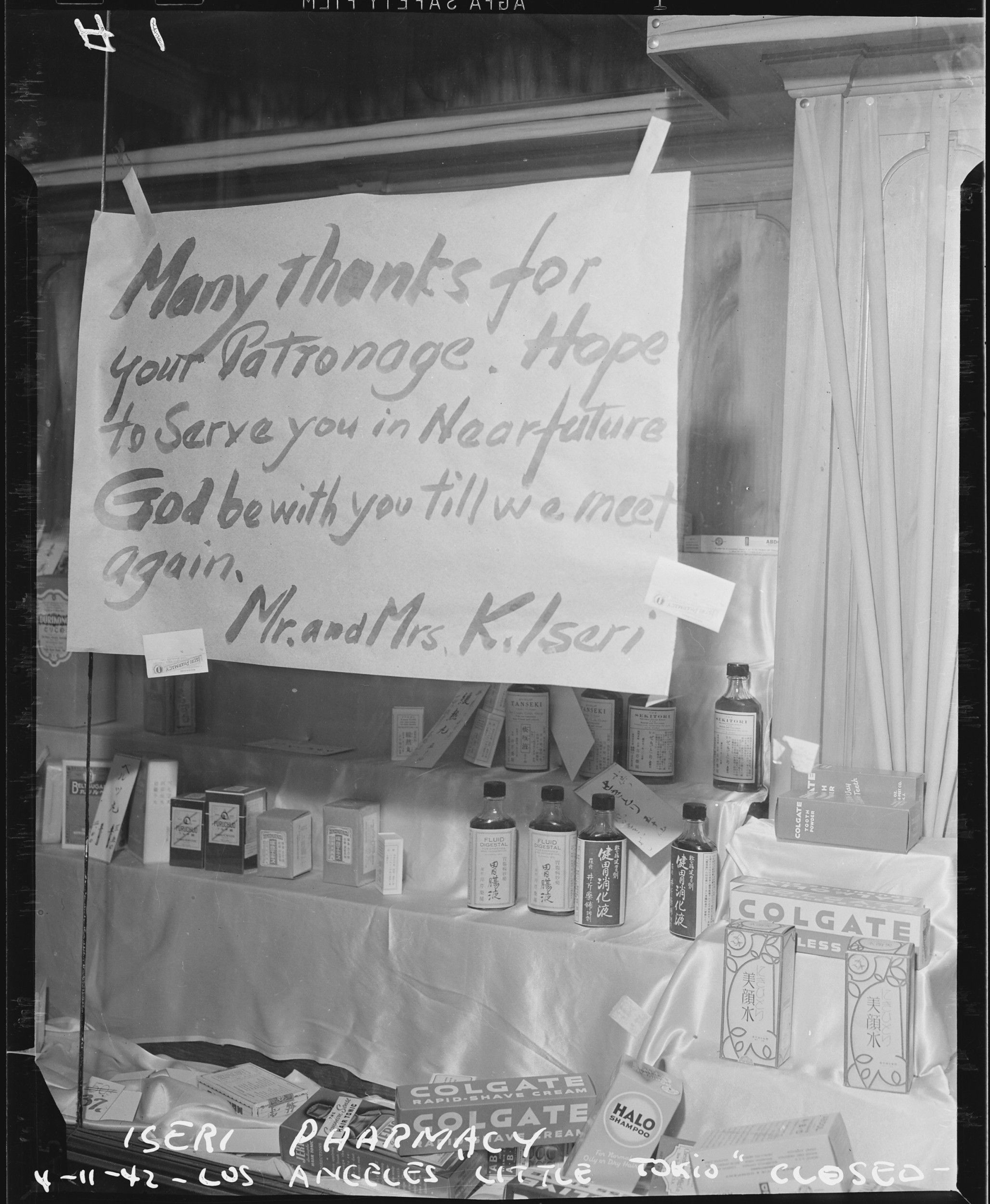
27
Activity Element
Manzanar Free Press for Wednesday, Aug. 12, 1942
Page 1

28
Activity Element
Manzanar Relocation Center, Manzanar, California.
Page 1

29
Activity Element
Newspaper article from Rocky Shimpo: "Camp Disturbance Pending"
Page 1
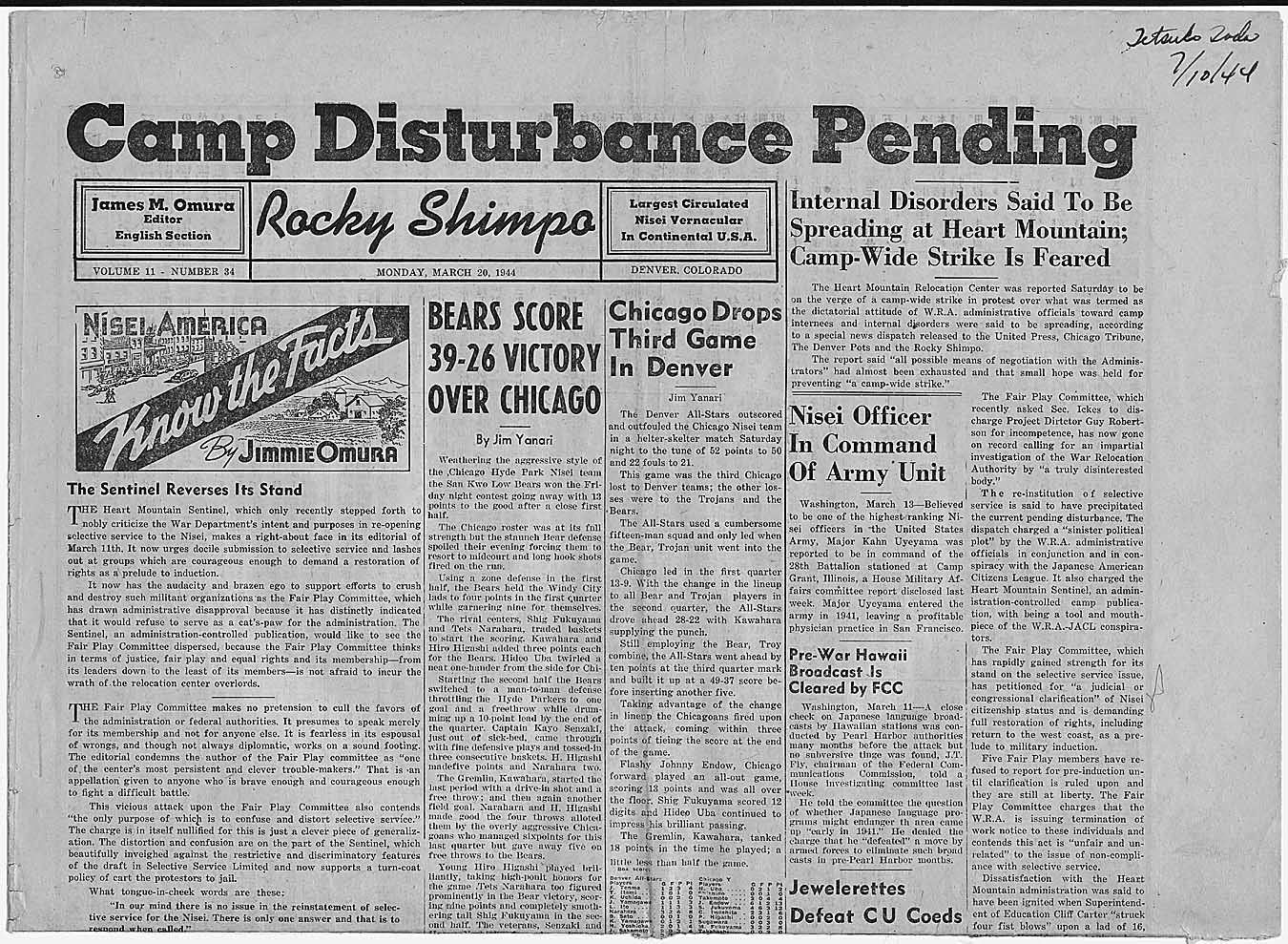
30
Activity Element
Order of Judgment and Sentence
Page 1

31
Activity Element
Order of Judgment and Sentence
Page 2

32
Activity Element
Photograph of Members of the Mochida Family Awaiting Evacuation
Page 1

33
Activity Element
Relocating a People
Page 1

34
Activity Element
San Francisco, California. Flag of allegiance pledge at Raphael Weill Public School, Geary and Buch . . .
Page 1
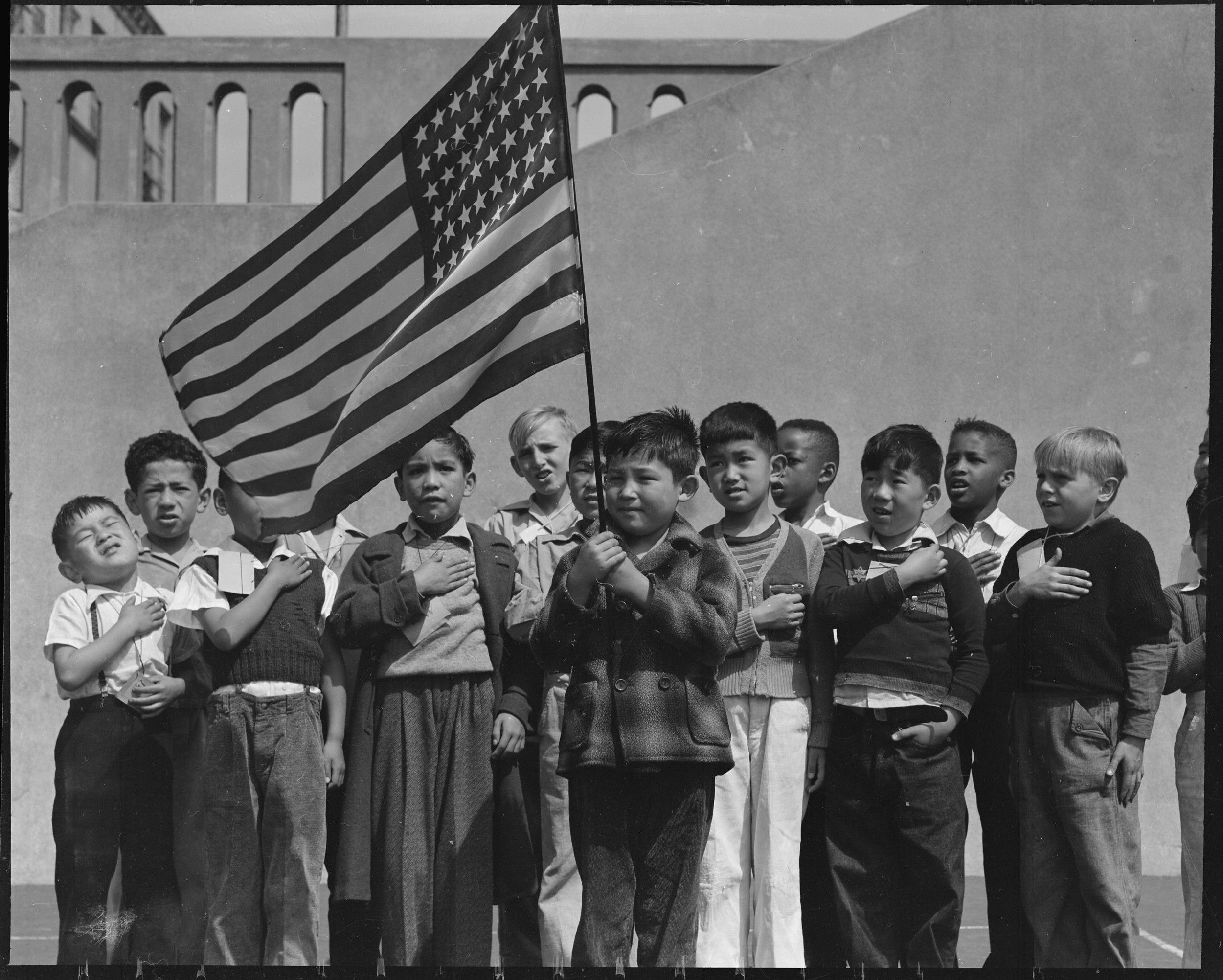
35
Activity Element
San Francisco, California. This restaurant, named "Nisei" after second- generation children born in . . .
Page 2

Conclusion
Japanese Internment Camps during World War II
Weighing the Evidence
Pick a newspaper:- Honolulu Star-Bulletin
- New York Times
- The Boston Post
- Daily News, Los Angeles
You will then assume the role of someone who lived in the United States in the 1940s. You have just experienced the Pearl Harbor attack (12.07.1941) and FDR has issued Executive Order 9066 (02.19.1942). You will write a letter to the editor of one of the above newspapers expressing your feelings about the need for E.O. 9066. You will need to address and explain at least 3 reasons either supporting the need or 3 reasons you're against it. You will also need to identify at least counter-argument and give your rebuttal.
Your Response
Document
Japanese near trains during Relocation
1942
This primary source comes from the Collection FDR-PHOCO: Franklin D. Roosevelt Library Public Domain Photographs.
National Archives Identifier: 195538
Full Citation: Japanese near trains during Relocation; 1942; Franklin D. Roosevelt Library Public Domain Photographs, 1882 - 1962; Collection FDR-PHOCO: Franklin D. Roosevelt Library Public Domain Photographs, ; Franklin D. Roosevelt Library, Hyde Park, NY. [Online Version, https://www.docsteach.org/documents/document/japanese-trains-relocation, April 25, 2024]Japanese near trains during Relocation
Page 1

Document
News release, Transfer of 26 Japanese aliens...
7/9/1944
This document was identified by teachers in our Primarily Teaching 2016 Summer Workshop at the Truman Library.
This primary source comes from the Collection HST-PN: Philleo Nash Papers.
National Archives Identifier: 40019806
Full Citation: News release, Transfer of 26 Japanese aliens...; 7/9/1944; Minorities-Japanese-War Relocation Authority-News Stories, 1943-1944; White House Files, 1936 - 1953; Collection HST-PN: Philleo Nash Papers, ; Harry S. Truman Library, Independence, MO. [Online Version, https://www.docsteach.org/documents/document/press-release-transfer-26-japanese-aliens, April 25, 2024]News release, Transfer of 26 Japanese aliens...
Page 1

Document
Intelligence Report on Vessel 27-A-726, America
11/27/1941
After the Japanese attack on Pearl Harbor, Hawaii, on December 7, 1941, Minezo Araki, a Japanese fisherman who had been living in the United States for more than 30 years, went from being an alien to being an enemy alien.
Minezo had come to the United States in 1908, landing in Seattle and working as a farmer and a fisherman off the coast of Southern California. He married Wai Araki and together they raised her two children from a previous marriage and a daughter from his former marriage.
Even before December 7, as relations between the United States and Japan deteriorated, Japanese aliens were subject to increasing scrutiny by law enforcement and military officials. With such suspicions, the U.S. Navy and Coast Guard boarded Araki’s fishing boat, America, on November 27, 1941, and searched it for hidden radios and charts.
After war broke out, he was evacuated under the Enemy Alien Act to the San Pedro, California, assembly center. On February 4, 1942, he was sent to a camp for Japanese enemy aliens and German prisoners of war, near Bismarck, North Dakota. In July 1942, he joined the rest of his family in the Poston, Arizona, internment camp.
When the war turned in favor of the United States, Minezo and his family were allowed to leave Poston in the spring of 1943. They returned to California. Araki remained in the United States until his death in 1965.
Minezo had come to the United States in 1908, landing in Seattle and working as a farmer and a fisherman off the coast of Southern California. He married Wai Araki and together they raised her two children from a previous marriage and a daughter from his former marriage.
Even before December 7, as relations between the United States and Japan deteriorated, Japanese aliens were subject to increasing scrutiny by law enforcement and military officials. With such suspicions, the U.S. Navy and Coast Guard boarded Araki’s fishing boat, America, on November 27, 1941, and searched it for hidden radios and charts.
After war broke out, he was evacuated under the Enemy Alien Act to the San Pedro, California, assembly center. On February 4, 1942, he was sent to a camp for Japanese enemy aliens and German prisoners of war, near Bismarck, North Dakota. In July 1942, he joined the rest of his family in the Poston, Arizona, internment camp.
When the war turned in favor of the United States, Minezo and his family were allowed to leave Poston in the spring of 1943. They returned to California. Araki remained in the United States until his death in 1965.
This primary source comes from the Records of Naval Districts and Shore Establishments.
National Archives Identifier: 41050002
Full Citation: Intelligence Report on Vessel 27-A-726, America; 11/27/1941; A8-5 Espionage; Central Subject Files, 1940 - 1971; Records of Naval Districts and Shore Establishments, ; National Archives at Riverside, Perris, CA. [Online Version, https://www.docsteach.org/documents/document/boat-america, April 25, 2024]Intelligence Report on Vessel 27-A-726, America
Page 1
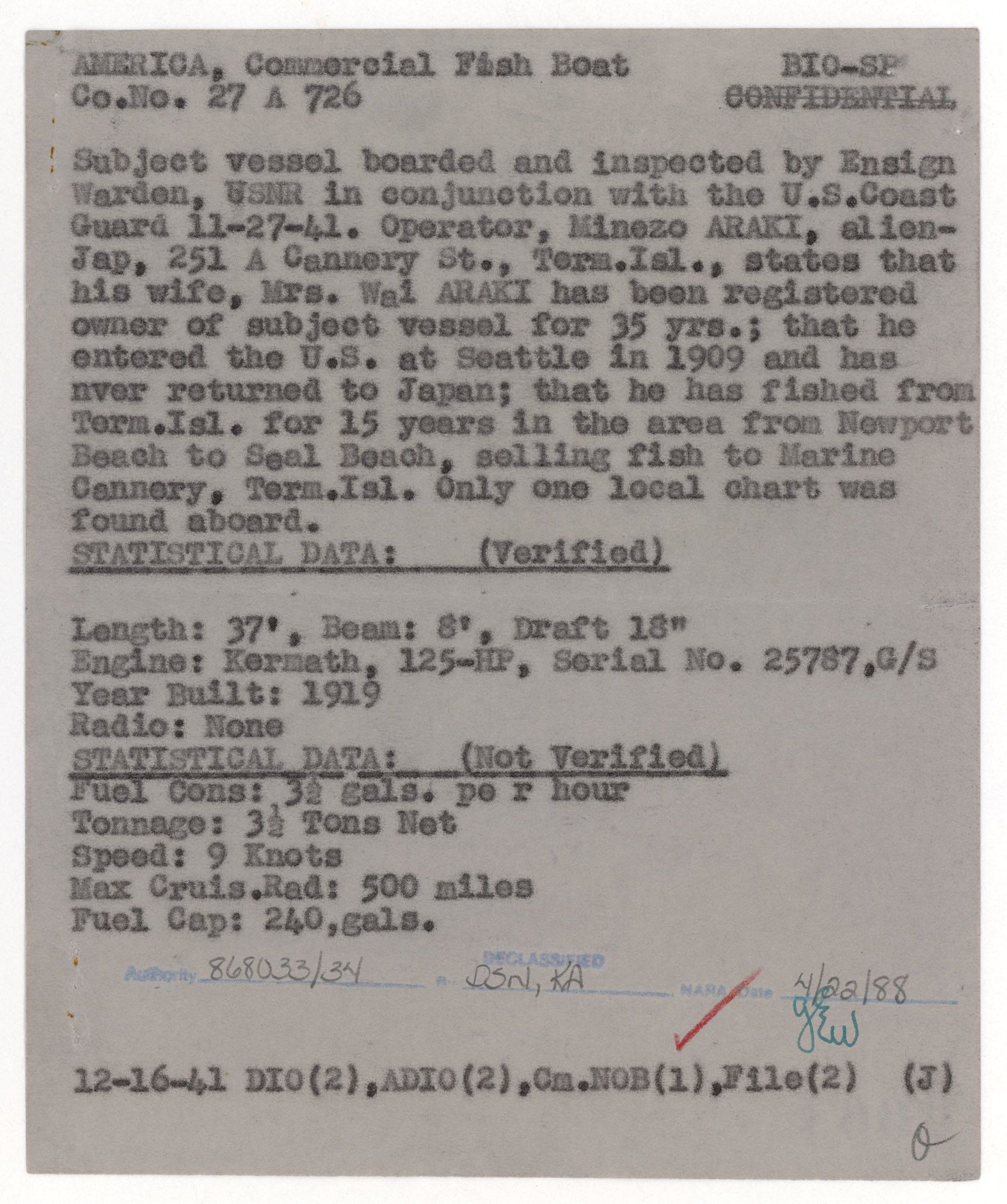
Intelligence Report on Vessel 27-A-726, America
Page 2
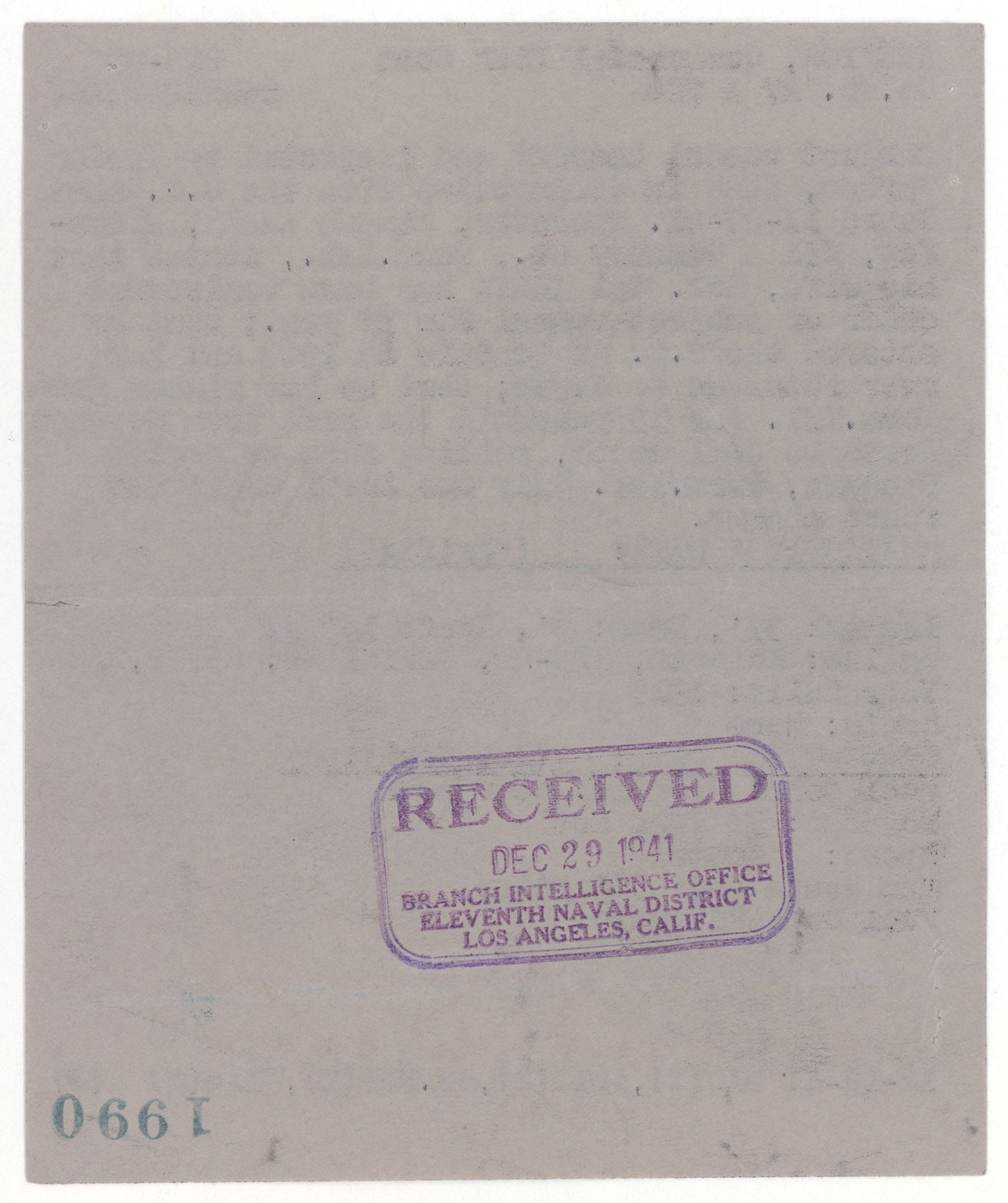
Intelligence Report on Vessel 27-A-726, America
Page 3
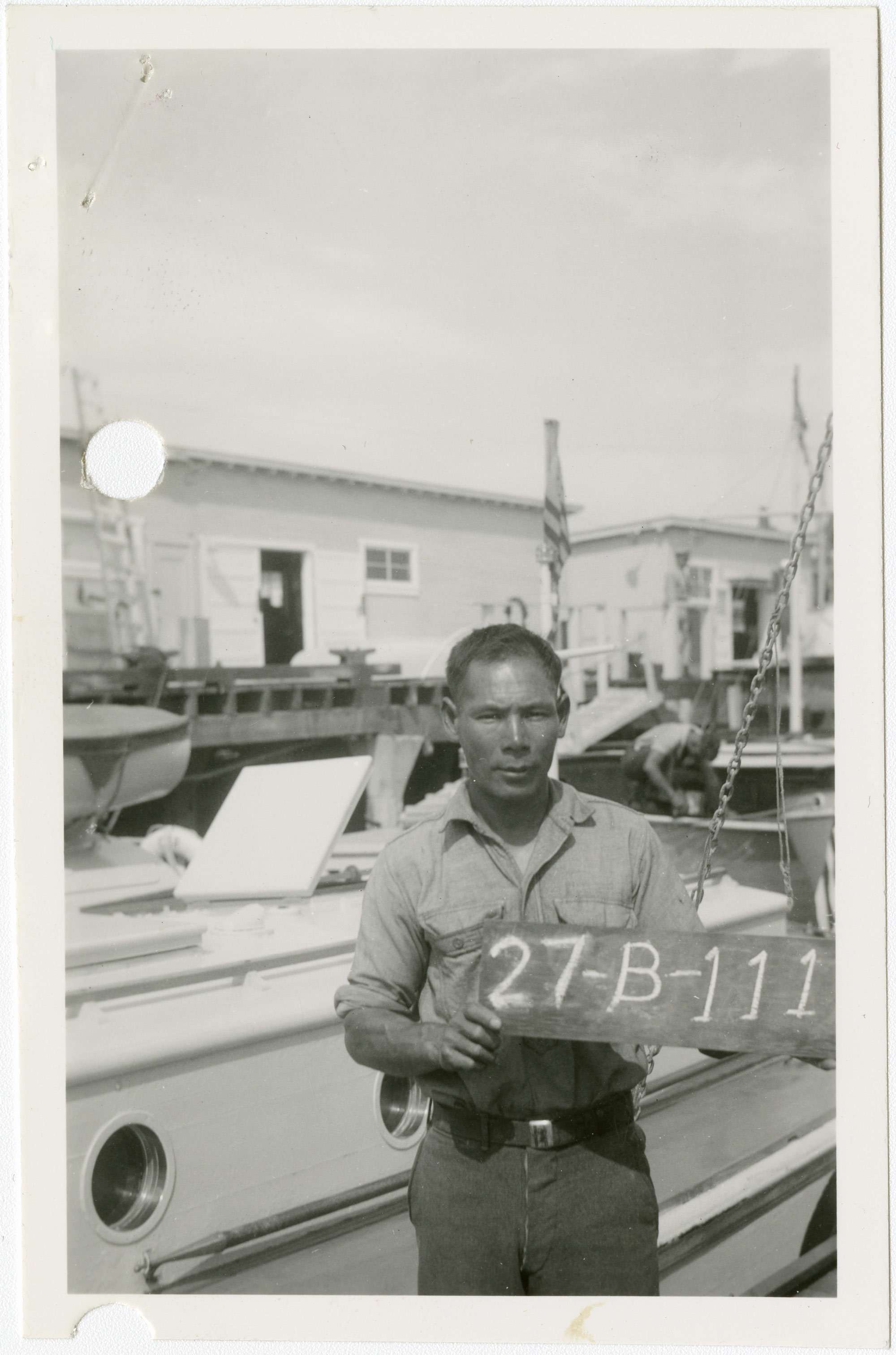
Intelligence Report on Vessel 27-A-726, America
Page 4
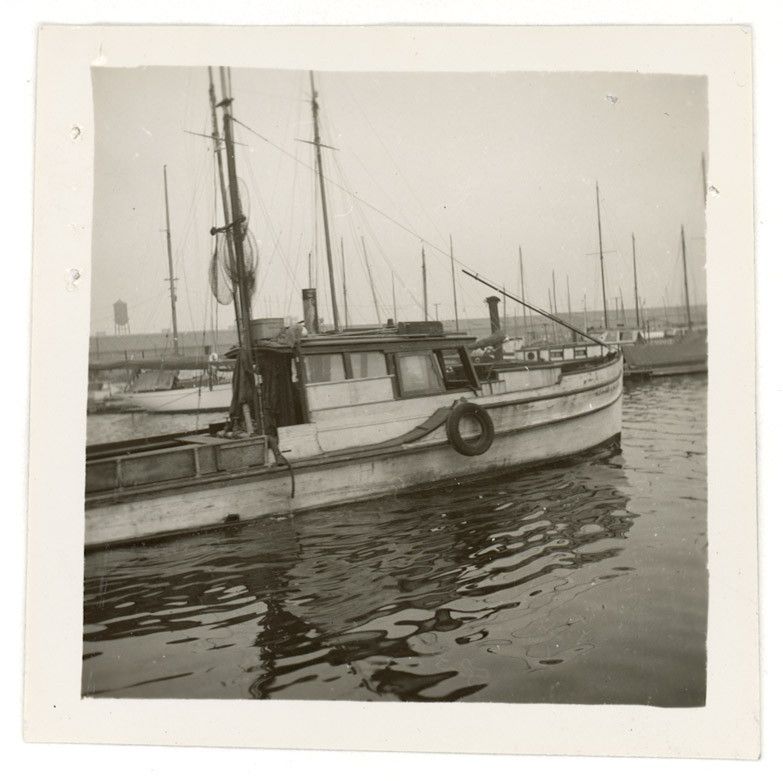
Intelligence Report on Vessel 27-A-726, America
Page 5
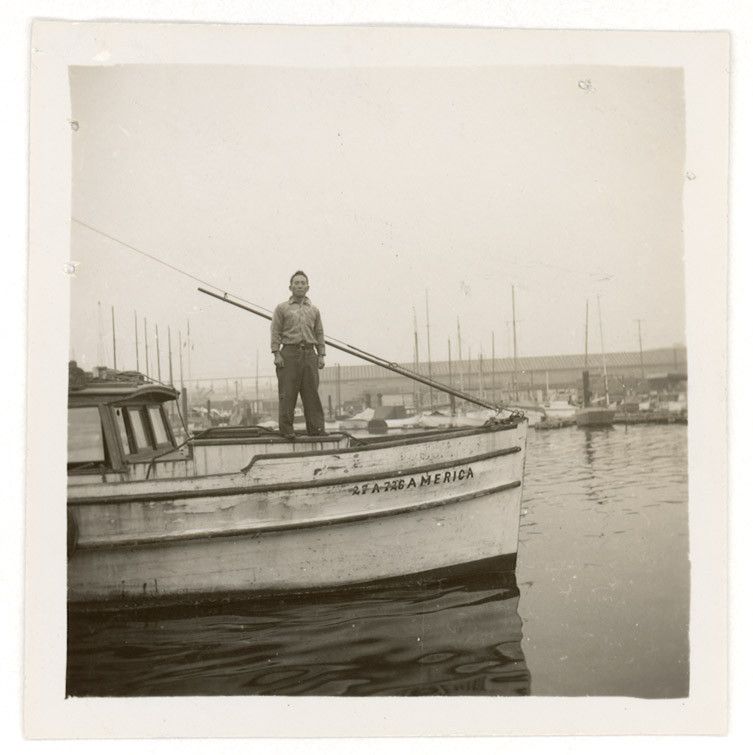
Intelligence Report on Vessel 27-A-726, America
Page 6
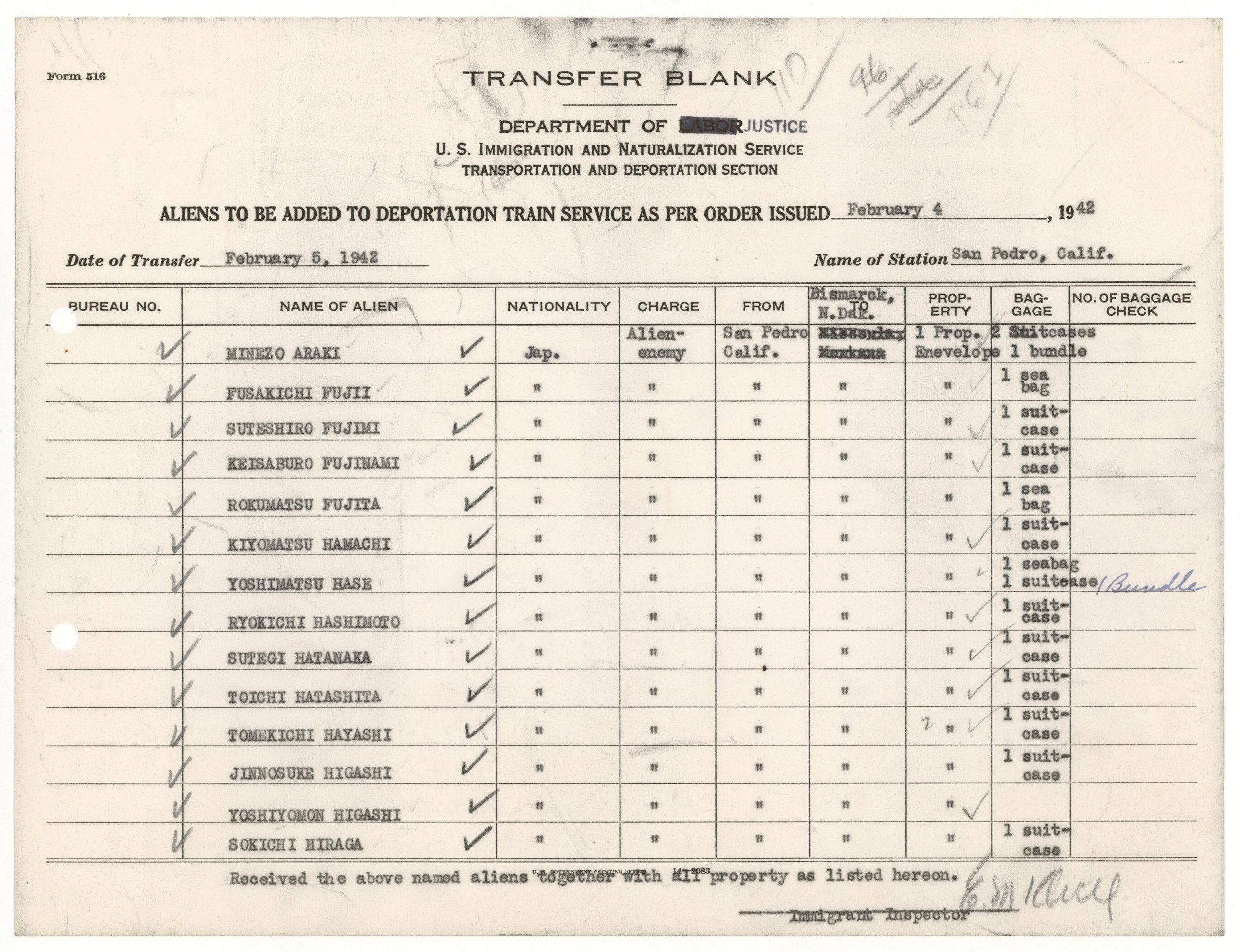
Document
Intelligence Report on Vessel 27-A-726, America
11/27/1941
After the Japanese attack on Pearl Harbor, Hawaii, on December 7, 1941, Minezo Araki, a Japanese fisherman who had been living in the United States for more than 30 years, went from being an alien to being an enemy alien.
Minezo had come to the United States in 1908, landing in Seattle and working as a farmer and a fisherman off the coast of Southern California. He married Wai Araki and together they raised her two children from a previous marriage and a daughter from his former marriage.
Even before December 7, as relations between the United States and Japan deteriorated, Japanese aliens were subject to increasing scrutiny by law enforcement and military officials. With such suspicions, the U.S. Navy and Coast Guard boarded Araki’s fishing boat, America, on November 27, 1941, and searched it for hidden radios and charts.
After war broke out, he was evacuated under the Enemy Alien Act to the San Pedro, California, assembly center. On February 4, 1942, he was sent to a camp for Japanese enemy aliens and German prisoners of war, near Bismarck, North Dakota. In July 1942, he joined the rest of his family in the Poston, Arizona, internment camp.
When the war turned in favor of the United States, Minezo and his family were allowed to leave Poston in the spring of 1943. They returned to California. Araki remained in the United States until his death in 1965.
Minezo had come to the United States in 1908, landing in Seattle and working as a farmer and a fisherman off the coast of Southern California. He married Wai Araki and together they raised her two children from a previous marriage and a daughter from his former marriage.
Even before December 7, as relations between the United States and Japan deteriorated, Japanese aliens were subject to increasing scrutiny by law enforcement and military officials. With such suspicions, the U.S. Navy and Coast Guard boarded Araki’s fishing boat, America, on November 27, 1941, and searched it for hidden radios and charts.
After war broke out, he was evacuated under the Enemy Alien Act to the San Pedro, California, assembly center. On February 4, 1942, he was sent to a camp for Japanese enemy aliens and German prisoners of war, near Bismarck, North Dakota. In July 1942, he joined the rest of his family in the Poston, Arizona, internment camp.
When the war turned in favor of the United States, Minezo and his family were allowed to leave Poston in the spring of 1943. They returned to California. Araki remained in the United States until his death in 1965.
This primary source comes from the Records of Naval Districts and Shore Establishments.
National Archives Identifier: 41050002
Full Citation: Intelligence Report on Vessel 27-A-726, America; 11/27/1941; A8-5 Espionage; Central Subject Files, 1940 - 1971; Records of Naval Districts and Shore Establishments, ; National Archives at Riverside, Perris, CA. [Online Version, https://www.docsteach.org/documents/document/boat-america, April 25, 2024]Intelligence Report on Vessel 27-A-726, America
Page 1

Intelligence Report on Vessel 27-A-726, America
Page 2

Intelligence Report on Vessel 27-A-726, America
Page 3

Intelligence Report on Vessel 27-A-726, America
Page 4

Intelligence Report on Vessel 27-A-726, America
Page 5

Intelligence Report on Vessel 27-A-726, America
Page 6

Document
Intelligence Report on Vessel 27-A-726, America
11/27/1941
After the Japanese attack on Pearl Harbor, Hawaii, on December 7, 1941, Minezo Araki, a Japanese fisherman who had been living in the United States for more than 30 years, went from being an alien to being an enemy alien.
Minezo had come to the United States in 1908, landing in Seattle and working as a farmer and a fisherman off the coast of Southern California. He married Wai Araki and together they raised her two children from a previous marriage and a daughter from his former marriage.
Even before December 7, as relations between the United States and Japan deteriorated, Japanese aliens were subject to increasing scrutiny by law enforcement and military officials. With such suspicions, the U.S. Navy and Coast Guard boarded Araki’s fishing boat, America, on November 27, 1941, and searched it for hidden radios and charts.
After war broke out, he was evacuated under the Enemy Alien Act to the San Pedro, California, assembly center. On February 4, 1942, he was sent to a camp for Japanese enemy aliens and German prisoners of war, near Bismarck, North Dakota. In July 1942, he joined the rest of his family in the Poston, Arizona, internment camp.
When the war turned in favor of the United States, Minezo and his family were allowed to leave Poston in the spring of 1943. They returned to California. Araki remained in the United States until his death in 1965.
Minezo had come to the United States in 1908, landing in Seattle and working as a farmer and a fisherman off the coast of Southern California. He married Wai Araki and together they raised her two children from a previous marriage and a daughter from his former marriage.
Even before December 7, as relations between the United States and Japan deteriorated, Japanese aliens were subject to increasing scrutiny by law enforcement and military officials. With such suspicions, the U.S. Navy and Coast Guard boarded Araki’s fishing boat, America, on November 27, 1941, and searched it for hidden radios and charts.
After war broke out, he was evacuated under the Enemy Alien Act to the San Pedro, California, assembly center. On February 4, 1942, he was sent to a camp for Japanese enemy aliens and German prisoners of war, near Bismarck, North Dakota. In July 1942, he joined the rest of his family in the Poston, Arizona, internment camp.
When the war turned in favor of the United States, Minezo and his family were allowed to leave Poston in the spring of 1943. They returned to California. Araki remained in the United States until his death in 1965.
This primary source comes from the Records of Naval Districts and Shore Establishments.
National Archives Identifier: 41050002
Full Citation: Intelligence Report on Vessel 27-A-726, America; 11/27/1941; A8-5 Espionage; Central Subject Files, 1940 - 1971; Records of Naval Districts and Shore Establishments, ; National Archives at Riverside, Perris, CA. [Online Version, https://www.docsteach.org/documents/document/boat-america, April 25, 2024]Intelligence Report on Vessel 27-A-726, America
Page 1

Intelligence Report on Vessel 27-A-726, America
Page 2

Intelligence Report on Vessel 27-A-726, America
Page 3

Intelligence Report on Vessel 27-A-726, America
Page 4

Intelligence Report on Vessel 27-A-726, America
Page 5

Intelligence Report on Vessel 27-A-726, America
Page 6

Document
Intelligence Report on Vessel 27-A-726, America
11/27/1941
After the Japanese attack on Pearl Harbor, Hawaii, on December 7, 1941, Minezo Araki, a Japanese fisherman who had been living in the United States for more than 30 years, went from being an alien to being an enemy alien.
Minezo had come to the United States in 1908, landing in Seattle and working as a farmer and a fisherman off the coast of Southern California. He married Wai Araki and together they raised her two children from a previous marriage and a daughter from his former marriage.
Even before December 7, as relations between the United States and Japan deteriorated, Japanese aliens were subject to increasing scrutiny by law enforcement and military officials. With such suspicions, the U.S. Navy and Coast Guard boarded Araki’s fishing boat, America, on November 27, 1941, and searched it for hidden radios and charts.
After war broke out, he was evacuated under the Enemy Alien Act to the San Pedro, California, assembly center. On February 4, 1942, he was sent to a camp for Japanese enemy aliens and German prisoners of war, near Bismarck, North Dakota. In July 1942, he joined the rest of his family in the Poston, Arizona, internment camp.
When the war turned in favor of the United States, Minezo and his family were allowed to leave Poston in the spring of 1943. They returned to California. Araki remained in the United States until his death in 1965.
Minezo had come to the United States in 1908, landing in Seattle and working as a farmer and a fisherman off the coast of Southern California. He married Wai Araki and together they raised her two children from a previous marriage and a daughter from his former marriage.
Even before December 7, as relations between the United States and Japan deteriorated, Japanese aliens were subject to increasing scrutiny by law enforcement and military officials. With such suspicions, the U.S. Navy and Coast Guard boarded Araki’s fishing boat, America, on November 27, 1941, and searched it for hidden radios and charts.
After war broke out, he was evacuated under the Enemy Alien Act to the San Pedro, California, assembly center. On February 4, 1942, he was sent to a camp for Japanese enemy aliens and German prisoners of war, near Bismarck, North Dakota. In July 1942, he joined the rest of his family in the Poston, Arizona, internment camp.
When the war turned in favor of the United States, Minezo and his family were allowed to leave Poston in the spring of 1943. They returned to California. Araki remained in the United States until his death in 1965.
This primary source comes from the Records of Naval Districts and Shore Establishments.
National Archives Identifier: 41050002
Full Citation: Intelligence Report on Vessel 27-A-726, America; 11/27/1941; A8-5 Espionage; Central Subject Files, 1940 - 1971; Records of Naval Districts and Shore Establishments, ; National Archives at Riverside, Perris, CA. [Online Version, https://www.docsteach.org/documents/document/boat-america, April 25, 2024]Intelligence Report on Vessel 27-A-726, America
Page 1

Intelligence Report on Vessel 27-A-726, America
Page 2

Intelligence Report on Vessel 27-A-726, America
Page 3

Intelligence Report on Vessel 27-A-726, America
Page 4

Intelligence Report on Vessel 27-A-726, America
Page 5

Intelligence Report on Vessel 27-A-726, America
Page 6

Document
Intelligence Report on Vessel 27-A-726, America
11/27/1941
After the Japanese attack on Pearl Harbor, Hawaii, on December 7, 1941, Minezo Araki, a Japanese fisherman who had been living in the United States for more than 30 years, went from being an alien to being an enemy alien.
Minezo had come to the United States in 1908, landing in Seattle and working as a farmer and a fisherman off the coast of Southern California. He married Wai Araki and together they raised her two children from a previous marriage and a daughter from his former marriage.
Even before December 7, as relations between the United States and Japan deteriorated, Japanese aliens were subject to increasing scrutiny by law enforcement and military officials. With such suspicions, the U.S. Navy and Coast Guard boarded Araki’s fishing boat, America, on November 27, 1941, and searched it for hidden radios and charts.
After war broke out, he was evacuated under the Enemy Alien Act to the San Pedro, California, assembly center. On February 4, 1942, he was sent to a camp for Japanese enemy aliens and German prisoners of war, near Bismarck, North Dakota. In July 1942, he joined the rest of his family in the Poston, Arizona, internment camp.
When the war turned in favor of the United States, Minezo and his family were allowed to leave Poston in the spring of 1943. They returned to California. Araki remained in the United States until his death in 1965.
Minezo had come to the United States in 1908, landing in Seattle and working as a farmer and a fisherman off the coast of Southern California. He married Wai Araki and together they raised her two children from a previous marriage and a daughter from his former marriage.
Even before December 7, as relations between the United States and Japan deteriorated, Japanese aliens were subject to increasing scrutiny by law enforcement and military officials. With such suspicions, the U.S. Navy and Coast Guard boarded Araki’s fishing boat, America, on November 27, 1941, and searched it for hidden radios and charts.
After war broke out, he was evacuated under the Enemy Alien Act to the San Pedro, California, assembly center. On February 4, 1942, he was sent to a camp for Japanese enemy aliens and German prisoners of war, near Bismarck, North Dakota. In July 1942, he joined the rest of his family in the Poston, Arizona, internment camp.
When the war turned in favor of the United States, Minezo and his family were allowed to leave Poston in the spring of 1943. They returned to California. Araki remained in the United States until his death in 1965.
This primary source comes from the Records of Naval Districts and Shore Establishments.
National Archives Identifier: 41050002
Full Citation: Intelligence Report on Vessel 27-A-726, America; 11/27/1941; A8-5 Espionage; Central Subject Files, 1940 - 1971; Records of Naval Districts and Shore Establishments, ; National Archives at Riverside, Perris, CA. [Online Version, https://www.docsteach.org/documents/document/boat-america, April 25, 2024]Intelligence Report on Vessel 27-A-726, America
Page 1

Intelligence Report on Vessel 27-A-726, America
Page 2

Intelligence Report on Vessel 27-A-726, America
Page 3

Intelligence Report on Vessel 27-A-726, America
Page 4

Intelligence Report on Vessel 27-A-726, America
Page 5

Intelligence Report on Vessel 27-A-726, America
Page 6

Document
Authorization for Return of Filipino to Manila, Philippine Islands
6/12/1936
Philippine-born Carmen Wienke married a former U.S. serviceman in 1919. By the early years of the Great Depression, she and her family of six children were living in San Francisco, California, where they, like so many others, were facing tough economic times.
After 1934, Carmen also faced changes to her immigration status. The Tydings-McDuffie Act granted Philippine independence, but changed her status from “U.S. national” to “alien.”
Congress had created a repatriation program under which Filipinos living in northern California were given a one-way ticket should they voluntarily return to the Philippines. According to Wienke, a social worker came to her home and threatened to cut off her family from unemployment relief unless she returned to the Philippines. She and her family sailed for Manila in 1936.
By 1939, Wienke had second thoughts. She was convinced that her marriage gave her and her children U.S. citizenship, but when she attempted to reenter the United States and rejoin her husband, she and her children were detained on Angel Island. Officials ruled against her on two legal technicalities, and after a number of appeals, she and her children were deported back to Manila in March 1940. They had been detained on Angel Island for eight months.
In December 1941, the Japanese invaded and eventually occupied the Philippine Islands. Carmen and her family spent the war years held by the Japanese in an internment camp. When they were released in 1945, Carmen and her family sailed to the United States, described as a citizen who had been born in San Francisco. She became a naturalized U.S. citizen in 1960.
After 1934, Carmen also faced changes to her immigration status. The Tydings-McDuffie Act granted Philippine independence, but changed her status from “U.S. national” to “alien.”
Congress had created a repatriation program under which Filipinos living in northern California were given a one-way ticket should they voluntarily return to the Philippines. According to Wienke, a social worker came to her home and threatened to cut off her family from unemployment relief unless she returned to the Philippines. She and her family sailed for Manila in 1936.
By 1939, Wienke had second thoughts. She was convinced that her marriage gave her and her children U.S. citizenship, but when she attempted to reenter the United States and rejoin her husband, she and her children were detained on Angel Island. Officials ruled against her on two legal technicalities, and after a number of appeals, she and her children were deported back to Manila in March 1940. They had been detained on Angel Island for eight months.
In December 1941, the Japanese invaded and eventually occupied the Philippine Islands. Carmen and her family spent the war years held by the Japanese in an internment camp. When they were released in 1945, Carmen and her family sailed to the United States, described as a citizen who had been born in San Francisco. She became a naturalized U.S. citizen in 1960.
This primary source comes from the Records of the Immigration and Naturalization Service.
National Archives Identifier: 6587583
Full Citation: Authorization for Return of Filipino to Manila, Philippine Islands; 6/12/1936 ; Immigration Arrival Investigation Case File for Carmen Wienke and Children (39384/1-2 through 1-7); Immigration Arrival Investigation Case Files, 1884 - 1944; Records of the Immigration and Naturalization Service, ; National Archives at San Francisco, San Bruno, CA. [Online Version, https://www.docsteach.org/documents/document/return-wienke-philippines, April 25, 2024]Authorization for Return of Filipino to Manila, Philippine Islands
Page 1
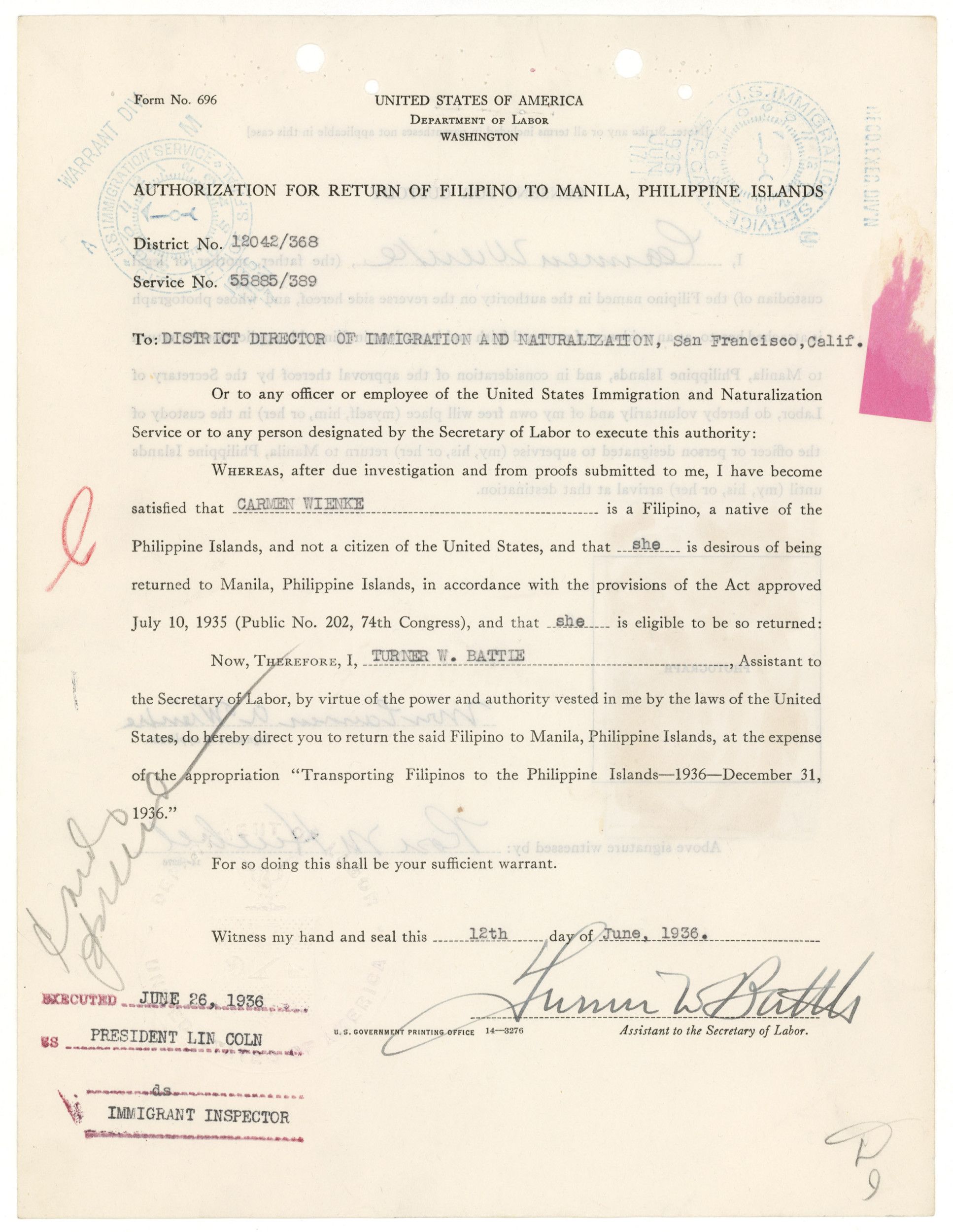
Authorization for Return of Filipino to Manila, Philippine Islands
Page 2
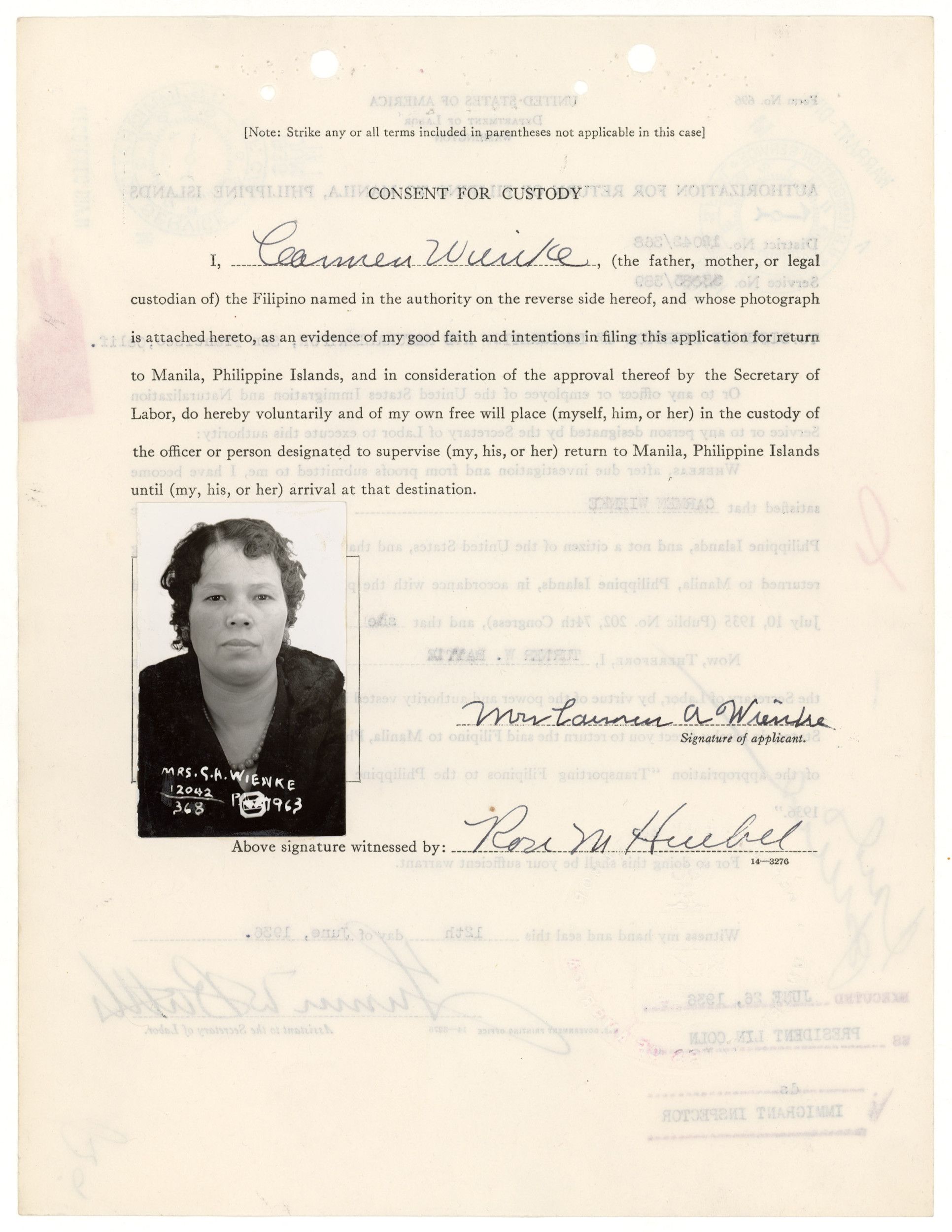
Document
Authorization for Return of Filipino to Manila, Philippine Islands
6/12/1936
Philippine-born Carmen Wienke married a former U.S. serviceman in 1919. By the early years of the Great Depression, she and her family of six children were living in San Francisco, California, where they, like so many others, were facing tough economic times.
After 1934, Carmen also faced changes to her immigration status. The Tydings-McDuffie Act granted Philippine independence, but changed her status from “U.S. national” to “alien.”
Congress had created a repatriation program under which Filipinos living in northern California were given a one-way ticket should they voluntarily return to the Philippines. According to Wienke, a social worker came to her home and threatened to cut off her family from unemployment relief unless she returned to the Philippines. She and her family sailed for Manila in 1936.
By 1939, Wienke had second thoughts. She was convinced that her marriage gave her and her children U.S. citizenship, but when she attempted to reenter the United States and rejoin her husband, she and her children were detained on Angel Island. Officials ruled against her on two legal technicalities, and after a number of appeals, she and her children were deported back to Manila in March 1940. They had been detained on Angel Island for eight months.
In December 1941, the Japanese invaded and eventually occupied the Philippine Islands. Carmen and her family spent the war years held by the Japanese in an internment camp. When they were released in 1945, Carmen and her family sailed to the United States, described as a citizen who had been born in San Francisco. She became a naturalized U.S. citizen in 1960.
After 1934, Carmen also faced changes to her immigration status. The Tydings-McDuffie Act granted Philippine independence, but changed her status from “U.S. national” to “alien.”
Congress had created a repatriation program under which Filipinos living in northern California were given a one-way ticket should they voluntarily return to the Philippines. According to Wienke, a social worker came to her home and threatened to cut off her family from unemployment relief unless she returned to the Philippines. She and her family sailed for Manila in 1936.
By 1939, Wienke had second thoughts. She was convinced that her marriage gave her and her children U.S. citizenship, but when she attempted to reenter the United States and rejoin her husband, she and her children were detained on Angel Island. Officials ruled against her on two legal technicalities, and after a number of appeals, she and her children were deported back to Manila in March 1940. They had been detained on Angel Island for eight months.
In December 1941, the Japanese invaded and eventually occupied the Philippine Islands. Carmen and her family spent the war years held by the Japanese in an internment camp. When they were released in 1945, Carmen and her family sailed to the United States, described as a citizen who had been born in San Francisco. She became a naturalized U.S. citizen in 1960.
This primary source comes from the Records of the Immigration and Naturalization Service.
National Archives Identifier: 6587583
Full Citation: Authorization for Return of Filipino to Manila, Philippine Islands; 6/12/1936 ; Immigration Arrival Investigation Case File for Carmen Wienke and Children (39384/1-2 through 1-7); Immigration Arrival Investigation Case Files, 1884 - 1944; Records of the Immigration and Naturalization Service, ; National Archives at San Francisco, San Bruno, CA. [Online Version, https://www.docsteach.org/documents/document/return-wienke-philippines, April 25, 2024]Authorization for Return of Filipino to Manila, Philippine Islands
Page 1

Authorization for Return of Filipino to Manila, Philippine Islands
Page 2

Document
Barriers and Passes
ca. 1939 - ca. 1945
This silent film created by the War Relocation Authority shows scenes of living conditions of Japanese Americans in the relocation centers during World War II.
This primary source comes from the Records of the War Relocation Authority.
National Archives Identifier: 39227
Full Citation: Motion Picture 210.6; Barriers and Passes; ca. 1939 - ca. 1945; Motion Picture Films, ca. 1939 - ca. 1945; Records of the War Relocation Authority, ; National Archives at College Park, College Park, MD. [Online Version, https://www.docsteach.org/documents/document/barriers-and-passes, April 25, 2024]Barriers and Passes
Page 1

Document
'Congress Should Compensate Those Wronged' - Commentary by Kiyoshi Okamoto to fellow Heart Mountain internees regarding federal court decision on Korematsu vs. U.S
1944
This document is a call to join lecture and discussion groups, and includes commentary by Kiyoshi Okamoto to fellow Heart Mountain internees regarding the federal court decision in Korematsu v. United States.
It was included in the case of the United States of America vs. Kiyoshi Okamoto, et. al. The prosecution of Okamoto, et. al. (Case #4930) stems directly from the Heart Mountain draft resistance movement that also resulted in the conviction of Shigeru Fujii and 62 others as documented in U.S. District Court Case #4928. Okamoto and his co-defendants, members of the so-called "Fair Play Committee," were indicted for conspiring to assist other Heart Mountain residents in their challenge to War Relocation Authority policies and the Selective Service Act as it applied to relocation camp internees.
It was included in the case of the United States of America vs. Kiyoshi Okamoto, et. al. The prosecution of Okamoto, et. al. (Case #4930) stems directly from the Heart Mountain draft resistance movement that also resulted in the conviction of Shigeru Fujii and 62 others as documented in U.S. District Court Case #4928. Okamoto and his co-defendants, members of the so-called "Fair Play Committee," were indicted for conspiring to assist other Heart Mountain residents in their challenge to War Relocation Authority policies and the Selective Service Act as it applied to relocation camp internees.
This primary source comes from the Records of District Courts of the United States.
National Archives Identifier: 292805
Full Citation: 'Congress Should Compensate Those Wronged' - Commentary by Kiyoshi Okamoto to fellow Heart Mountain internees regarding federal court decision on Korematsu vs. U.S; 1944; United States of America vs. Kiyoshi Okamoto, et. al.; Criminal Case Files, 1890 - 1949; Records of District Courts of the United States, ; National Archives at Denver, Broomfield, CO. [Online Version, https://www.docsteach.org/documents/document/compensate-those-wronged, April 25, 2024]'Congress Should Compensate Those Wronged' - Commentary by Kiyoshi Okamoto to fellow Heart Mountain internees regarding federal court decision on Korematsu vs. U.S
Page 1

Document
Demurrer to Information, filed June 20, 1942 (Docket filing 9)
6/20/1942
This document was filed in the case of United States v. Korematsu. It shows Fred Toyosaburo Korematsu's claim that the information in the case against him failed to state facts sufficient to constitute an offense against the laws of the United States.
This primary source comes from the Records of District Courts of the United States.
National Archives Identifier: 296049
Full Citation: Demurrer to Information, filed June 20, 1942 (Docket filing 9); 6/20/1942; United States v. Korematsu; Criminal Cases, 1851 - 1971; Records of District Courts of the United States, ; National Archives at San Francisco, San Bruno, CA. [Online Version, https://www.docsteach.org/documents/document/korematsu-demurrer, April 25, 2024]Demurrer to Information, filed June 20, 1942 (Docket filing 9)
Page 1

Demurrer to Information, filed June 20, 1942 (Docket filing 9)
Page 2
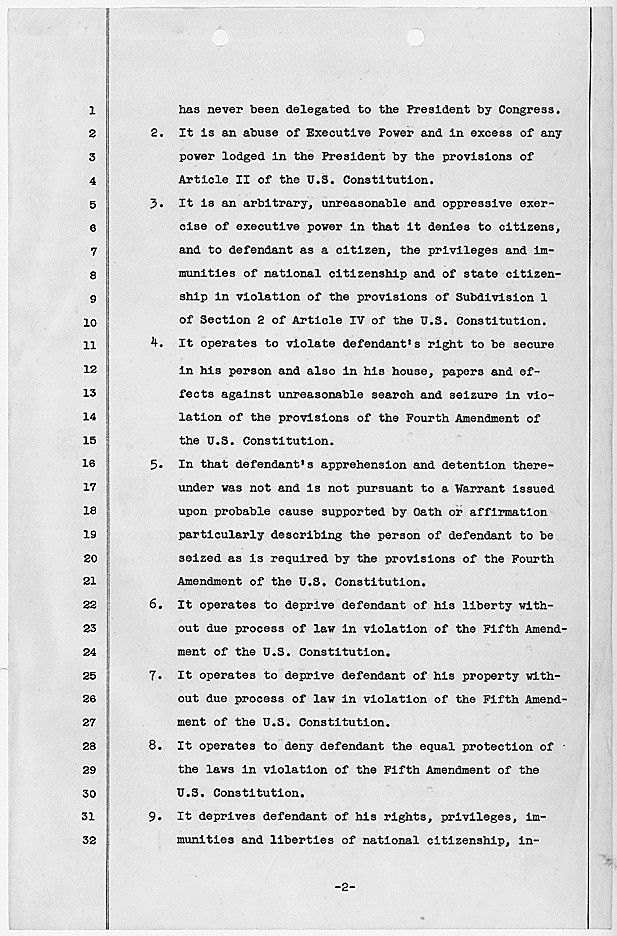
Demurrer to Information, filed June 20, 1942 (Docket filing 9)
Page 3

Demurrer to Information, filed June 20, 1942 (Docket filing 9)
Page 4

Demurrer to Information, filed June 20, 1942 (Docket filing 9)
Page 5

Demurrer to Information, filed June 20, 1942 (Docket filing 9)
Page 6
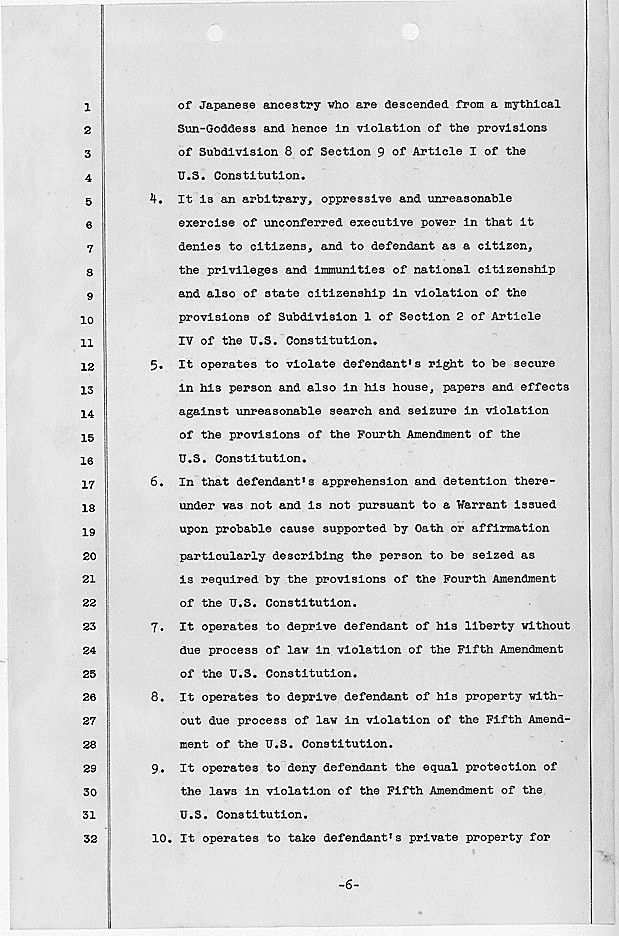
Demurrer to Information, filed June 20, 1942 (Docket filing 9)
Page 7
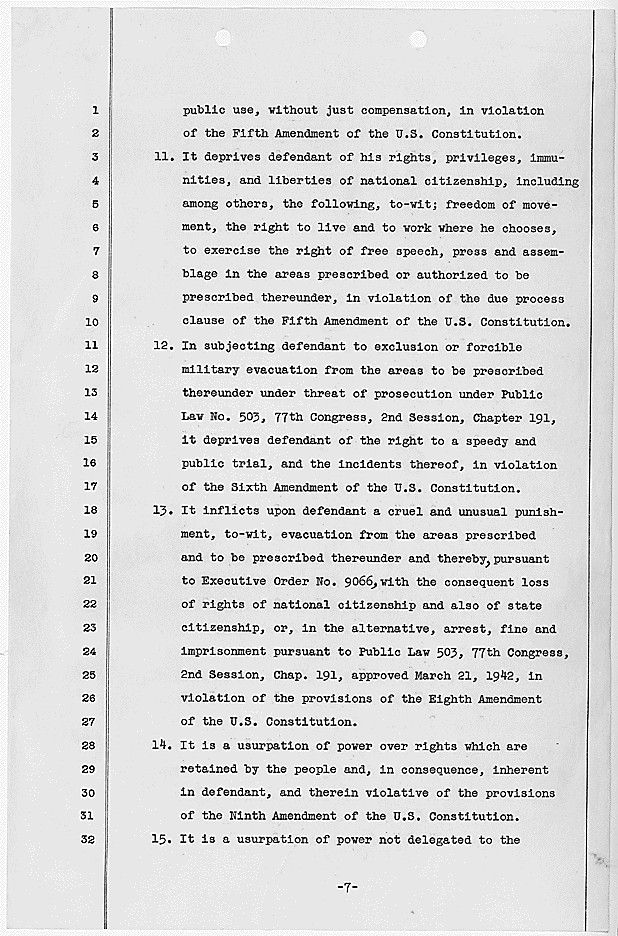
Demurrer to Information, filed June 20, 1942 (Docket filing 9)
Page 8
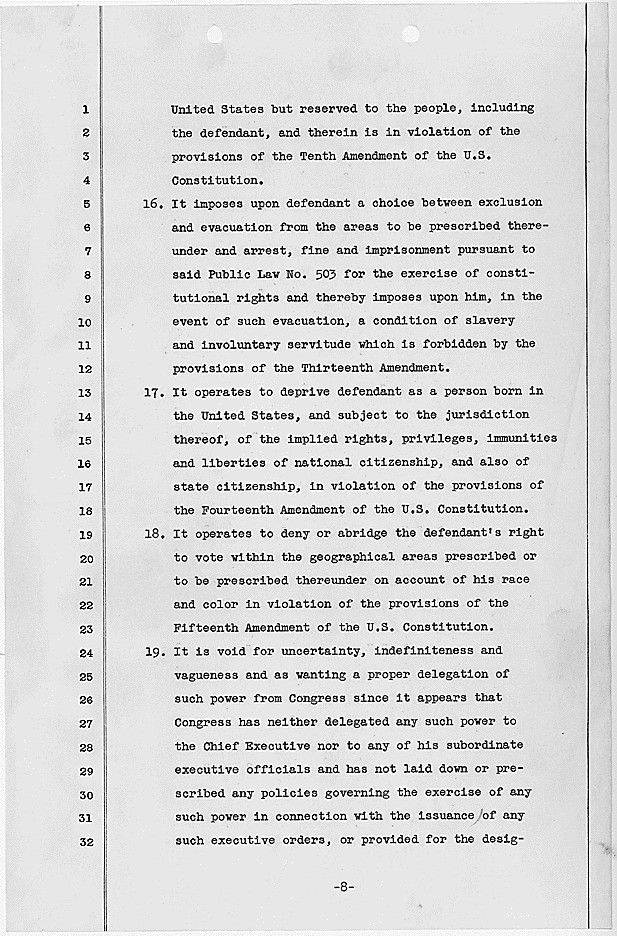
Demurrer to Information, filed June 20, 1942 (Docket filing 9)
Page 9
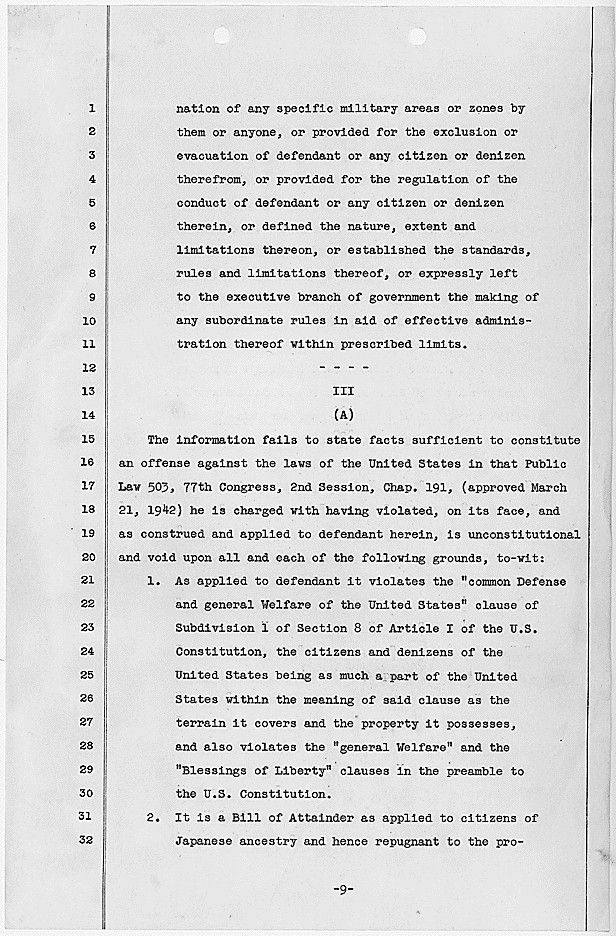
Demurrer to Information, filed June 20, 1942 (Docket filing 9)
Page 10
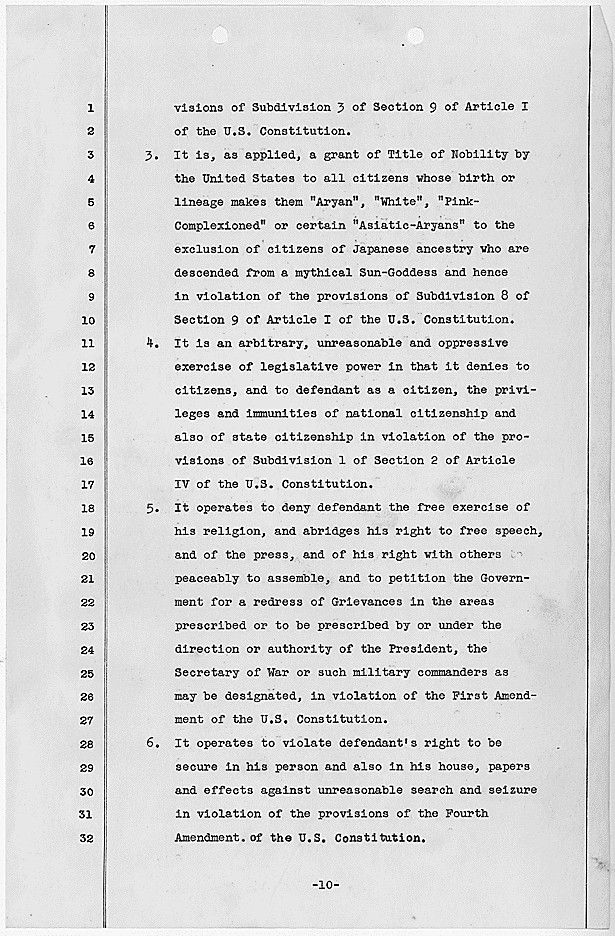
Demurrer to Information, filed June 20, 1942 (Docket filing 9)
Page 11

Demurrer to Information, filed June 20, 1942 (Docket filing 9)
Page 12

Demurrer to Information, filed June 20, 1942 (Docket filing 9)
Page 13

Demurrer to Information, filed June 20, 1942 (Docket filing 9)
Page 14
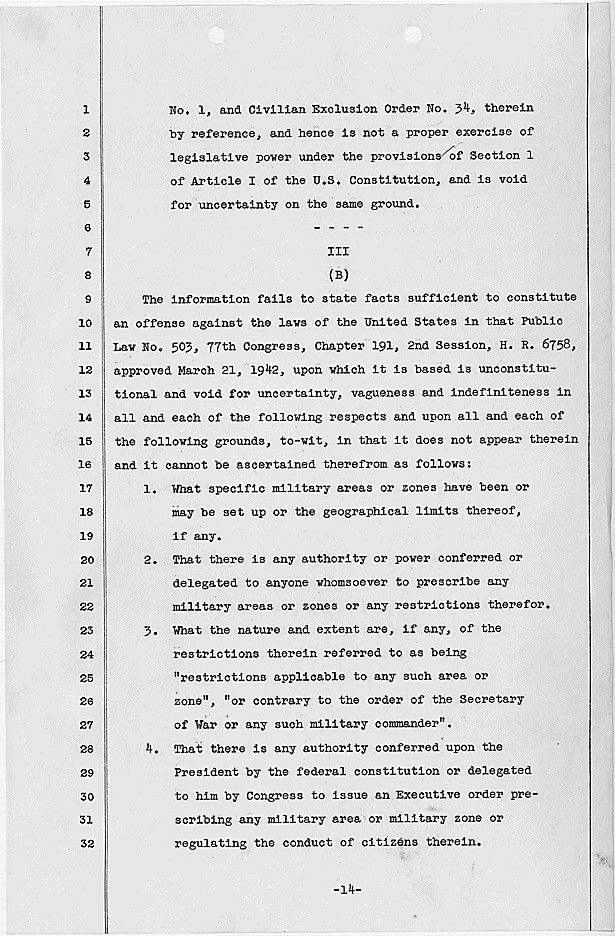
Demurrer to Information, filed June 20, 1942 (Docket filing 9)
Page 15

Demurrer to Information, filed June 20, 1942 (Docket filing 9)
Page 16
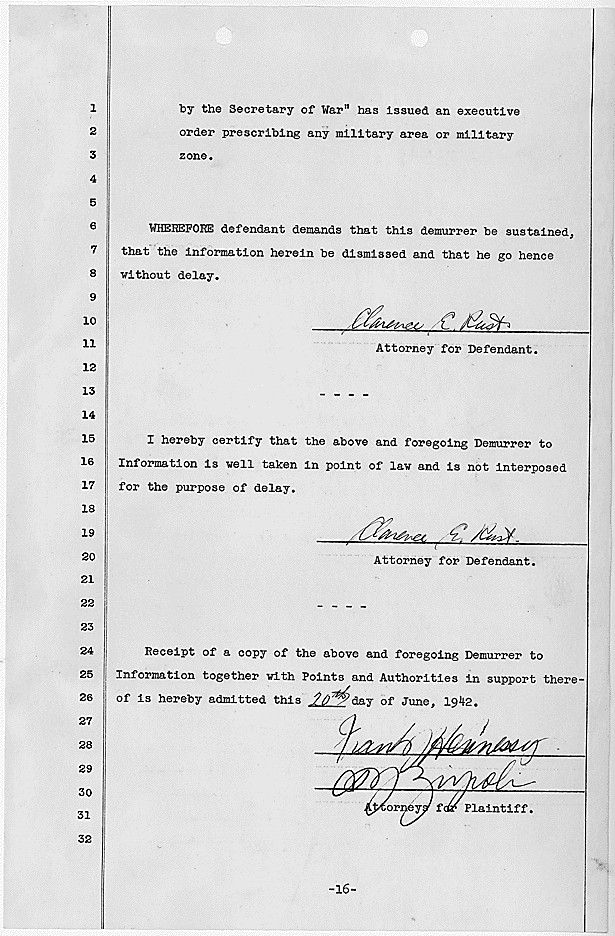
Demurrer to Information, filed June 20, 1942 (Docket filing 9)
Page 17
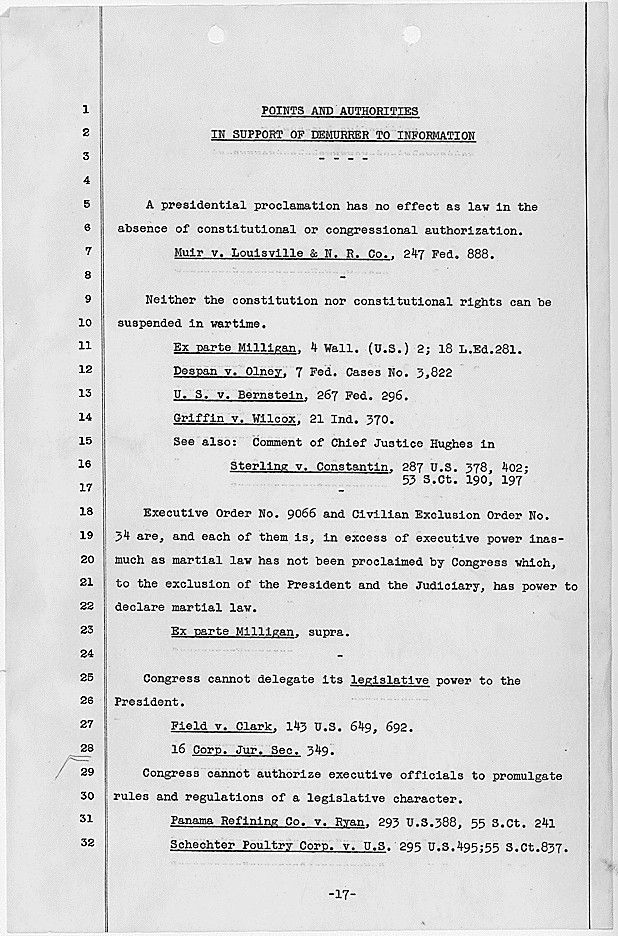
Demurrer to Information, filed June 20, 1942 (Docket filing 9)
Page 18
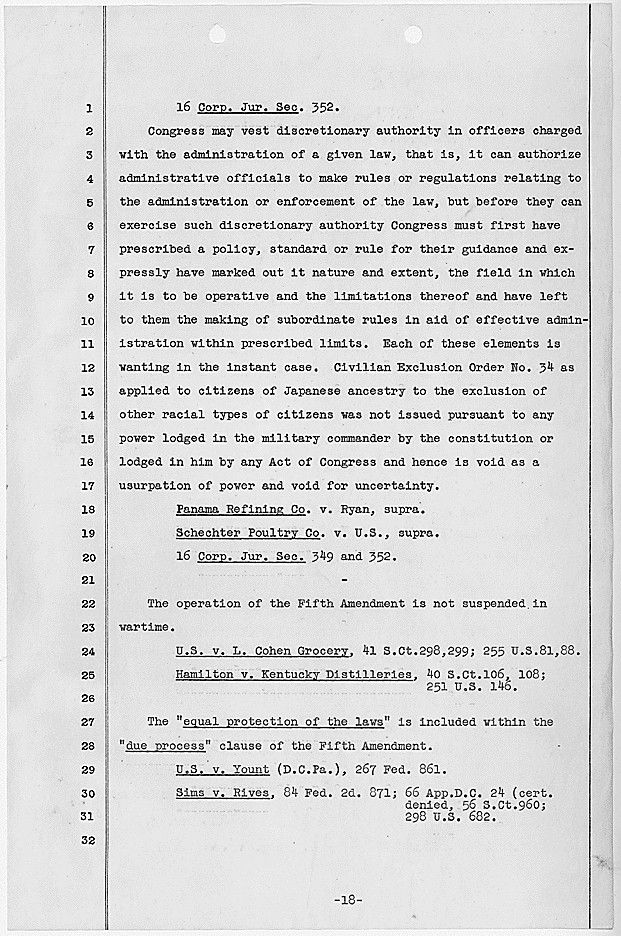
Demurrer to Information, filed June 20, 1942 (Docket filing 9)
Page 19

Document
Demurrer to Information, filed June 20, 1942 (Docket filing 9)
6/20/1942
This document was filed in the case of United States v. Korematsu. It shows Fred Toyosaburo Korematsu's claim that the information in the case against him failed to state facts sufficient to constitute an offense against the laws of the United States.
This primary source comes from the Records of District Courts of the United States.
National Archives Identifier: 296049
Full Citation: Demurrer to Information, filed June 20, 1942 (Docket filing 9); 6/20/1942; United States v. Korematsu; Criminal Cases, 1851 - 1971; Records of District Courts of the United States, ; National Archives at San Francisco, San Bruno, CA. [Online Version, https://www.docsteach.org/documents/document/korematsu-demurrer, April 25, 2024]Demurrer to Information, filed June 20, 1942 (Docket filing 9)
Page 1

Demurrer to Information, filed June 20, 1942 (Docket filing 9)
Page 2

Demurrer to Information, filed June 20, 1942 (Docket filing 9)
Page 3

Demurrer to Information, filed June 20, 1942 (Docket filing 9)
Page 4

Demurrer to Information, filed June 20, 1942 (Docket filing 9)
Page 5

Demurrer to Information, filed June 20, 1942 (Docket filing 9)
Page 6

Demurrer to Information, filed June 20, 1942 (Docket filing 9)
Page 7

Demurrer to Information, filed June 20, 1942 (Docket filing 9)
Page 8

Demurrer to Information, filed June 20, 1942 (Docket filing 9)
Page 9

Demurrer to Information, filed June 20, 1942 (Docket filing 9)
Page 10

Demurrer to Information, filed June 20, 1942 (Docket filing 9)
Page 11

Demurrer to Information, filed June 20, 1942 (Docket filing 9)
Page 12

Demurrer to Information, filed June 20, 1942 (Docket filing 9)
Page 13

Demurrer to Information, filed June 20, 1942 (Docket filing 9)
Page 14

Demurrer to Information, filed June 20, 1942 (Docket filing 9)
Page 15

Demurrer to Information, filed June 20, 1942 (Docket filing 9)
Page 16

Demurrer to Information, filed June 20, 1942 (Docket filing 9)
Page 17

Demurrer to Information, filed June 20, 1942 (Docket filing 9)
Page 18

Demurrer to Information, filed June 20, 1942 (Docket filing 9)
Page 19

Document
Demurrer to Information, filed June 20, 1942 (Docket filing 9)
6/20/1942
This document was filed in the case of United States v. Korematsu. It shows Fred Toyosaburo Korematsu's claim that the information in the case against him failed to state facts sufficient to constitute an offense against the laws of the United States.
This primary source comes from the Records of District Courts of the United States.
National Archives Identifier: 296049
Full Citation: Demurrer to Information, filed June 20, 1942 (Docket filing 9); 6/20/1942; United States v. Korematsu; Criminal Cases, 1851 - 1971; Records of District Courts of the United States, ; National Archives at San Francisco, San Bruno, CA. [Online Version, https://www.docsteach.org/documents/document/korematsu-demurrer, April 25, 2024]Demurrer to Information, filed June 20, 1942 (Docket filing 9)
Page 1

Demurrer to Information, filed June 20, 1942 (Docket filing 9)
Page 2

Demurrer to Information, filed June 20, 1942 (Docket filing 9)
Page 3

Demurrer to Information, filed June 20, 1942 (Docket filing 9)
Page 4

Demurrer to Information, filed June 20, 1942 (Docket filing 9)
Page 5

Demurrer to Information, filed June 20, 1942 (Docket filing 9)
Page 6

Demurrer to Information, filed June 20, 1942 (Docket filing 9)
Page 7

Demurrer to Information, filed June 20, 1942 (Docket filing 9)
Page 8

Demurrer to Information, filed June 20, 1942 (Docket filing 9)
Page 9

Demurrer to Information, filed June 20, 1942 (Docket filing 9)
Page 10

Demurrer to Information, filed June 20, 1942 (Docket filing 9)
Page 11

Demurrer to Information, filed June 20, 1942 (Docket filing 9)
Page 12

Demurrer to Information, filed June 20, 1942 (Docket filing 9)
Page 13

Demurrer to Information, filed June 20, 1942 (Docket filing 9)
Page 14

Demurrer to Information, filed June 20, 1942 (Docket filing 9)
Page 15

Demurrer to Information, filed June 20, 1942 (Docket filing 9)
Page 16

Demurrer to Information, filed June 20, 1942 (Docket filing 9)
Page 17

Demurrer to Information, filed June 20, 1942 (Docket filing 9)
Page 18

Demurrer to Information, filed June 20, 1942 (Docket filing 9)
Page 19

Document
An Act of March 21, 1942, Public Law 77-503, 56 STAT 173, to Provide a Penalty for Violation of Restrictions or Orders with Respect to Persons Entering, Remaining in, Leaving, or Committing Any Act in Military Areas or Zones
3/21/1942
On February 19, 1942, President Franklin D. Roosevelt issued Executive Order 9066 authorizing military commanders to exclude civilians from military areas. Although the language of the order did not specify any ethnic group, Lieutenant General John L. DeWitt of the Western Defense Command proceeded to announce curfews that included only Japanese Americans.
On March 29, 1942, under the authority of the executive order, DeWitt issued Public Proclamation No. 4, which began the controlled, involuntary evacuation and detention of West Coast residents of Japanese American ancestry on a 48-hour notice.
Just prior to the posting of DeWitt's proclamation, on March 21, 1942, Congress had passed Public Law 503, which made violation of Executive Order 9066 a misdemeanor punishable by up to one year in prison and a $5,000 fine. This document is that act: Public Law 77-503, 56 STAT 173, "To provide a penalty for violation of restrictions or orders with respect to persons entering, remaining in, leaving, or committing any act in military areas or zones."
On March 29, 1942, under the authority of the executive order, DeWitt issued Public Proclamation No. 4, which began the controlled, involuntary evacuation and detention of West Coast residents of Japanese American ancestry on a 48-hour notice.
Just prior to the posting of DeWitt's proclamation, on March 21, 1942, Congress had passed Public Law 503, which made violation of Executive Order 9066 a misdemeanor punishable by up to one year in prison and a $5,000 fine. This document is that act: Public Law 77-503, 56 STAT 173, "To provide a penalty for violation of restrictions or orders with respect to persons entering, remaining in, leaving, or committing any act in military areas or zones."
This primary source comes from the General Records of the United States Government.
National Archives Identifier: 5730387
Full Citation: An Act of March 21, 1942, Public Law 77-503, 56 STAT 173, to Provide a Penalty for Violation of Restrictions or Orders with Respect to Persons Entering, Remaining in, Leaving, or Committing Any Act in Military Areas or Zones; 3/21/1942 ; 77th Congress, 2nd Session; Enrolled Acts and Resolutions of Congress, 1789 - 2011; General Records of the United States Government, ; National Archives Building, Washington, DC. [Online Version, https://www.docsteach.org/documents/document/enforcement-executive-order-9066, April 25, 2024]An Act of March 21, 1942, Public Law 77-503, 56 STAT 173, to Provide a Penalty for Violation of Restrictions or Orders with Respect to Persons Entering, Remaining in, Leaving, or Committing Any Act in Military Areas or Zones
Page 1
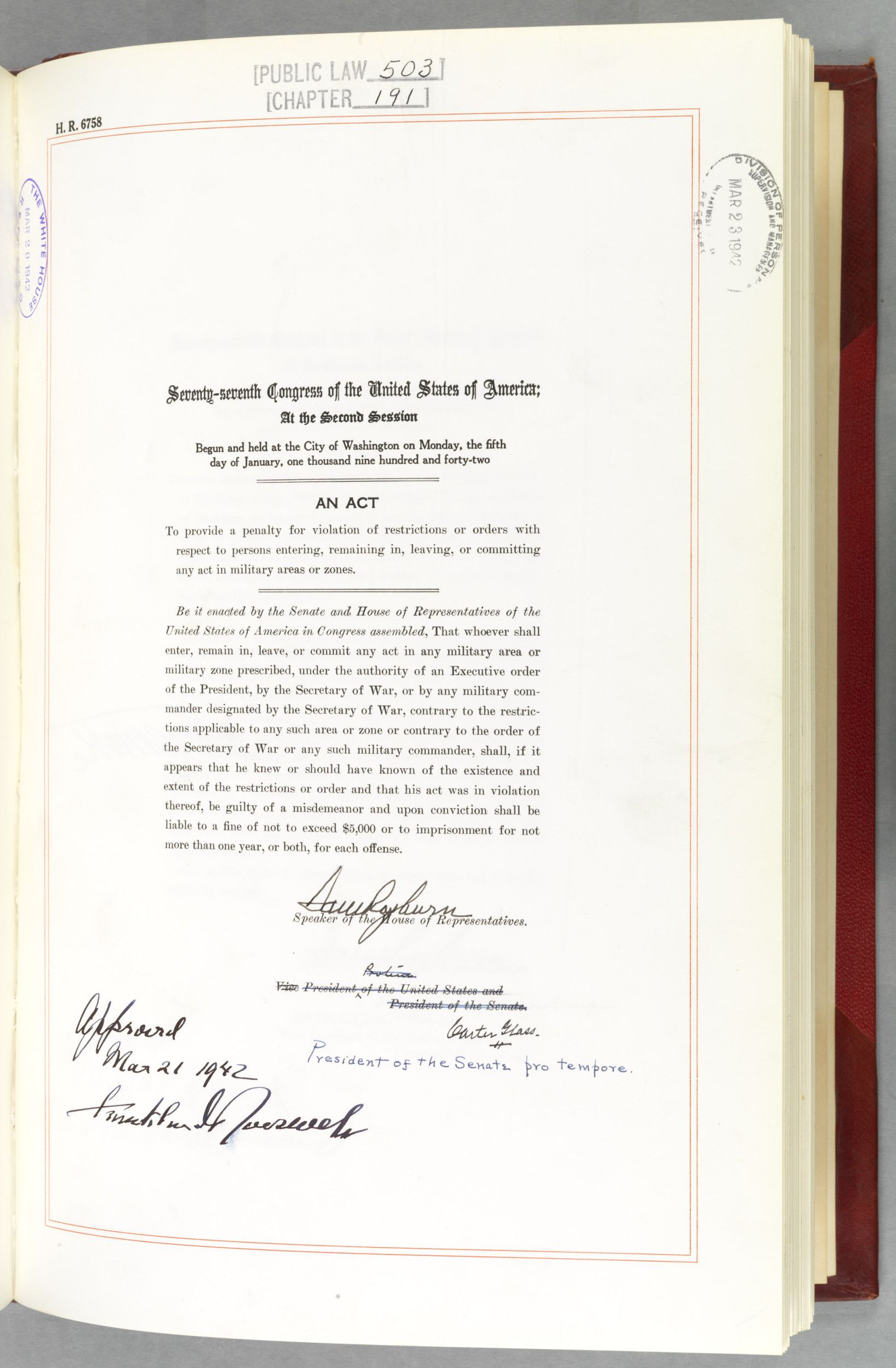
Document
Executive Order 9066 dated February 19, 1942, in which President Franklin D. Roosevelt Authorizes the Secretary of War to Prescribe Military Areas
2/19/1942
Issued by President Franklin Roosevelt on February 19, 1942, Executive Order 9066 authorized the Secretary of War to evacuate all persons deemed a threat to national security from the West Coast to "relocation centers" further inland.
Prior to the outbreak of World War II, the Federal Bureau of Investigation (FBI) had identified German, Italian, and Japanese aliens who were suspected of being potential enemy agents. Following the attack at Pearl Harbor, the West Coast was divided into military zones and suspect enemy aliens were kept under surveillance. By mid-January 1942, demands arose to exclude not only suspicious aliens whose origins were in belligerent nations, but all persons of Japanese descent, whether foreign born (issei) or American citizens (nisei). During congressional committee hearings, Department of Justice representatives raised constitutional and ethical objections to the proposal, so the U.S. Army carried out the task instead.
The West Coast was divided into military zones, and on February 19, 1942, President Franklin D. Roosevelt issued Executive Order 9066 that authorized military commanders to exclude civilians from military areas. Although the language of the order did not specify any ethnic group, Lieutenant General John L. DeWitt of the Western Defense Command proceeded to announce curfews that included only Japanese Americans. Next, he encouraged voluntary evacuation by Japanese Americans from a limited number of areas; about 7 percent of the total Japanese American population in these areas complied.
On March 29, 1942, under the authority of the President's executive order, DeWitt issued Public Proclamation No. 4, which began the forced evacuation and detention of Japanese-American West Coast residents on a 48-hour notice. Only a few days prior to the proclamation, on March 21, Congress had passed Public Law 503, which made violation of Executive Order 9066 a misdemeanor punishable by up to one year in prison and a $5,000 fine.
From the end of March to August, approximately 122,000 men, women, and children were forcibly moved to "assembly centers." They were then evacuated to and confined in isolated, fenced, and guarded "relocation centers," also known as "internment camps." The 10 sites were in remote areas in six western states and Arkansas: Heart Mountain in Wyoming, Tule Lake and Manzanar in California, Topaz in Utah, Poston and Gila River in Arizona, Granada in Colorado, Minidoka in Idaho, and Jerome and Rowher in Arkansas.
Nearly 70,000 of the evacuees were American citizens. There were no charges of disloyalty against any of these citizens, nor was there any vehicle by which they could appeal their loss of property and personal liberty. All lost personal liberties; most lost homes and property as well.
Although several Japanese Americans challenged the government’s actions in court cases, the Supreme Court upheld their legality. Nisei were nevertheless encouraged to serve in the armed forces, and some were also drafted. Altogether, more than 30,000 Japanese Americans served with distinction during World War II in segregated units.
For many years after the war, various individuals and groups sought compensation for those incarcerated. The speed of the "evacuation" forced many homeowners and businessmen to sell out quickly; total property loss is estimated at $1.3 billion, and net income loss at $2.7 billion (calculated in 1983 dollars based on a congressional commission investigation). The Japanese American Evacuation Claims Act of 1948, with amendments in 1951 and 1965, provided token payments for some property losses. More serious efforts to make amends took place in the early 1980s, when the congressionally established Commission on Wartime Relocation and Internment of Civilians held investigations and made recommendations. As a result, several bills were introduced in Congress from 1984 until 1988. In 1988, Public Law 100-383 acknowledged the injustice of the incarceration, apologized for it, and provided partial restitution – a $20,000 cash payment to each person who was incarcerated.
Prior to the outbreak of World War II, the Federal Bureau of Investigation (FBI) had identified German, Italian, and Japanese aliens who were suspected of being potential enemy agents. Following the attack at Pearl Harbor, the West Coast was divided into military zones and suspect enemy aliens were kept under surveillance. By mid-January 1942, demands arose to exclude not only suspicious aliens whose origins were in belligerent nations, but all persons of Japanese descent, whether foreign born (issei) or American citizens (nisei). During congressional committee hearings, Department of Justice representatives raised constitutional and ethical objections to the proposal, so the U.S. Army carried out the task instead.
The West Coast was divided into military zones, and on February 19, 1942, President Franklin D. Roosevelt issued Executive Order 9066 that authorized military commanders to exclude civilians from military areas. Although the language of the order did not specify any ethnic group, Lieutenant General John L. DeWitt of the Western Defense Command proceeded to announce curfews that included only Japanese Americans. Next, he encouraged voluntary evacuation by Japanese Americans from a limited number of areas; about 7 percent of the total Japanese American population in these areas complied.
On March 29, 1942, under the authority of the President's executive order, DeWitt issued Public Proclamation No. 4, which began the forced evacuation and detention of Japanese-American West Coast residents on a 48-hour notice. Only a few days prior to the proclamation, on March 21, Congress had passed Public Law 503, which made violation of Executive Order 9066 a misdemeanor punishable by up to one year in prison and a $5,000 fine.
From the end of March to August, approximately 122,000 men, women, and children were forcibly moved to "assembly centers." They were then evacuated to and confined in isolated, fenced, and guarded "relocation centers," also known as "internment camps." The 10 sites were in remote areas in six western states and Arkansas: Heart Mountain in Wyoming, Tule Lake and Manzanar in California, Topaz in Utah, Poston and Gila River in Arizona, Granada in Colorado, Minidoka in Idaho, and Jerome and Rowher in Arkansas.
Nearly 70,000 of the evacuees were American citizens. There were no charges of disloyalty against any of these citizens, nor was there any vehicle by which they could appeal their loss of property and personal liberty. All lost personal liberties; most lost homes and property as well.
Although several Japanese Americans challenged the government’s actions in court cases, the Supreme Court upheld their legality. Nisei were nevertheless encouraged to serve in the armed forces, and some were also drafted. Altogether, more than 30,000 Japanese Americans served with distinction during World War II in segregated units.
For many years after the war, various individuals and groups sought compensation for those incarcerated. The speed of the "evacuation" forced many homeowners and businessmen to sell out quickly; total property loss is estimated at $1.3 billion, and net income loss at $2.7 billion (calculated in 1983 dollars based on a congressional commission investigation). The Japanese American Evacuation Claims Act of 1948, with amendments in 1951 and 1965, provided token payments for some property losses. More serious efforts to make amends took place in the early 1980s, when the congressionally established Commission on Wartime Relocation and Internment of Civilians held investigations and made recommendations. As a result, several bills were introduced in Congress from 1984 until 1988. In 1988, Public Law 100-383 acknowledged the injustice of the incarceration, apologized for it, and provided partial restitution – a $20,000 cash payment to each person who was incarcerated.
Transcript
Executive Order No. 9066The President
Executive Order
Authorizing the Secretary of War to Prescribe Military Areas
Whereas the successful prosecution of the war requires every possible protection against espionage and against sabotage to national-defense material, national-defense premises, and national-defense utilities as defined in Section 4, Act of April 20, 1918, 40 Stat. 533, as amended by the Act of November 30, 1940, 54 Stat. 1220, and the Act of August 21, 1941, 55 Stat. 655 (U.S.C., Title 50, Sec. 104);
Now, therefore, by virtue of the authority vested in me as President of the United States, and Commander in Chief of the Army and Navy, I hereby authorize and direct the Secretary of War, and the Military Commanders whom he may from time to time designate, whenever he or any designated Commander deems such action necessary or desirable, to prescribe military areas in such places and of such extent as he or the appropriate Military Commander may determine, from which any or all persons may be excluded, and with respect to which, the right of any person to enter, remain in, or leave shall be subject to whatever restrictions the Secretary of War or the appropriate Military Commander may impose in his discretion. The Secretary of War is hereby authorized to provide for residents of any such area who are excluded therefrom, such transportation, food, shelter, and other accommodations as may be necessary, in the judgment of the Secretary of War or the said Military Commander, and until other arrangements are made, to accomplish the purpose of this order. The designation of military areas in any region or locality shall supersede designations of prohibited and restricted areas by the Attorney General under the Proclamations of December 7 and 8, 1941, and shall supersede the responsibility and authority of the Attorney General under the said Proclamations in respect of such prohibited and restricted areas.
I hereby further authorize and direct the Secretary of War and the said Military Commanders to take such other steps as he or the appropriate Military Commander may deem advisable to enforce compliance with the restrictions applicable to each Military area hereinabove authorized to be designated, including the use of Federal troops and other Federal Agencies, with authority to accept assistance of state and local agencies.
I hereby further authorize and direct all Executive Departments, independent establishments and other Federal Agencies, to assist the Secretary of War or the said Military Commanders in carrying out this Executive Order, including the furnishing of medical aid, hospitalization, food, clothing, transportation, use of land, shelter, and other supplies, equipment, utilities, facilities, and services.
This order shall not be construed as modifying or limiting in any way the authority heretofore granted under Executive Order No. 8972, dated December 12, 1941, nor shall it be construed as limiting or modifying the duty and responsibility of the Federal Bureau of Investigation, with respect to the investigation of alleged acts of sabotage or the duty and responsibility of the Attorney General and the Department of Justice under the Proclamations of December 7 and 8, 1941, prescribing regulations for the conduct and control of alien enemies, except as such duty and responsibility is superseded by the designation of military areas hereunder.
Franklin D. Roosevelt
The White House,
February 19, 1942.
This primary source comes from the General Records of the United States Government.
National Archives Identifier: 5730250
Full Citation: Executive Order 9066 dated February 19, 1942, in which President Franklin D. Roosevelt Authorizes the Secretary of War to Prescribe Military Areas; 2/19/1942; Executive Orders 9041 - 9070; Executive Orders, 1862 - 2011; General Records of the United States Government, ; National Archives Building, Washington, DC. [Online Version, https://www.docsteach.org/documents/document/executive-order-9066, April 25, 2024]Executive Order 9066 dated February 19, 1942, in which President Franklin D. Roosevelt Authorizes the Secretary of War to Prescribe Military Areas
Page 1
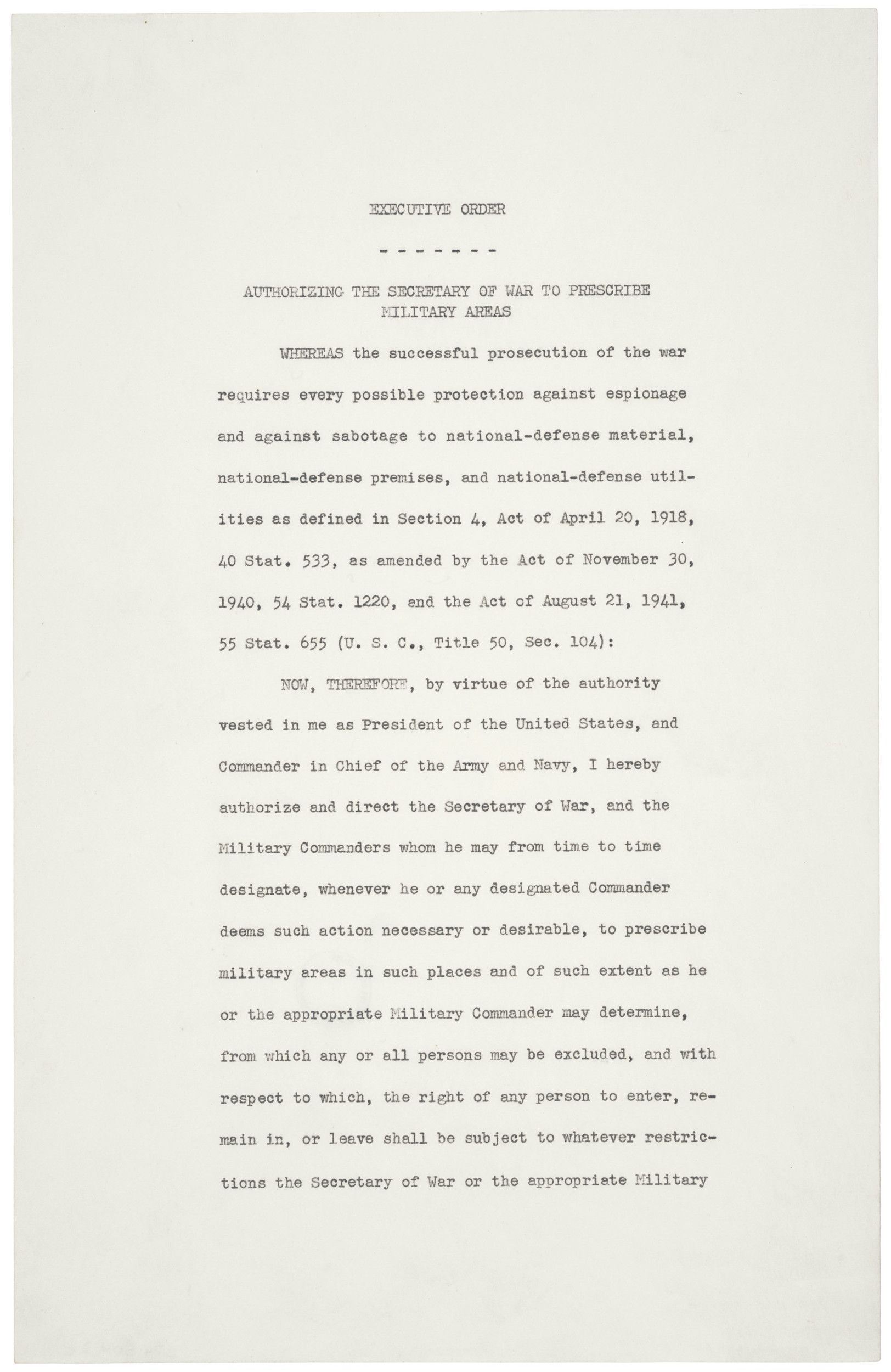
Executive Order 9066 dated February 19, 1942, in which President Franklin D. Roosevelt Authorizes the Secretary of War to Prescribe Military Areas
Page 2
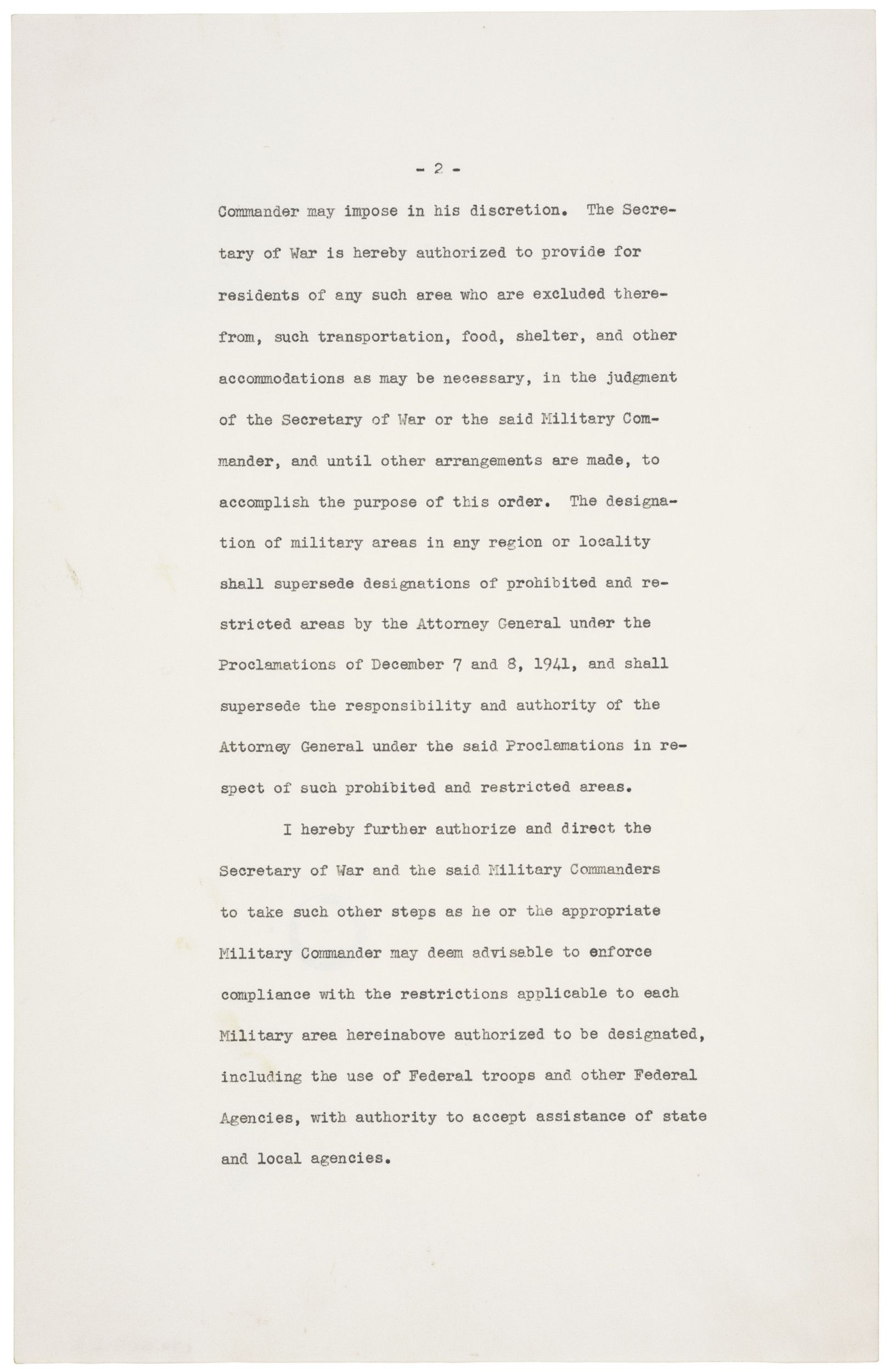
Executive Order 9066 dated February 19, 1942, in which President Franklin D. Roosevelt Authorizes the Secretary of War to Prescribe Military Areas
Page 3
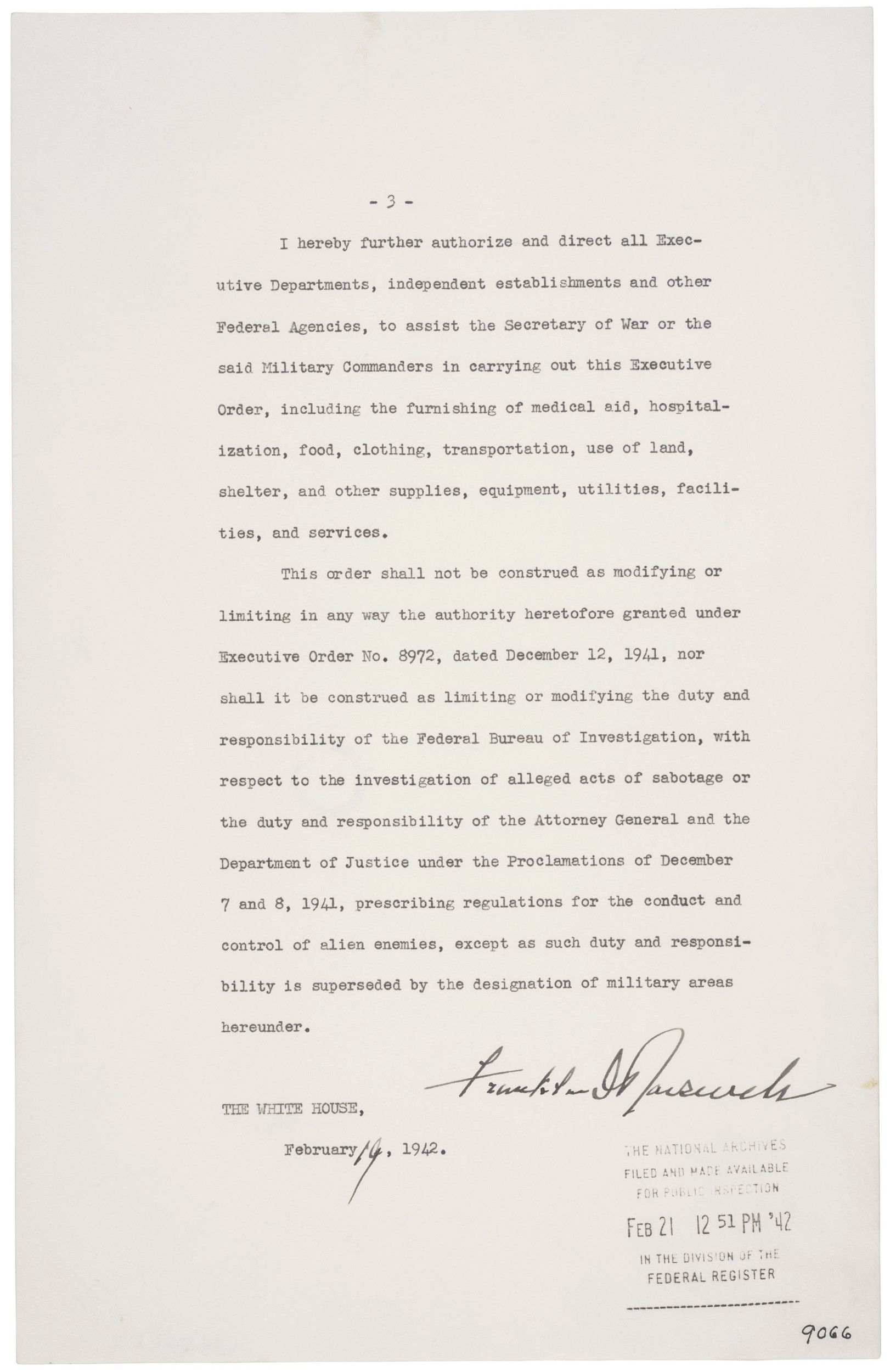
Document
Executive Order 9066 dated February 19, 1942, in which President Franklin D. Roosevelt Authorizes the Secretary of War to Prescribe Military Areas
2/19/1942
Issued by President Franklin Roosevelt on February 19, 1942, Executive Order 9066 authorized the Secretary of War to evacuate all persons deemed a threat to national security from the West Coast to "relocation centers" further inland.
Prior to the outbreak of World War II, the Federal Bureau of Investigation (FBI) had identified German, Italian, and Japanese aliens who were suspected of being potential enemy agents. Following the attack at Pearl Harbor, the West Coast was divided into military zones and suspect enemy aliens were kept under surveillance. By mid-January 1942, demands arose to exclude not only suspicious aliens whose origins were in belligerent nations, but all persons of Japanese descent, whether foreign born (issei) or American citizens (nisei). During congressional committee hearings, Department of Justice representatives raised constitutional and ethical objections to the proposal, so the U.S. Army carried out the task instead.
The West Coast was divided into military zones, and on February 19, 1942, President Franklin D. Roosevelt issued Executive Order 9066 that authorized military commanders to exclude civilians from military areas. Although the language of the order did not specify any ethnic group, Lieutenant General John L. DeWitt of the Western Defense Command proceeded to announce curfews that included only Japanese Americans. Next, he encouraged voluntary evacuation by Japanese Americans from a limited number of areas; about 7 percent of the total Japanese American population in these areas complied.
On March 29, 1942, under the authority of the President's executive order, DeWitt issued Public Proclamation No. 4, which began the forced evacuation and detention of Japanese-American West Coast residents on a 48-hour notice. Only a few days prior to the proclamation, on March 21, Congress had passed Public Law 503, which made violation of Executive Order 9066 a misdemeanor punishable by up to one year in prison and a $5,000 fine.
From the end of March to August, approximately 122,000 men, women, and children were forcibly moved to "assembly centers." They were then evacuated to and confined in isolated, fenced, and guarded "relocation centers," also known as "internment camps." The 10 sites were in remote areas in six western states and Arkansas: Heart Mountain in Wyoming, Tule Lake and Manzanar in California, Topaz in Utah, Poston and Gila River in Arizona, Granada in Colorado, Minidoka in Idaho, and Jerome and Rowher in Arkansas.
Nearly 70,000 of the evacuees were American citizens. There were no charges of disloyalty against any of these citizens, nor was there any vehicle by which they could appeal their loss of property and personal liberty. All lost personal liberties; most lost homes and property as well.
Although several Japanese Americans challenged the government’s actions in court cases, the Supreme Court upheld their legality. Nisei were nevertheless encouraged to serve in the armed forces, and some were also drafted. Altogether, more than 30,000 Japanese Americans served with distinction during World War II in segregated units.
For many years after the war, various individuals and groups sought compensation for those incarcerated. The speed of the "evacuation" forced many homeowners and businessmen to sell out quickly; total property loss is estimated at $1.3 billion, and net income loss at $2.7 billion (calculated in 1983 dollars based on a congressional commission investigation). The Japanese American Evacuation Claims Act of 1948, with amendments in 1951 and 1965, provided token payments for some property losses. More serious efforts to make amends took place in the early 1980s, when the congressionally established Commission on Wartime Relocation and Internment of Civilians held investigations and made recommendations. As a result, several bills were introduced in Congress from 1984 until 1988. In 1988, Public Law 100-383 acknowledged the injustice of the incarceration, apologized for it, and provided partial restitution – a $20,000 cash payment to each person who was incarcerated.
Prior to the outbreak of World War II, the Federal Bureau of Investigation (FBI) had identified German, Italian, and Japanese aliens who were suspected of being potential enemy agents. Following the attack at Pearl Harbor, the West Coast was divided into military zones and suspect enemy aliens were kept under surveillance. By mid-January 1942, demands arose to exclude not only suspicious aliens whose origins were in belligerent nations, but all persons of Japanese descent, whether foreign born (issei) or American citizens (nisei). During congressional committee hearings, Department of Justice representatives raised constitutional and ethical objections to the proposal, so the U.S. Army carried out the task instead.
The West Coast was divided into military zones, and on February 19, 1942, President Franklin D. Roosevelt issued Executive Order 9066 that authorized military commanders to exclude civilians from military areas. Although the language of the order did not specify any ethnic group, Lieutenant General John L. DeWitt of the Western Defense Command proceeded to announce curfews that included only Japanese Americans. Next, he encouraged voluntary evacuation by Japanese Americans from a limited number of areas; about 7 percent of the total Japanese American population in these areas complied.
On March 29, 1942, under the authority of the President's executive order, DeWitt issued Public Proclamation No. 4, which began the forced evacuation and detention of Japanese-American West Coast residents on a 48-hour notice. Only a few days prior to the proclamation, on March 21, Congress had passed Public Law 503, which made violation of Executive Order 9066 a misdemeanor punishable by up to one year in prison and a $5,000 fine.
From the end of March to August, approximately 122,000 men, women, and children were forcibly moved to "assembly centers." They were then evacuated to and confined in isolated, fenced, and guarded "relocation centers," also known as "internment camps." The 10 sites were in remote areas in six western states and Arkansas: Heart Mountain in Wyoming, Tule Lake and Manzanar in California, Topaz in Utah, Poston and Gila River in Arizona, Granada in Colorado, Minidoka in Idaho, and Jerome and Rowher in Arkansas.
Nearly 70,000 of the evacuees were American citizens. There were no charges of disloyalty against any of these citizens, nor was there any vehicle by which they could appeal their loss of property and personal liberty. All lost personal liberties; most lost homes and property as well.
Although several Japanese Americans challenged the government’s actions in court cases, the Supreme Court upheld their legality. Nisei were nevertheless encouraged to serve in the armed forces, and some were also drafted. Altogether, more than 30,000 Japanese Americans served with distinction during World War II in segregated units.
For many years after the war, various individuals and groups sought compensation for those incarcerated. The speed of the "evacuation" forced many homeowners and businessmen to sell out quickly; total property loss is estimated at $1.3 billion, and net income loss at $2.7 billion (calculated in 1983 dollars based on a congressional commission investigation). The Japanese American Evacuation Claims Act of 1948, with amendments in 1951 and 1965, provided token payments for some property losses. More serious efforts to make amends took place in the early 1980s, when the congressionally established Commission on Wartime Relocation and Internment of Civilians held investigations and made recommendations. As a result, several bills were introduced in Congress from 1984 until 1988. In 1988, Public Law 100-383 acknowledged the injustice of the incarceration, apologized for it, and provided partial restitution – a $20,000 cash payment to each person who was incarcerated.
Transcript
Executive Order No. 9066The President
Executive Order
Authorizing the Secretary of War to Prescribe Military Areas
Whereas the successful prosecution of the war requires every possible protection against espionage and against sabotage to national-defense material, national-defense premises, and national-defense utilities as defined in Section 4, Act of April 20, 1918, 40 Stat. 533, as amended by the Act of November 30, 1940, 54 Stat. 1220, and the Act of August 21, 1941, 55 Stat. 655 (U.S.C., Title 50, Sec. 104);
Now, therefore, by virtue of the authority vested in me as President of the United States, and Commander in Chief of the Army and Navy, I hereby authorize and direct the Secretary of War, and the Military Commanders whom he may from time to time designate, whenever he or any designated Commander deems such action necessary or desirable, to prescribe military areas in such places and of such extent as he or the appropriate Military Commander may determine, from which any or all persons may be excluded, and with respect to which, the right of any person to enter, remain in, or leave shall be subject to whatever restrictions the Secretary of War or the appropriate Military Commander may impose in his discretion. The Secretary of War is hereby authorized to provide for residents of any such area who are excluded therefrom, such transportation, food, shelter, and other accommodations as may be necessary, in the judgment of the Secretary of War or the said Military Commander, and until other arrangements are made, to accomplish the purpose of this order. The designation of military areas in any region or locality shall supersede designations of prohibited and restricted areas by the Attorney General under the Proclamations of December 7 and 8, 1941, and shall supersede the responsibility and authority of the Attorney General under the said Proclamations in respect of such prohibited and restricted areas.
I hereby further authorize and direct the Secretary of War and the said Military Commanders to take such other steps as he or the appropriate Military Commander may deem advisable to enforce compliance with the restrictions applicable to each Military area hereinabove authorized to be designated, including the use of Federal troops and other Federal Agencies, with authority to accept assistance of state and local agencies.
I hereby further authorize and direct all Executive Departments, independent establishments and other Federal Agencies, to assist the Secretary of War or the said Military Commanders in carrying out this Executive Order, including the furnishing of medical aid, hospitalization, food, clothing, transportation, use of land, shelter, and other supplies, equipment, utilities, facilities, and services.
This order shall not be construed as modifying or limiting in any way the authority heretofore granted under Executive Order No. 8972, dated December 12, 1941, nor shall it be construed as limiting or modifying the duty and responsibility of the Federal Bureau of Investigation, with respect to the investigation of alleged acts of sabotage or the duty and responsibility of the Attorney General and the Department of Justice under the Proclamations of December 7 and 8, 1941, prescribing regulations for the conduct and control of alien enemies, except as such duty and responsibility is superseded by the designation of military areas hereunder.
Franklin D. Roosevelt
The White House,
February 19, 1942.
This primary source comes from the General Records of the United States Government.
National Archives Identifier: 5730250
Full Citation: Executive Order 9066 dated February 19, 1942, in which President Franklin D. Roosevelt Authorizes the Secretary of War to Prescribe Military Areas; 2/19/1942; Executive Orders 9041 - 9070; Executive Orders, 1862 - 2011; General Records of the United States Government, ; National Archives Building, Washington, DC. [Online Version, https://www.docsteach.org/documents/document/executive-order-9066, April 25, 2024]Executive Order 9066 dated February 19, 1942, in which President Franklin D. Roosevelt Authorizes the Secretary of War to Prescribe Military Areas
Page 1

Executive Order 9066 dated February 19, 1942, in which President Franklin D. Roosevelt Authorizes the Secretary of War to Prescribe Military Areas
Page 2

Executive Order 9066 dated February 19, 1942, in which President Franklin D. Roosevelt Authorizes the Secretary of War to Prescribe Military Areas
Page 3

Document
Executive Order 9066 dated February 19, 1942, in which President Franklin D. Roosevelt Authorizes the Secretary of War to Prescribe Military Areas
2/19/1942
Issued by President Franklin Roosevelt on February 19, 1942, Executive Order 9066 authorized the Secretary of War to evacuate all persons deemed a threat to national security from the West Coast to "relocation centers" further inland.
Prior to the outbreak of World War II, the Federal Bureau of Investigation (FBI) had identified German, Italian, and Japanese aliens who were suspected of being potential enemy agents. Following the attack at Pearl Harbor, the West Coast was divided into military zones and suspect enemy aliens were kept under surveillance. By mid-January 1942, demands arose to exclude not only suspicious aliens whose origins were in belligerent nations, but all persons of Japanese descent, whether foreign born (issei) or American citizens (nisei). During congressional committee hearings, Department of Justice representatives raised constitutional and ethical objections to the proposal, so the U.S. Army carried out the task instead.
The West Coast was divided into military zones, and on February 19, 1942, President Franklin D. Roosevelt issued Executive Order 9066 that authorized military commanders to exclude civilians from military areas. Although the language of the order did not specify any ethnic group, Lieutenant General John L. DeWitt of the Western Defense Command proceeded to announce curfews that included only Japanese Americans. Next, he encouraged voluntary evacuation by Japanese Americans from a limited number of areas; about 7 percent of the total Japanese American population in these areas complied.
On March 29, 1942, under the authority of the President's executive order, DeWitt issued Public Proclamation No. 4, which began the forced evacuation and detention of Japanese-American West Coast residents on a 48-hour notice. Only a few days prior to the proclamation, on March 21, Congress had passed Public Law 503, which made violation of Executive Order 9066 a misdemeanor punishable by up to one year in prison and a $5,000 fine.
From the end of March to August, approximately 122,000 men, women, and children were forcibly moved to "assembly centers." They were then evacuated to and confined in isolated, fenced, and guarded "relocation centers," also known as "internment camps." The 10 sites were in remote areas in six western states and Arkansas: Heart Mountain in Wyoming, Tule Lake and Manzanar in California, Topaz in Utah, Poston and Gila River in Arizona, Granada in Colorado, Minidoka in Idaho, and Jerome and Rowher in Arkansas.
Nearly 70,000 of the evacuees were American citizens. There were no charges of disloyalty against any of these citizens, nor was there any vehicle by which they could appeal their loss of property and personal liberty. All lost personal liberties; most lost homes and property as well.
Although several Japanese Americans challenged the government’s actions in court cases, the Supreme Court upheld their legality. Nisei were nevertheless encouraged to serve in the armed forces, and some were also drafted. Altogether, more than 30,000 Japanese Americans served with distinction during World War II in segregated units.
For many years after the war, various individuals and groups sought compensation for those incarcerated. The speed of the "evacuation" forced many homeowners and businessmen to sell out quickly; total property loss is estimated at $1.3 billion, and net income loss at $2.7 billion (calculated in 1983 dollars based on a congressional commission investigation). The Japanese American Evacuation Claims Act of 1948, with amendments in 1951 and 1965, provided token payments for some property losses. More serious efforts to make amends took place in the early 1980s, when the congressionally established Commission on Wartime Relocation and Internment of Civilians held investigations and made recommendations. As a result, several bills were introduced in Congress from 1984 until 1988. In 1988, Public Law 100-383 acknowledged the injustice of the incarceration, apologized for it, and provided partial restitution – a $20,000 cash payment to each person who was incarcerated.
Prior to the outbreak of World War II, the Federal Bureau of Investigation (FBI) had identified German, Italian, and Japanese aliens who were suspected of being potential enemy agents. Following the attack at Pearl Harbor, the West Coast was divided into military zones and suspect enemy aliens were kept under surveillance. By mid-January 1942, demands arose to exclude not only suspicious aliens whose origins were in belligerent nations, but all persons of Japanese descent, whether foreign born (issei) or American citizens (nisei). During congressional committee hearings, Department of Justice representatives raised constitutional and ethical objections to the proposal, so the U.S. Army carried out the task instead.
The West Coast was divided into military zones, and on February 19, 1942, President Franklin D. Roosevelt issued Executive Order 9066 that authorized military commanders to exclude civilians from military areas. Although the language of the order did not specify any ethnic group, Lieutenant General John L. DeWitt of the Western Defense Command proceeded to announce curfews that included only Japanese Americans. Next, he encouraged voluntary evacuation by Japanese Americans from a limited number of areas; about 7 percent of the total Japanese American population in these areas complied.
On March 29, 1942, under the authority of the President's executive order, DeWitt issued Public Proclamation No. 4, which began the forced evacuation and detention of Japanese-American West Coast residents on a 48-hour notice. Only a few days prior to the proclamation, on March 21, Congress had passed Public Law 503, which made violation of Executive Order 9066 a misdemeanor punishable by up to one year in prison and a $5,000 fine.
From the end of March to August, approximately 122,000 men, women, and children were forcibly moved to "assembly centers." They were then evacuated to and confined in isolated, fenced, and guarded "relocation centers," also known as "internment camps." The 10 sites were in remote areas in six western states and Arkansas: Heart Mountain in Wyoming, Tule Lake and Manzanar in California, Topaz in Utah, Poston and Gila River in Arizona, Granada in Colorado, Minidoka in Idaho, and Jerome and Rowher in Arkansas.
Nearly 70,000 of the evacuees were American citizens. There were no charges of disloyalty against any of these citizens, nor was there any vehicle by which they could appeal their loss of property and personal liberty. All lost personal liberties; most lost homes and property as well.
Although several Japanese Americans challenged the government’s actions in court cases, the Supreme Court upheld their legality. Nisei were nevertheless encouraged to serve in the armed forces, and some were also drafted. Altogether, more than 30,000 Japanese Americans served with distinction during World War II in segregated units.
For many years after the war, various individuals and groups sought compensation for those incarcerated. The speed of the "evacuation" forced many homeowners and businessmen to sell out quickly; total property loss is estimated at $1.3 billion, and net income loss at $2.7 billion (calculated in 1983 dollars based on a congressional commission investigation). The Japanese American Evacuation Claims Act of 1948, with amendments in 1951 and 1965, provided token payments for some property losses. More serious efforts to make amends took place in the early 1980s, when the congressionally established Commission on Wartime Relocation and Internment of Civilians held investigations and made recommendations. As a result, several bills were introduced in Congress from 1984 until 1988. In 1988, Public Law 100-383 acknowledged the injustice of the incarceration, apologized for it, and provided partial restitution – a $20,000 cash payment to each person who was incarcerated.
Transcript
Executive Order No. 9066The President
Executive Order
Authorizing the Secretary of War to Prescribe Military Areas
Whereas the successful prosecution of the war requires every possible protection against espionage and against sabotage to national-defense material, national-defense premises, and national-defense utilities as defined in Section 4, Act of April 20, 1918, 40 Stat. 533, as amended by the Act of November 30, 1940, 54 Stat. 1220, and the Act of August 21, 1941, 55 Stat. 655 (U.S.C., Title 50, Sec. 104);
Now, therefore, by virtue of the authority vested in me as President of the United States, and Commander in Chief of the Army and Navy, I hereby authorize and direct the Secretary of War, and the Military Commanders whom he may from time to time designate, whenever he or any designated Commander deems such action necessary or desirable, to prescribe military areas in such places and of such extent as he or the appropriate Military Commander may determine, from which any or all persons may be excluded, and with respect to which, the right of any person to enter, remain in, or leave shall be subject to whatever restrictions the Secretary of War or the appropriate Military Commander may impose in his discretion. The Secretary of War is hereby authorized to provide for residents of any such area who are excluded therefrom, such transportation, food, shelter, and other accommodations as may be necessary, in the judgment of the Secretary of War or the said Military Commander, and until other arrangements are made, to accomplish the purpose of this order. The designation of military areas in any region or locality shall supersede designations of prohibited and restricted areas by the Attorney General under the Proclamations of December 7 and 8, 1941, and shall supersede the responsibility and authority of the Attorney General under the said Proclamations in respect of such prohibited and restricted areas.
I hereby further authorize and direct the Secretary of War and the said Military Commanders to take such other steps as he or the appropriate Military Commander may deem advisable to enforce compliance with the restrictions applicable to each Military area hereinabove authorized to be designated, including the use of Federal troops and other Federal Agencies, with authority to accept assistance of state and local agencies.
I hereby further authorize and direct all Executive Departments, independent establishments and other Federal Agencies, to assist the Secretary of War or the said Military Commanders in carrying out this Executive Order, including the furnishing of medical aid, hospitalization, food, clothing, transportation, use of land, shelter, and other supplies, equipment, utilities, facilities, and services.
This order shall not be construed as modifying or limiting in any way the authority heretofore granted under Executive Order No. 8972, dated December 12, 1941, nor shall it be construed as limiting or modifying the duty and responsibility of the Federal Bureau of Investigation, with respect to the investigation of alleged acts of sabotage or the duty and responsibility of the Attorney General and the Department of Justice under the Proclamations of December 7 and 8, 1941, prescribing regulations for the conduct and control of alien enemies, except as such duty and responsibility is superseded by the designation of military areas hereunder.
Franklin D. Roosevelt
The White House,
February 19, 1942.
This primary source comes from the General Records of the United States Government.
National Archives Identifier: 5730250
Full Citation: Executive Order 9066 dated February 19, 1942, in which President Franklin D. Roosevelt Authorizes the Secretary of War to Prescribe Military Areas; 2/19/1942; Executive Orders 9041 - 9070; Executive Orders, 1862 - 2011; General Records of the United States Government, ; National Archives Building, Washington, DC. [Online Version, https://www.docsteach.org/documents/document/executive-order-9066, April 25, 2024]Executive Order 9066 dated February 19, 1942, in which President Franklin D. Roosevelt Authorizes the Secretary of War to Prescribe Military Areas
Page 1

Executive Order 9066 dated February 19, 1942, in which President Franklin D. Roosevelt Authorizes the Secretary of War to Prescribe Military Areas
Page 2

Executive Order 9066 dated February 19, 1942, in which President Franklin D. Roosevelt Authorizes the Secretary of War to Prescribe Military Areas
Page 3

Document
Final Accountability Roster of Residents at Manzanar Relocation Camp
6/1/1942 - 12/31/1944
The information included in the roster includes the evacuee's surname, first name, other names, family number, sex, date of birth, marital status, citizenship status, alien registration number, type of original entry, date of original entry, preevacuation address, center address, type of final departure, date of final departure, and destination on final departure.
Additional details from our exhibits and publications
Manzanar War Relocation Center, in eastern California, was one of 10 camps where Japanese American citizens and resident Japanese aliens were interned during World War II. This is the final roster of residents, listed by family and including information about their entry and departure from the camp.
This primary source comes from the Records of the War Relocation Authority.
National Archives Identifier: 596056
Full Citation: Final Accountability Roster of Residents at Manzanar Relocation Camp; 6/1/1942 - 12/31/1944; Records of the War Relocation Authority, ; National Archives Building, Washington, DC. [Online Version, https://www.docsteach.org/documents/document/final-accountability-roster-of-residents-at-manzanar-relocation-camp, April 25, 2024]Final Accountability Roster of Residents at Manzanar Relocation Camp
Page 1
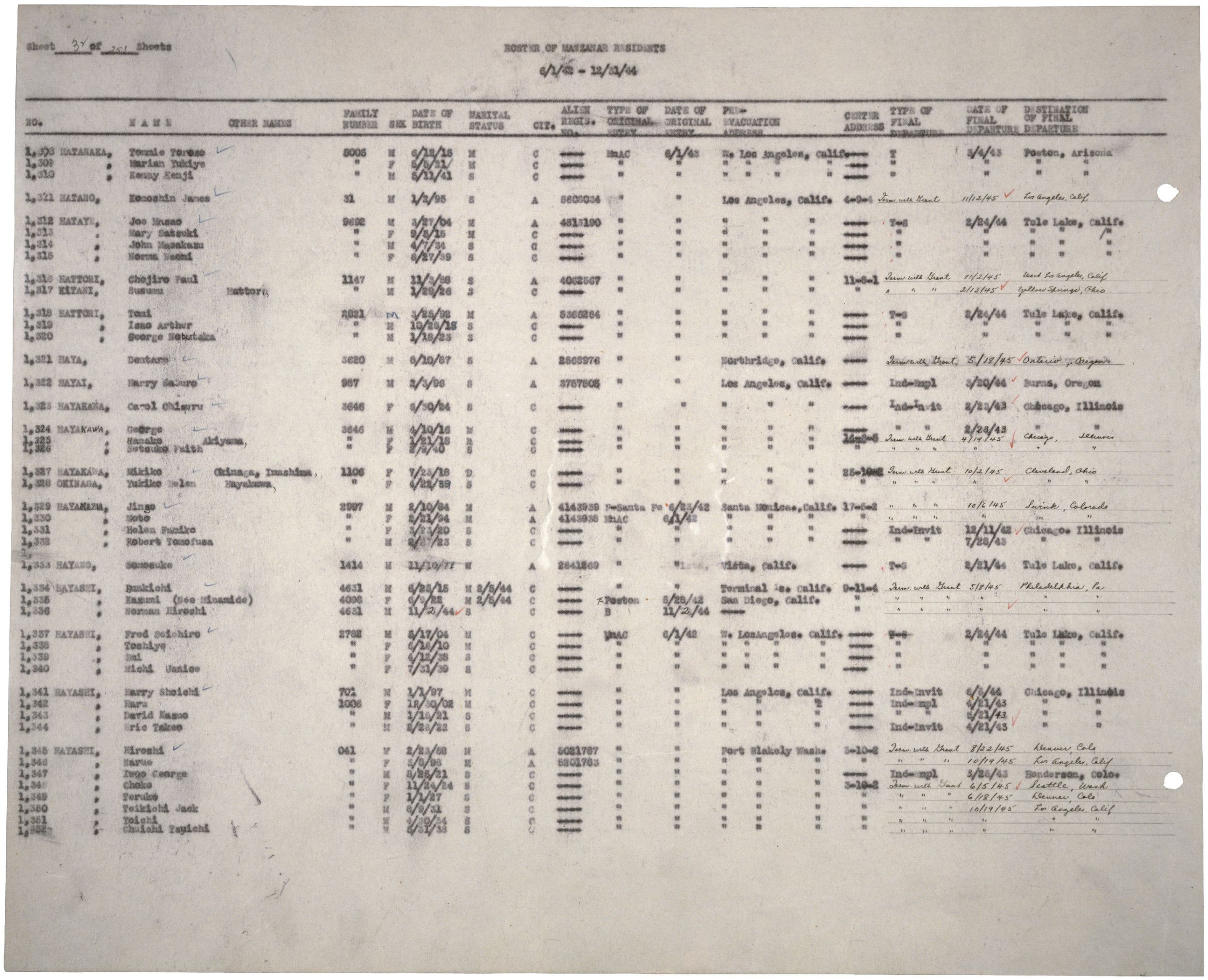
Document
Florin, California. Two of the nine American soldiers of Japanese ancestry who have returned to the...
5/10/1942
The full caption for this photograph reads: Florin, California. Two of the nine American soldiers of Japanese ancestry who have returned to their home town on furloughs that were granted to them in order that they could assist their families prepare for evacuation of all persons of Japanese ancestry from their west coast homes. This community is depending on their returned service men for many errands, shopping, banking, etc., because the soldiers are permitted to travel into town, nine miles away, while others cannot because of military restrictions.
This primary source comes from the Records of the War Relocation Authority.
National Archives Identifier: 537855
Full Citation: Florin, California. Two of the nine American soldiers of Japanese ancestry who have returned to the...; 5/10/1942; Records of the War Relocation Authority, . [Online Version, https://www.docsteach.org/documents/document/florin-california-two-of-the-nine-american-soldiers-of-japanese-ancestry-who-have-returned-to-the, April 25, 2024]Florin, California. Two of the nine American soldiers of Japanese ancestry who have returned to the...
Page 1

Document
Hayward, California. Two children of the Mochida family who, with their parents, are awaiting evacuation bus.
5/8/1942
In March 1942, under the authority of President Franklin D. Roosevelt's Executive Order 9066, the U.S. Army began the forced evacuation and detention of West Coast residents of Japanese-American ancestry. From the end of March to August, approximately 112,000 persons were sent to "assembly centers" – often racetracks or fairgrounds – where they waited and were tagged to indicate the location of a long-term "relocation center" that would be their home for the rest of the war. Nearly 70,000 of the evacuees were American citizens. There were no charges of disloyalty against any of these citizens, nor was there any vehicle by which they could appeal their loss of property and personal liberty.
The original caption for this photograph, taken by photographer Dorothea Lange for the War Relocation Authority, reads: "Hayward, California. Two children of the Mochida family who, with their parents, are awaiting evacuation bus. The youngster on the right holds a sandwich given her by one of a group of women who were present from a local Church. The family unit is kept intact during evacuation and at War Relocation Authority centers where evacuees of Japanese ancestry will be housed for the duration."
The original caption for this photograph, taken by photographer Dorothea Lange for the War Relocation Authority, reads: "Hayward, California. Two children of the Mochida family who, with their parents, are awaiting evacuation bus. The youngster on the right holds a sandwich given her by one of a group of women who were present from a local Church. The family unit is kept intact during evacuation and at War Relocation Authority centers where evacuees of Japanese ancestry will be housed for the duration."
This primary source comes from the Records of the War Relocation Authority.
National Archives Identifier: 537507
Full Citation: Photograph 210-G-C155; Hayward, California. Two children of the Mochida family who, with their parents, are awaiting evacuation bus.; 5/8/1942; Central Photographic File of the War Relocation Authority, 1942 - 1945; Records of the War Relocation Authority, ; National Archives at College Park, College Park, MD. [Online Version, https://www.docsteach.org/documents/document/mochida-children, April 25, 2024]Hayward, California. Two children of the Mochida family who, with their parents, are awaiting evacuation bus.
Page 1
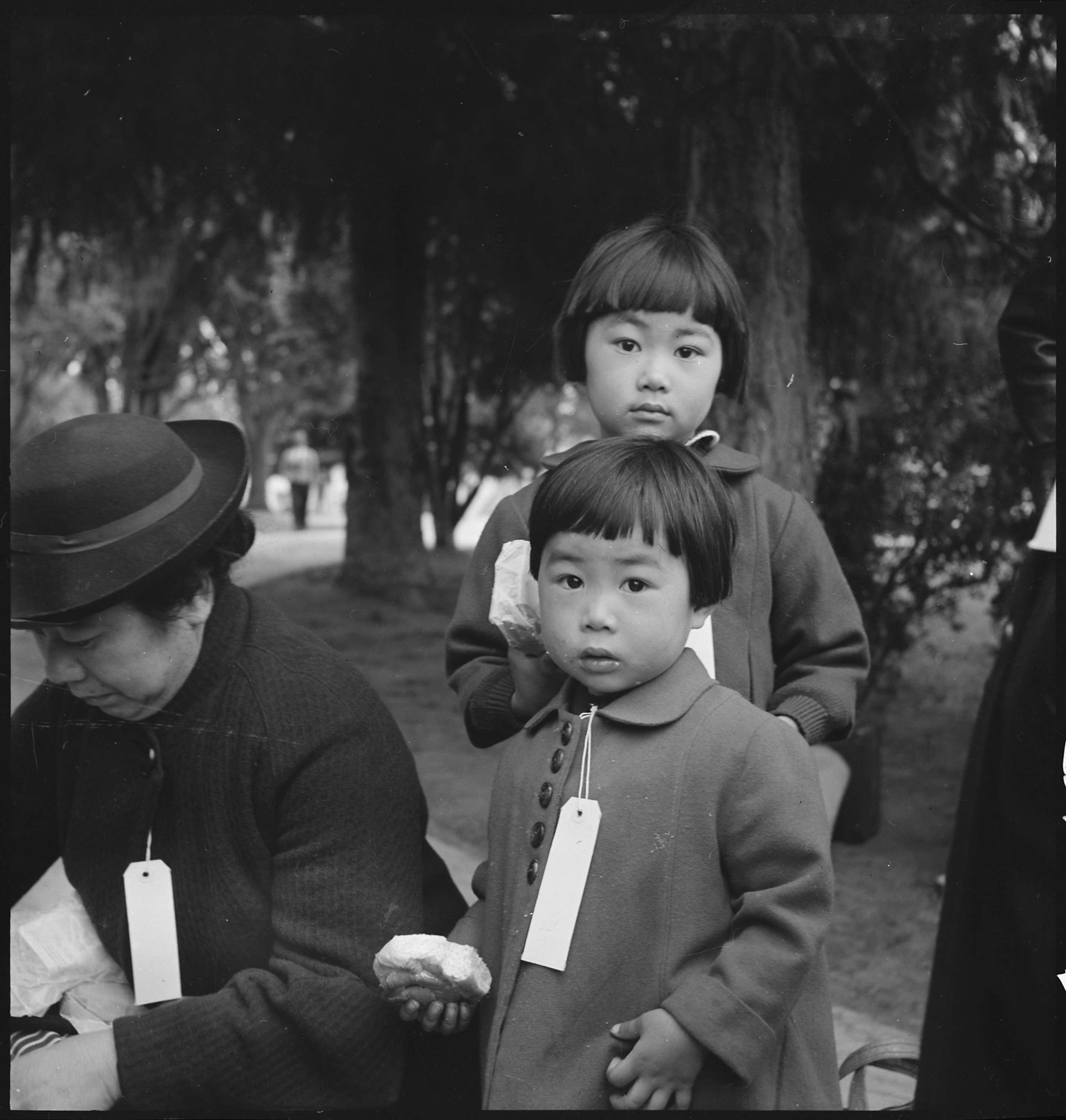
Document
Letter from George Katsumi Kodama to Seattle Draft Board
4/20/1944
This primary source comes from the Records of District Courts of the United States.
National Archives Identifier: 7820154
Full Citation: Letter from George Katsumi Kodama to Seattle Draft Board; 4/20/1944; Case File S-2984 [United States of America v. George Katsumi Kodama]; Criminal Case Files, 1891 - 1990; Records of District Courts of the United States, ; National Archives at Seattle, Seattle, WA. [Online Version, https://www.docsteach.org/documents/document/kodama-draft-board, April 25, 2024]Letter from George Katsumi Kodama to Seattle Draft Board
Page 1
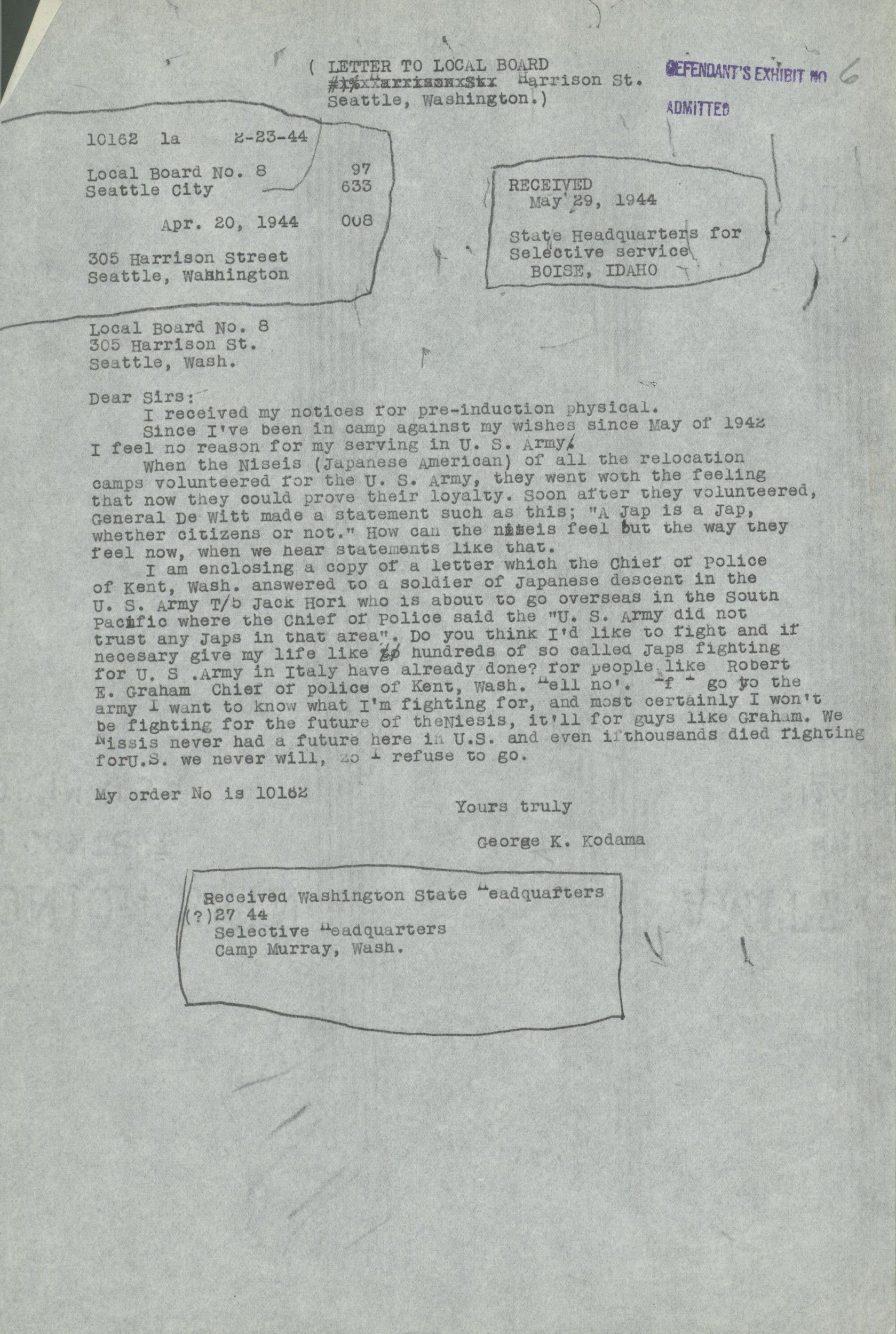
Document
Letter from Rocky Shimpo editor James Omura to former Heart Mountain internee Kiyoshi Okamoto, who had recently been moved to the internment camp at Tule Lake, California
4/10/1944
James Omura, the editor of Rocky Shimpo, a Japanese American newspaper, sent this letter to former Heart Mountain internee Kiyoshi Okamoto, who had recently been moved to the internment camp at Tule Lake, California.
The document was included in the case of the United States of America vs. Kiyoshi Okamoto, et. al. The prosecution of Okamoto, et. al. (Case #4930) stems directly from the Heart Mountain draft resistance movement that also resulted in the conviction of Shigeru Fujii and 62 others as documented in U.S. District Court Case #4928. Okamoto and his co-defendants, members of the so-called "Fair Play Committee," were indicted for conspiring to assist other Heart Mountain residents in their challenge to War Relocation Authority policies and the Selective Service Act as it applied to relocation camp internees.
The document was included in the case of the United States of America vs. Kiyoshi Okamoto, et. al. The prosecution of Okamoto, et. al. (Case #4930) stems directly from the Heart Mountain draft resistance movement that also resulted in the conviction of Shigeru Fujii and 62 others as documented in U.S. District Court Case #4928. Okamoto and his co-defendants, members of the so-called "Fair Play Committee," were indicted for conspiring to assist other Heart Mountain residents in their challenge to War Relocation Authority policies and the Selective Service Act as it applied to relocation camp internees.
This primary source comes from the Records of District Courts of the United States.
National Archives Identifier: 292815
Full Citation: Letter from Rocky Shimpo editor James Omura to former Heart Mountain internee Kiyoshi Okamoto, who had recently been moved to the internment camp at Tule Lake, California; 4/10/1944; United States of America vs. Kiyoshi Okamoto, et. al.; Criminal Case Files, 1890 - 1949; Records of District Courts of the United States, ; National Archives at Denver, Broomfield, CO. [Online Version, https://www.docsteach.org/documents/document/omura-okamoto, April 25, 2024]Letter from Rocky Shimpo editor James Omura to former Heart Mountain internee Kiyoshi Okamoto, who had recently been moved to the internment camp at Tule Lake, California
Page 1
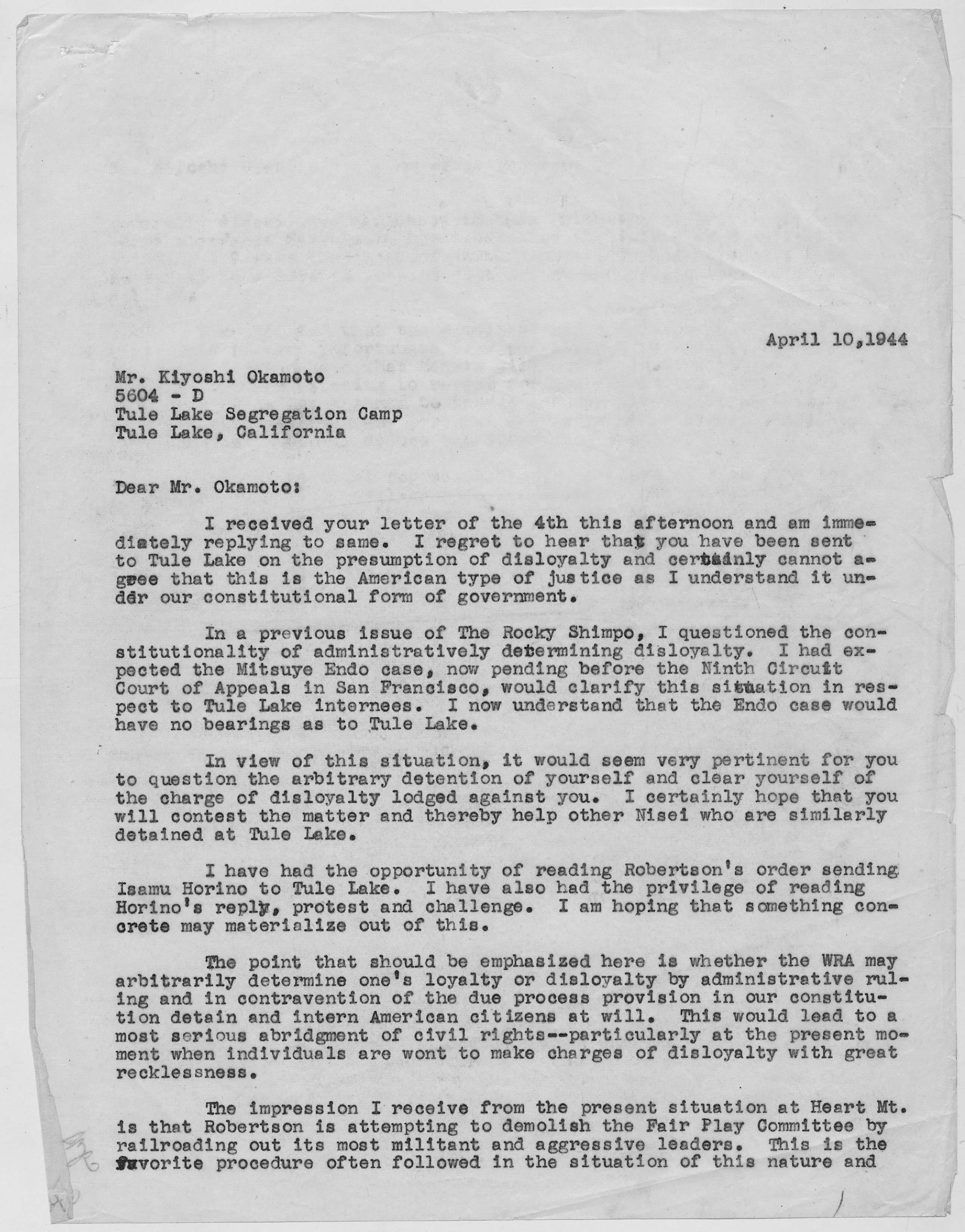
Letter from Rocky Shimpo editor James Omura to former Heart Mountain internee Kiyoshi Okamoto, who had recently been moved to the internment camp at Tule Lake, California
Page 2

Letter from Rocky Shimpo editor James Omura to former Heart Mountain internee Kiyoshi Okamoto, who had recently been moved to the internment camp at Tule Lake, California
Page 3
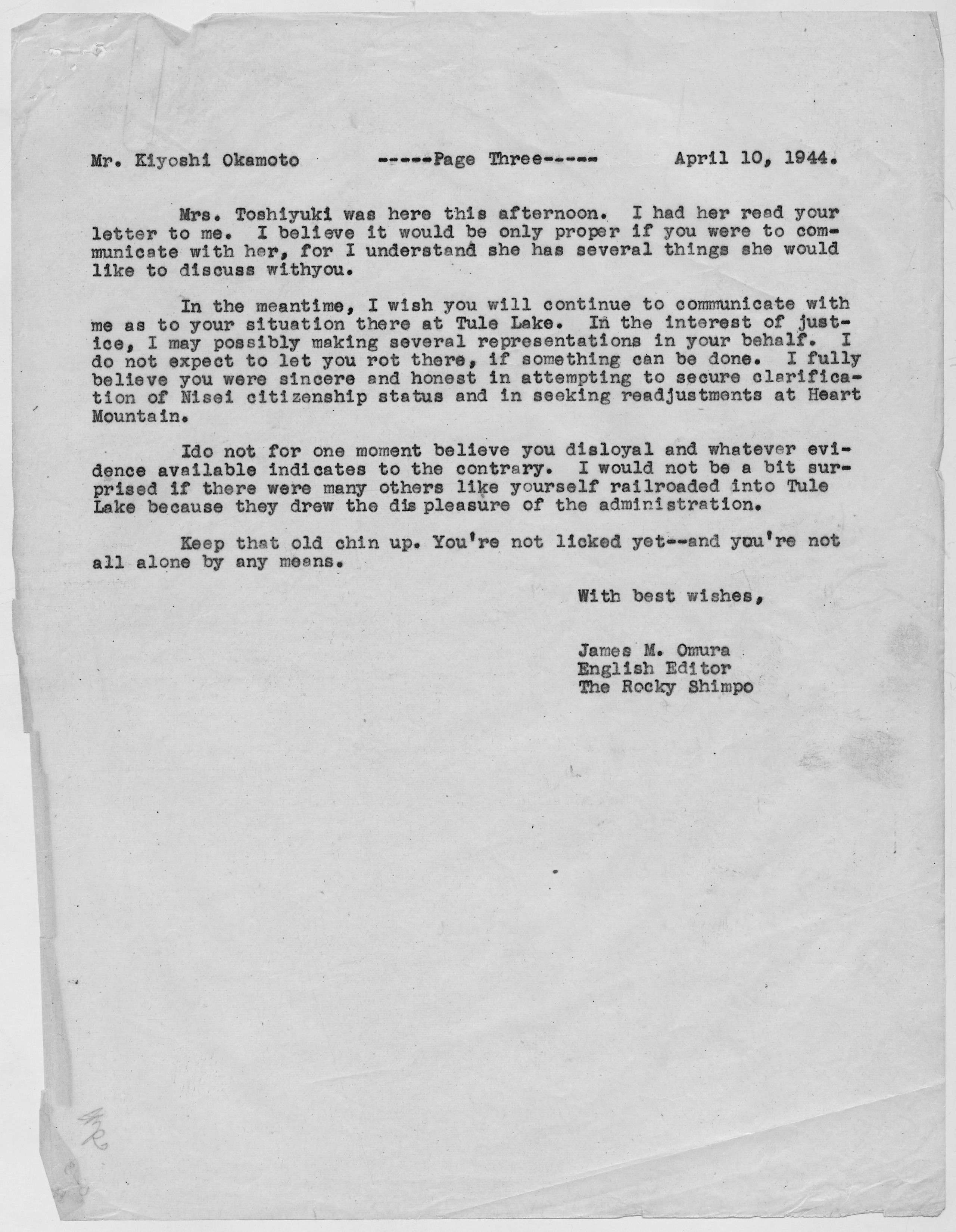
Document
Letter from Rocky Shimpo editor James Omura to former Heart Mountain internee Kiyoshi Okamoto, who had recently been moved to the internment camp at Tule Lake, California
4/10/1944
James Omura, the editor of Rocky Shimpo, a Japanese American newspaper, sent this letter to former Heart Mountain internee Kiyoshi Okamoto, who had recently been moved to the internment camp at Tule Lake, California.
The document was included in the case of the United States of America vs. Kiyoshi Okamoto, et. al. The prosecution of Okamoto, et. al. (Case #4930) stems directly from the Heart Mountain draft resistance movement that also resulted in the conviction of Shigeru Fujii and 62 others as documented in U.S. District Court Case #4928. Okamoto and his co-defendants, members of the so-called "Fair Play Committee," were indicted for conspiring to assist other Heart Mountain residents in their challenge to War Relocation Authority policies and the Selective Service Act as it applied to relocation camp internees.
The document was included in the case of the United States of America vs. Kiyoshi Okamoto, et. al. The prosecution of Okamoto, et. al. (Case #4930) stems directly from the Heart Mountain draft resistance movement that also resulted in the conviction of Shigeru Fujii and 62 others as documented in U.S. District Court Case #4928. Okamoto and his co-defendants, members of the so-called "Fair Play Committee," were indicted for conspiring to assist other Heart Mountain residents in their challenge to War Relocation Authority policies and the Selective Service Act as it applied to relocation camp internees.
This primary source comes from the Records of District Courts of the United States.
National Archives Identifier: 292815
Full Citation: Letter from Rocky Shimpo editor James Omura to former Heart Mountain internee Kiyoshi Okamoto, who had recently been moved to the internment camp at Tule Lake, California; 4/10/1944; United States of America vs. Kiyoshi Okamoto, et. al.; Criminal Case Files, 1890 - 1949; Records of District Courts of the United States, ; National Archives at Denver, Broomfield, CO. [Online Version, https://www.docsteach.org/documents/document/omura-okamoto, April 25, 2024]Letter from Rocky Shimpo editor James Omura to former Heart Mountain internee Kiyoshi Okamoto, who had recently been moved to the internment camp at Tule Lake, California
Page 1

Letter from Rocky Shimpo editor James Omura to former Heart Mountain internee Kiyoshi Okamoto, who had recently been moved to the internment camp at Tule Lake, California
Page 2

Letter from Rocky Shimpo editor James Omura to former Heart Mountain internee Kiyoshi Okamoto, who had recently been moved to the internment camp at Tule Lake, California
Page 3

Document
Letter from Rocky Shimpo editor James Omura to former Heart Mountain internee Kiyoshi Okamoto, who had recently been moved to the internment camp at Tule Lake, California
4/10/1944
James Omura, the editor of Rocky Shimpo, a Japanese American newspaper, sent this letter to former Heart Mountain internee Kiyoshi Okamoto, who had recently been moved to the internment camp at Tule Lake, California.
The document was included in the case of the United States of America vs. Kiyoshi Okamoto, et. al. The prosecution of Okamoto, et. al. (Case #4930) stems directly from the Heart Mountain draft resistance movement that also resulted in the conviction of Shigeru Fujii and 62 others as documented in U.S. District Court Case #4928. Okamoto and his co-defendants, members of the so-called "Fair Play Committee," were indicted for conspiring to assist other Heart Mountain residents in their challenge to War Relocation Authority policies and the Selective Service Act as it applied to relocation camp internees.
The document was included in the case of the United States of America vs. Kiyoshi Okamoto, et. al. The prosecution of Okamoto, et. al. (Case #4930) stems directly from the Heart Mountain draft resistance movement that also resulted in the conviction of Shigeru Fujii and 62 others as documented in U.S. District Court Case #4928. Okamoto and his co-defendants, members of the so-called "Fair Play Committee," were indicted for conspiring to assist other Heart Mountain residents in their challenge to War Relocation Authority policies and the Selective Service Act as it applied to relocation camp internees.
This primary source comes from the Records of District Courts of the United States.
National Archives Identifier: 292815
Full Citation: Letter from Rocky Shimpo editor James Omura to former Heart Mountain internee Kiyoshi Okamoto, who had recently been moved to the internment camp at Tule Lake, California; 4/10/1944; United States of America vs. Kiyoshi Okamoto, et. al.; Criminal Case Files, 1890 - 1949; Records of District Courts of the United States, ; National Archives at Denver, Broomfield, CO. [Online Version, https://www.docsteach.org/documents/document/omura-okamoto, April 25, 2024]Letter from Rocky Shimpo editor James Omura to former Heart Mountain internee Kiyoshi Okamoto, who had recently been moved to the internment camp at Tule Lake, California
Page 1

Letter from Rocky Shimpo editor James Omura to former Heart Mountain internee Kiyoshi Okamoto, who had recently been moved to the internment camp at Tule Lake, California
Page 2

Letter from Rocky Shimpo editor James Omura to former Heart Mountain internee Kiyoshi Okamoto, who had recently been moved to the internment camp at Tule Lake, California
Page 3

Document
Los Angeles, California. Mr. and Mrs. K. Tseri have closed their drugstore
4/11/1942
The original caption for this photograph reads: Los Angeles, California. Mr. and Mrs. K. Iseri have closed their drugstore in preparation for the forthcoming evacuation from their "Little Tokyo" in Los Angeles.
Transcript
[sign in window:]Many thanks for your patronage. Hope to serve you in near future. God be with you till we meet again.
Mr. and Mrs. K. Iseri
[written on photograph:]
Iseri Pharmacy
4-11-42 - Los Angeles "Little Tokyo" Closed -
This primary source comes from the Records of the War Relocation Authority.
National Archives Identifier: 536001
Full Citation: Photograph 210-G-A1; Los Angeles, California. Mr. and Mrs. K. Tseri have closed their drugstore; 4/11/1942; Central Photographic File of the War Relocation Authority, 1942 - 1945; Records of the War Relocation Authority, ; National Archives at College Park, College Park, MD. [Online Version, https://www.docsteach.org/documents/document/iseri-drugstore, April 25, 2024]Los Angeles, California. Mr. and Mrs. K. Tseri have closed their drugstore
Page 1
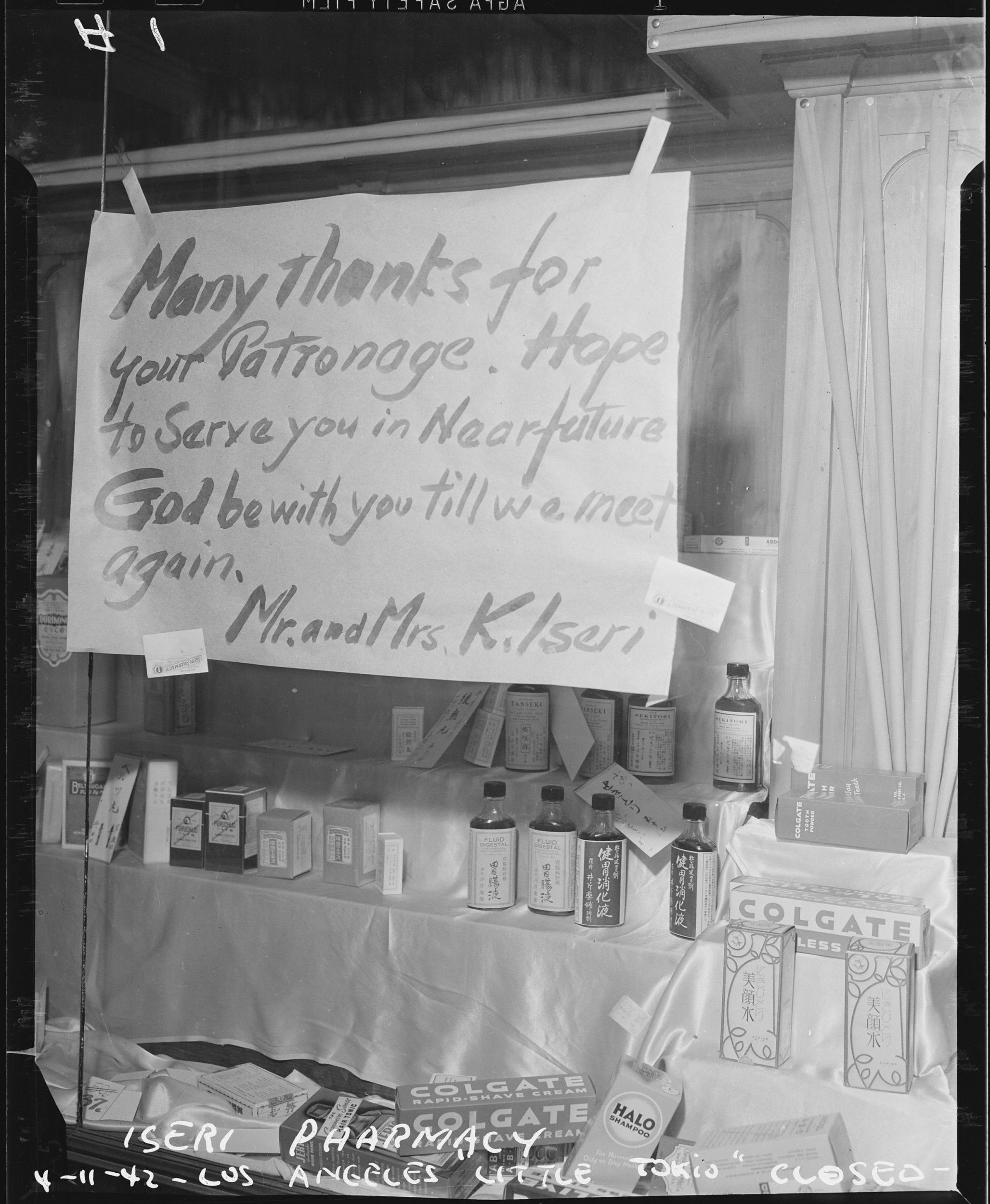
Document
Manzanar Free Press for Wednesday, Aug. 12, 1942
8/12/1942
This document was digitized by teachers in our Primarily Teaching 2013 Summer Workshop in Washington, DC.
This primary source comes from the Records of the War Relocation Authority.
National Archives Identifier: 7542774
Full Citation: Manzanar Free Press for Wednesday, Aug. 12, 1942; 8/12/1942; Manzanar Publications, 4/11/1942 - 10/19/1945; Records of the War Relocation Authority, ; National Archives Building, Washington, D.C.. [Online Version, https://www.docsteach.org/documents/document/manzanar-free-press, April 25, 2024]Manzanar Free Press for Wednesday, Aug. 12, 1942
Page 1

Manzanar Free Press for Wednesday, Aug. 12, 1942
Page 2
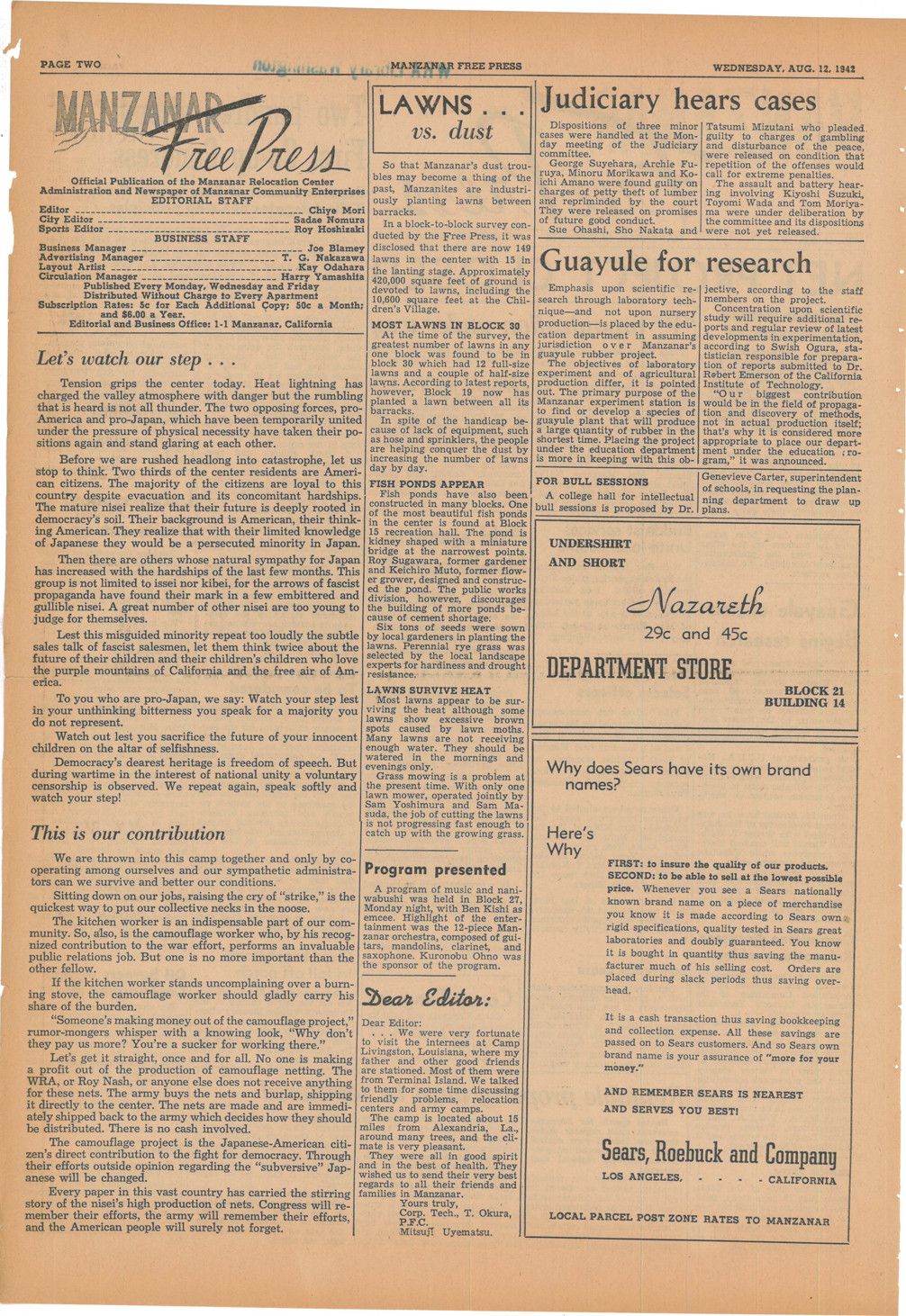
Manzanar Free Press for Wednesday, Aug. 12, 1942
Page 3

Manzanar Free Press for Wednesday, Aug. 12, 1942
Page 4
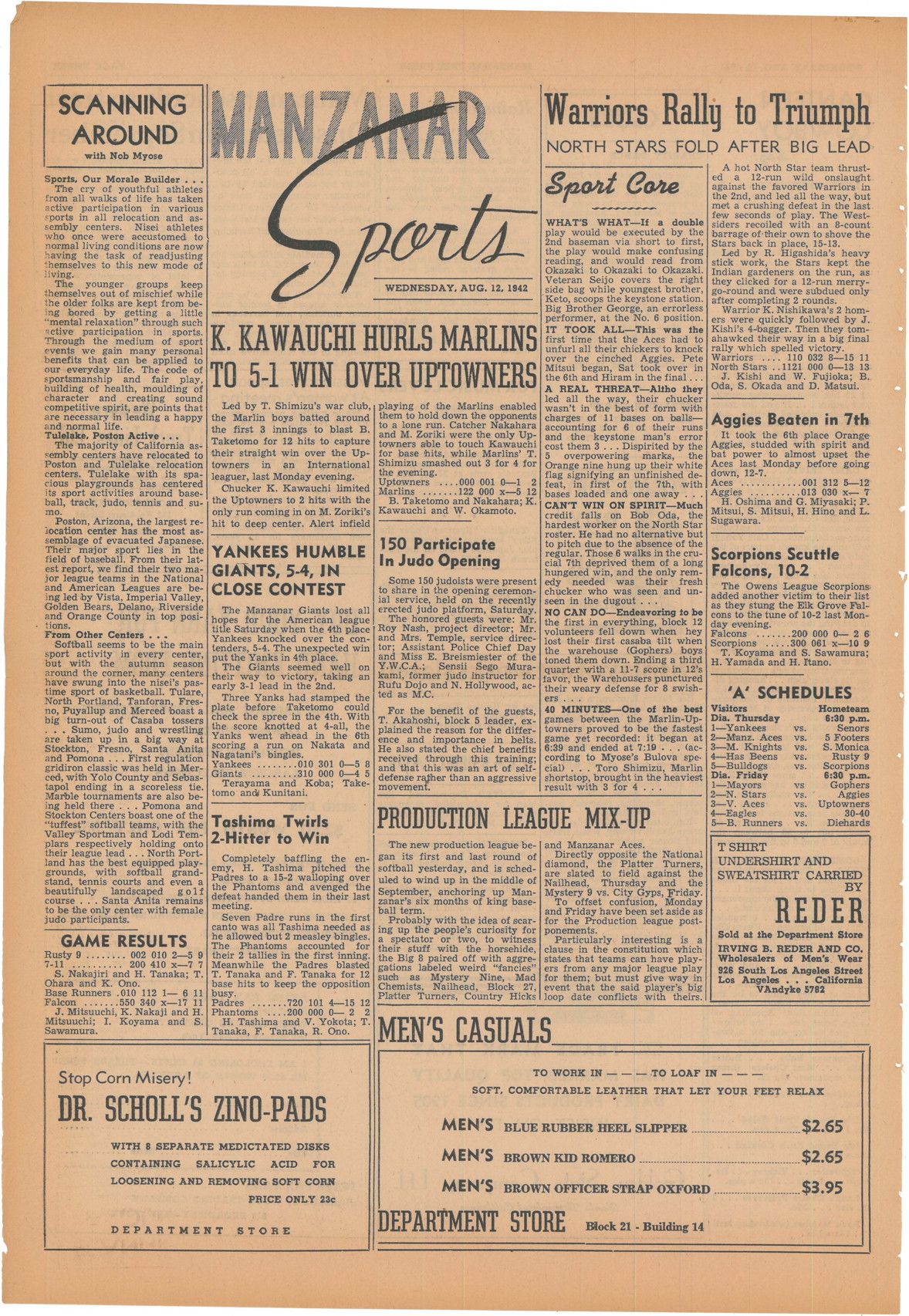
Document
Manzanar Relocation Center, Manzanar, California. Baseball is the most popular recreation at this War Relocation Authority center...
7/02/1942
The original caption for this photograph, taken by photographer Dorothea Lange for the War Relocation Authority, reads: "Baseball is the most popular recreation at this War Relocation Authority center with 80 teams having been formed throughout the Center. Most of the playing is done between the barrack blocks."
This primary source comes from the Records of the War Relocation Authority.
National Archives Identifier: 538064
Full Citation: Photograph 210-G-C771; Manzanar Relocation Center, Manzanar, California. Baseball is the most popular recreation at this War Relocation Authority center...; 7/02/1942; Central Photographic File of the War Relocation Authority, 1942 - 1945; Records of the War Relocation Authority, ; National Archives at College Park, College Park, MD. [Online Version, https://www.docsteach.org/documents/document/baseball-manzanar, April 25, 2024]Manzanar Relocation Center, Manzanar, California. Baseball is the most popular recreation at this War Relocation Authority center...
Page 1
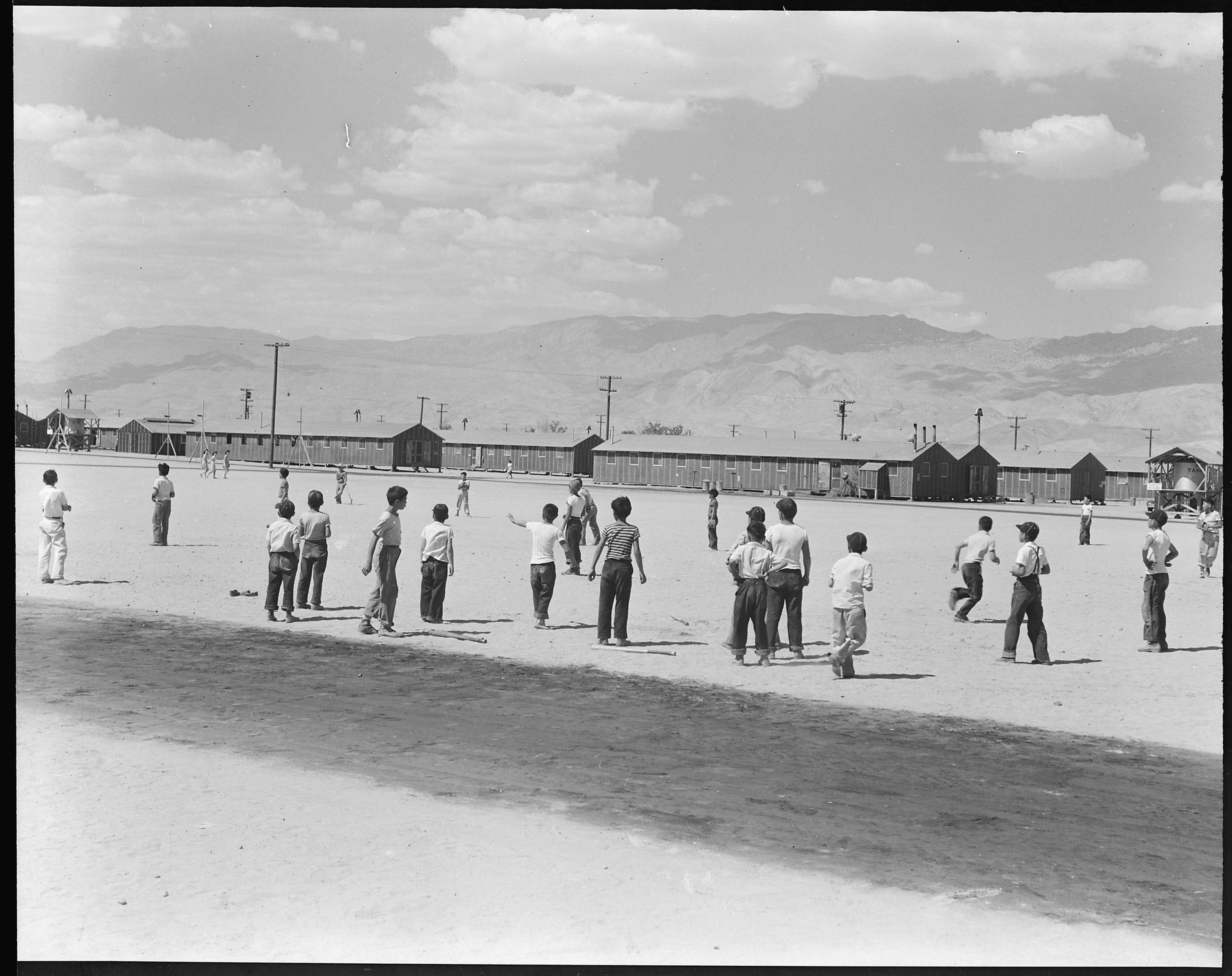
Document
Newspaper article from Rocky Shimpo: 'Camp Disturbance Pending'
3/20/1944
This article was was published in the Japanese American newspaper Rocky Shimpo. It was included in the case of the United States of America vs. Kiyoshi Okamoto, et. al.
The prosecution of Okamoto, et. al. (Case #4930) stems directly from the Heart Mountain draft resistance movement that also resulted in the conviction of Shigeru Fujii and 62 others as documented in U.S. District Court Case #4928. Okamoto and his co-defendants, members of the so-called "Fair Play Committee," were indicted for conspiring to assist other Heart Mountain residents in their challenge to War Relocation Authority policies and the Selective Service Act as it applied to relocation camp internees.
The prosecution of Okamoto, et. al. (Case #4930) stems directly from the Heart Mountain draft resistance movement that also resulted in the conviction of Shigeru Fujii and 62 others as documented in U.S. District Court Case #4928. Okamoto and his co-defendants, members of the so-called "Fair Play Committee," were indicted for conspiring to assist other Heart Mountain residents in their challenge to War Relocation Authority policies and the Selective Service Act as it applied to relocation camp internees.
This primary source comes from the Records of District Courts of the United States.
National Archives Identifier: 292813
Full Citation: Newspaper article from Rocky Shimpo: 'Camp Disturbance Pending'; 3/20/1944; United States of America vs. Kiyoshi Okamoto, et. al.; Criminal Case Files, 1890 - 1949; Records of District Courts of the United States, ; National Archives at Denver, Broomfield, CO. [Online Version, https://www.docsteach.org/documents/document/rocky-shimpo-camp-disturbance-pending, April 25, 2024]Newspaper article from Rocky Shimpo: 'Camp Disturbance Pending'
Page 1

Document
Order of Judgment and Sentence
10/21/1942
In 1942, Gordon Hirabayashi, a Japanese American student at the University of Washington, refused to report to a relocation camp. His refusal defied Executive Order 9066 evacuating Japanese Americans from the West Coast. This document is the judgment and sentence handed down in the case United States v. Gordon Hirabayashi, and records the outcome of Hirabayashi’s first trial. The U.S. District Court ruled 9-0 against him. Forty years later, Hirabayashi challenged his 1942 conviction. The court overturned the earlier verdict.
This primary source comes from the Records of District Courts of the United States.
National Archives Identifier: 596076
Full Citation: Order of Judgment and Sentence; 10/21/1942; Criminal Case File 45,738; Criminal Case Files, 1926 - 2000; Records of District Courts of the United States, ; National Archives at Seattle, Seattle, WA. [Online Version, https://www.docsteach.org/documents/document/judgment-us-v-hirabayashi, April 25, 2024]Order of Judgment and Sentence
Page 1

Order of Judgment and Sentence
Page 2
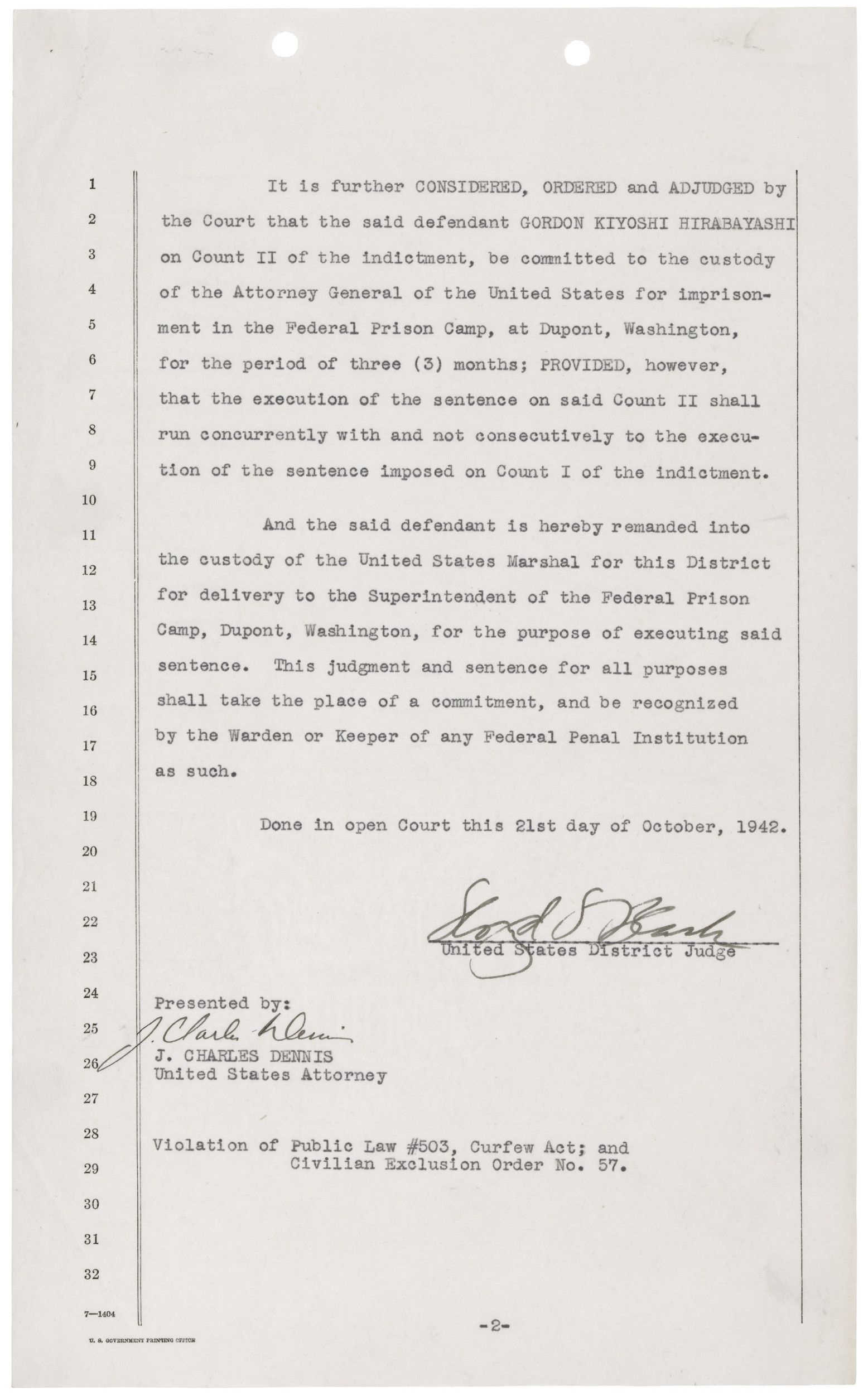
Document
Order of Judgment and Sentence
10/21/1942
In 1942, Gordon Hirabayashi, a Japanese American student at the University of Washington, refused to report to a relocation camp. His refusal defied Executive Order 9066 evacuating Japanese Americans from the West Coast. This document is the judgment and sentence handed down in the case United States v. Gordon Hirabayashi, and records the outcome of Hirabayashi’s first trial. The U.S. District Court ruled 9-0 against him. Forty years later, Hirabayashi challenged his 1942 conviction. The court overturned the earlier verdict.
This primary source comes from the Records of District Courts of the United States.
National Archives Identifier: 596076
Full Citation: Order of Judgment and Sentence; 10/21/1942; Criminal Case File 45,738; Criminal Case Files, 1926 - 2000; Records of District Courts of the United States, ; National Archives at Seattle, Seattle, WA. [Online Version, https://www.docsteach.org/documents/document/judgment-us-v-hirabayashi, April 25, 2024]Order of Judgment and Sentence
Page 1

Order of Judgment and Sentence
Page 2

Document
Members of the Mochida Family Awaiting Evacuation
5/8/1942
The original caption for this photograph reads: Hayward, California. Members of the Mochida family awaiting evacuation bus. Identification tags are used to aid in keeping the family unit intact during all phases of evacuation. Mochida operated a nursery and five greenhouses on a two-acre site in Eden Township. He raised snapdragons and sweet peas. Evacuees of Japanese ancestry will be housed in War Relocation Authority centers for the duration.
This primary source comes from the Records of the War Relocation Authority.
National Archives Identifier: 537505
Full Citation: Photograph 210-GC-153; Members of the Mochida Family Awaiting Evacuation; 5/8/1942; Central Photographic File of the War Relocation Authority, 1942 - 1945; Records of the War Relocation Authority, ; National Archives at College Park, College Park, MD. [Online Version, https://www.docsteach.org/documents/document/mochida-family, April 25, 2024]Members of the Mochida Family Awaiting Evacuation
Page 1

Document
Relocating a People
ca. 2/1943
This item is a brochure that explains the wartime relocation of Japanese-Americans and Japanese aliens, and that encourages the employment of relocated individuals.
This primary source comes from the Records of the Bureau of Indian Affairs.
National Archives Identifier: 2641502
Full Citation: Relocating a People; ca. 2/1943; Japanese Settlement; Records of R. H. Rupkey, Project Engineer, 12/1/1938 - 3/31/1945; Records of the Bureau of Indian Affairs, ; National Archives at Riverside, Perris, CA. [Online Version, https://www.docsteach.org/documents/document/relocating-a-people, April 25, 2024]Relocating a People
Page 1

Document
San Francisco, California. Flag of allegiance pledge at Raphael Weill Public School
4/20/1942
The original caption for this photograph, taken by photographer Dorothea Lange, reads: San Francisco, California. Flag of allegiance pledge at Raphael Weill Public School, Geary and Buchanan Streets. Children in families of Japanese ancestry were evacuated with their parents and will be housed for the duration in War Relocation Authority centers where facilities will be provided for them to continue their education.
This primary source comes from the Records of the War Relocation Authority.
National Archives Identifier: 536053
Full Citation: Photograph 210-G-A78; San Francisco, California. Flag of allegiance pledge at Raphael Weill Public School; 4/20/1942; Central Photographic File of the War Relocation Authority, 1942 - 1945; Records of the War Relocation Authority, ; National Archives at College Park, College Park, MD. [Online Version, https://www.docsteach.org/documents/document/pledge-of-allegiance-weill-school, April 25, 2024]San Francisco, California. Flag of allegiance pledge at Raphael Weill Public School
Page 1

Document
San Francisco, California. This restaurant, named 'Nisei' after second- generation children born in this country to Japanese immigrants was closed prior to evacuation of residents of Japanese ancestry
4/7/1942
The original caption for this photograph reads: San Francisco, California. This restaurant, named "Nisei" after second- generation children born in this country to Japanese immigrants was closed prior to evacuation of residents of Japanese ancestry; and, according to sign in the window, was scheduled to re- open under new management. Evacuees will be housed at War Relocation Authority centers for [the] duration.
This primary source comes from the Records of the War Relocation Authority.
National Archives Identifier: 536045
Full Citation: Photograph 210-G-A68; San Francisco, California. This restaurant, named 'Nisei' after second- generation children born in this country to Japanese immigrants was closed prior to evacuation of residents of Japanese ancestry; 4/7/1942; Central Photographic File of the War Relocation Authority, 1942 - 1945; Records of the War Relocation Authority, ; National Archives at College Park, College Park, MD. [Online Version, https://www.docsteach.org/documents/document/nisei-grill, April 25, 2024]San Francisco, California. This restaurant, named 'Nisei' after second- generation children born in this country to Japanese immigrants was closed prior to evacuation of residents of Japanese ancestry
Page 2
